Microsoft RM-485X GSM/WCDMA cellular phone w/BT, WLAN and FMTx User Manual Manual
Microsoft Mobile Oy GSM/WCDMA cellular phone w/BT, WLAN and FMTx Manual
Manual

Nokia N86 8MP User Guide
5555555
Issue 1
Cyan
Cyan
Magenta
Magenta
Yellow
Yellow
Black
Black
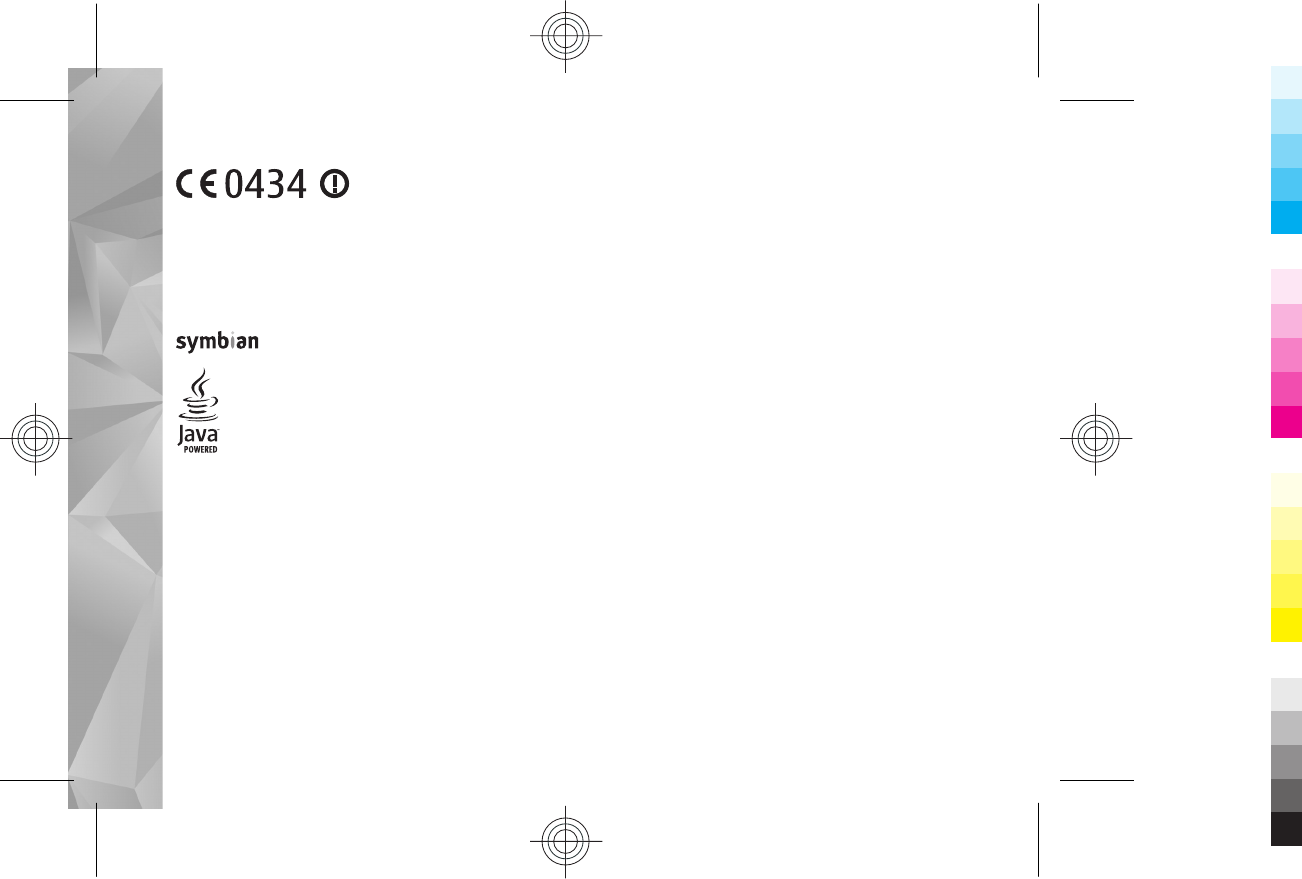
© 2009 Nokia. All rights reserved.
DECLARATION OF CONFORMITY
Hereby, NOKIA CORPORATION declares that this RM-485 product is in compliance with the essential requirements and other
relevant provisions of Directive 1999/5/EC. A copy of the Declaration of Conformity can be found at www.nokia.com/phones/
declaration_of_conformity/.
Nokia, Nokia Connecting People, Nseries, N86, N-Gage, Nokia Original Accessories logo, and Ovi are trademarks or registered trademarks of Nokia Corporation.
Nokia tune is a sound mark of Nokia Corporation. Other product and company names mentioned herein may be trademarks or tradenames of their respective
owners.
Reproduction, transfer, distribution, or storage of part or all of the contents in this document in any form without the prior written permission of Nokia is
prohibited. Nokia operates a policy of continuous development. Nokia reserves the right to make changes and improvements to any of the products described
in this document without prior notice.
This product includes software licensed from Symbian Software Ltd ©1998-2009. Symbian and Symbian OS are trademarks of Symbian Ltd.
Java and all Java-based marks are trademarks or registered trademarks of Sun Microsystems, Inc.
Portions of the Nokia Maps software are ©1996-2009 The FreeType Project. All rights reserved.
This product is licensed under the MPEG-4 Visual Patent Portfolio License (i) for personal and noncommercial use in connection with information which has
been encoded in compliance with the MPEG-4 Visual Standard by a consumer engaged in a personal and noncommercial activity and (ii) for use in connection
with MPEG-4 video provided by a licensed video provider. No license is granted or shall be implied for any other use. Additional information, including that
related to promotional, internal, and commercial uses, may be obtained from MPEG LA, LLC. See http://www.mpegla.com.
TO THE MAXIMUM EXTENT PERMITTED BY APPLICABLE LAW, UNDER NO CIRCUMSTANCES SHALL NOKIA OR ANY OF ITS LICENSORS BE RESPONSIBLE FOR ANY LOSS OF
DATA OR INCOME OR ANY SPECIAL, INCIDENTAL, CONSEQUENTIAL OR INDIRECT DAMAGES HOWSOEVER CAUSED.
The third-party applications provided with your device may have been created and may be owned by persons or entities not affiliated with or related to Nokia.
Nokia does not own the copyrights or intellectual property rights to the third-party applications. As such, Nokia does not take any responsibility for end-user
support, functionality of the applications, or the information in the applications or these materials. Nokia does not provide any warranty for the third-party
applications.
BY USING THE APPLICATIONS YOU ACKNOWLEDGE THAT THE APPLICATIONS ARE PROVIDED AS IS WITHOUT WARRANTY OF ANY KIND, EXPRESS OR IMPLIED, TO THE
MAXIMUM EXTENT PERMITTED BY APPLICABLE LAW. YOU FURTHER ACKNOWLEDGE THAT NEITHER NOKIA NOR ITS AFFILIATES MAKE ANY REPRESENTATIONS OR
WARRANTIES, EXPRESS OR IMPLIED, INCLUDING BUT NOT LIMITED TO WARRANTIES OF TITLE, MERCHANTABILITY OR FITNESS FOR A PARTICULAR PURPOSE, OR THAT
THE APPLICATIONS WILL NOT INFRINGE ANY THIRD-PARTY PATENTS, COPYRIGHTS, TRADEMARKS, OR OTHER RIGHTS.
Cyan
Cyan
Magenta
Magenta
Yellow
Yellow
Black
Black

THE CONTENTS OF THIS DOCUMENT ARE PROVIDED "AS IS". EXCEPT AS REQUIRED BY APPLICABLE LAW, NO WARRANTIES OF ANY KIND, EITHER EXPRESS OR IMPLIED,
INCLUDING, BUT NOT LIMITED TO, THE IMPLIED WARRANTIES OF MERCHANTABILITY AND FITNESS FOR A PARTICULAR PURPOSE, ARE MADE IN RELATION TO THE ACCURACY,
RELIABILITY OR CONTENTS OF THIS DOCUMENT. NOKIA RESERVES THE RIGHT TO REVISE THIS DOCUMENT OR WITHDRAW IT AT ANY TIME WITHOUT PRIOR NOTICE.
Reverse engineering of software in the device is prohibited to the extent permitted by applicable law. Insofar as this user guide contains any limitations on
Nokia's representations, warranties, damages and liabilities, such limitations shall likewise limit any representations, warranties, damages and liabilities of
Nokia's licensors.
The availability of particular products and applications and services for these products may vary by region. Please check with your Nokia dealer for details and
availability of language options. This device may contain commodities, technology or software subject to export laws and regulations from the US and other
countries. Diversion contrary to law is prohibited.
The availability of some features may vary by region. Please contact your operator for more details.
FCC/INDUSTRY CANADA NOTICE
Your device may cause TV or radio interference (for example, when using a telephone in close proximity to receiving equipment). The FCC or Industry Canada
can require you to stop using your telephone if such interference cannot be eliminated. If you require assistance, contact your local service facility. This device
complies with part 15 of the FCC rules. Operation is subject to the following two conditions: (1) This device may not cause harmful interference, and (2) this
device must accept any interference received, including interference that may cause undesired operation. Any changes or modifications not expressly approved
by Nokia could void the user's authority to operate this equipment.
5555555/Issue 1 EN
Cyan
Cyan
Magenta
Magenta
Yellow
Yellow
Black
Black

Contents
Safety................................................................6
About your device.................................................................6
Network services...................................................................7
Shared memory.....................................................................8
ActiveSync..............................................................................8
Magnets and magnetic fields...............................................8
Get started........................................................9
Keys and parts (front and top)............................................9
Keys and parts (back and sides)........................................10
Short slide keys...................................................................10
Kickstand.............................................................................10
Insert SIM card and battery ..............................................11
Memory card........................................................................11
Switch the device on and off.............................................12
Charge the battery..............................................................13
Headset................................................................................13
Attach wrist strap...............................................................14
Antenna locations...............................................................14
Find help.........................................................16
In-device help......................................................................16
Accessibility solutions........................................................16
Support................................................................................16
Extended user guide...........................................................17
Additional applications......................................................17
Update device software.....................................................17
Settings................................................................................18
Your device.....................................................19
Transfer content.................................................................19
Lock the keypad..................................................................20
Offline profile......................................................................20
Camera............................................................21
About the camera...............................................................21
Activate the camera............................................................21
Image capture.....................................................................21
Video recording..................................................................25
Photos............................................................26
About Photos.......................................................................26
View images and videos....................................................26
Active toolbar......................................................................27
Connectivity....................................................28
Wi-Fi/WLAN connection ....................................................28
Bluetooth.............................................................................29
Browser..........................................................32
About Browser....................................................................32
Browse the web..................................................................32
Browser toolbar..................................................................33
Empty the cache..................................................................33
Music...............................................................34
FM radio...............................................................................34
Nokia Music Store...............................................................35
Music player.........................................................................35
FM transmitter.....................................................................36
Contents
Cyan
Cyan
Magenta
Magenta
Yellow
Yellow
Black
Black

Positioning (GPS)............................................38
About GPS............................................................................38
Assisted GPS (A-GPS)...........................................................38
Hold your device correctly.................................................39
Tips on creating a GPS connection....................................39
Nokia Maps.....................................................41
About Maps..........................................................................41
Network positioning..........................................................41
Compass...............................................................................42
Move on a map....................................................................42
Display indicators...............................................................43
Plan a route.........................................................................43
Traffic and safety................................................................44
Write and send messages..............................45
Make calls.......................................................47
Voice calls ...........................................................................47
Make a video call.................................................................47
Personalise your device.................................49
Set tones..............................................................................49
Modify the standby mode..................................................49
Modify the main menu.......................................................50
Green tips.......................................................51
Save energy.........................................................................51
Recycle.................................................................................51
Save paper...........................................................................51
Learn more..........................................................................51
Accessories.....................................................52
Battery............................................................53
Battery and charger information......................................53
Nokia battery authentication guidelines.........................54
Taking care of your device.............................55
Recycle.................................................................................55
Additional safety information.......................57
Small children.....................................................................57
Operating environment.....................................................57
Medical devices...................................................................57
Hearing aids........................................................................58
Vehicles................................................................................58
Potentially explosive environments.................................59
Emergency calls...................................................................59
Certification information (SAR).........................................60
Index..............................................................61
Contents
Cyan
Cyan
Magenta
Magenta
Yellow
Yellow
Black
Black
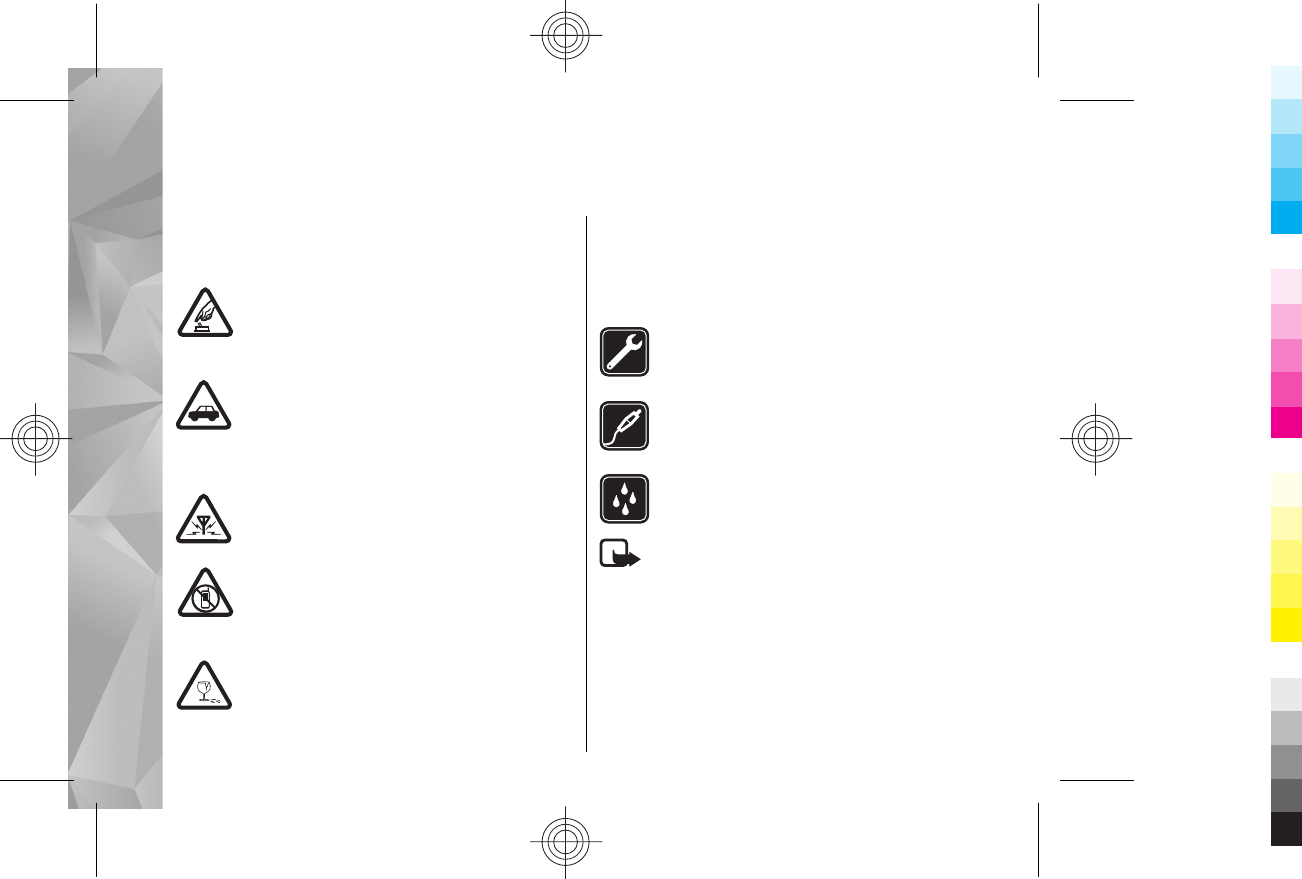
Safety
Read these simple guidelines. Not following them may
be dangerous or illegal. Read the complete user guide
for further information.
SWITCH ON SAFELY
Do not switch the device on when wireless
phone use is prohibited or when it may cause
interference or danger.
ROAD SAFETY COMES FIRST
Obey all local laws. Always keep your hands free
to operate the vehicle while driving. Your first
consideration while driving should be road
safety.
INTERFERENCE
All wireless devices may be susceptible to
interference, which could affect performance.
SWITCH OFF IN RESTRICTED AREAS
Follow any restrictions. Switch the device off in
aircraft, near medical equipment, fuel,
chemicals, or blasting areas.
GLASS PARTS
The front cover of the device is made of glass.
This glass can break if the device is dropped on
a hard surface or receives a substantial impact.
If the glass breaks, do not touch the glass parts
of the device or attempt to remove the broken
glass from the device. Stop using the device
until the glass is replaced by qualified service
personnel.
QUALIFIED SERVICE
Only qualified personnel may install or repair
this product.
ACCESSORIES AND BATTERIES
Use only approved accessories and batteries. Do
not connect incompatible products.
WATER-RESISTANCE
Your device is not water-resistant. Keep it dry.
Note: The surface of this device does not contain
nickel in the platings. The surface of this device contains
stainless steel.
About your device
The wireless device described in this guide is approved for
use on the (E)GSM 850, 900, 1800, 1900, and UMTS 850,
6
Safety
Cyan
Cyan
Magenta
Magenta
Yellow
Yellow
Black
Black

1900, 2100 networks. Contact your service provider for
more information about networks.
When using the features in this device, obey all laws and
respect local customs, privacy and legitimate rights of
others, including copyrights.
Copyright protection may prevent some images, music,
and other content from being copied, modified, or
transferred.
Your device supports several methods of connectivity. Like
computers, your device may be exposed to viruses and
other harmful content. Exercise caution with messages,
connectivity requests, browsing, and downloads. Only
install and use services and other software from
trustworthy sources that offer adequate security and
protection against harmful software, such as applications
that are Symbian Signed or have passed the Java Verified™
testing. Consider installing antivirus and other security
software on your device and any connected computer.
Important: Your device can only support one
antivirus application. Having more than one application
with antivirus functionality could affect performance and
operation or cause the device to stop functioning.
Your device may have preinstalled bookmarks and links for
third-party internet sites. You may also access other third-
party sites through your device. Third-party sites are not
affiliated with Nokia, and Nokia does not endorse or
assume liability for them. If you choose to access such
sites, you should take precautions for security or content.
Warning: To use any features in this device, other
than the alarm clock, the device must be switched on. Do
not switch the device on when wireless device use may
cause interference or danger.
Remember to make back-up copies or keep a written
record of all important information stored in your device.
When connecting to any other device, read its user guide
for detailed safety instructions. Do not connect
incompatible products.
The images in this guide may differ from your device
display.
Network services
To use the device you must have service from a wireless
service provider. Some features are not available on all
networks; other features may require that you make
specific arrangements with your service provider to use
them. Network services involve transmission of data.
Check with your service provider for details about fees in
your home network and when roaming on other
networks. Your service provider can explain what charges
will apply. Some networks may have limitations that affect
how you can use some features of this device requiring
network support such as support for specific technologies
like WAP 2.0 protocols (HTTP and SSL) that run on TCP/IP
protocols and language-dependent characters. 7
Safety
Cyan
Cyan
Magenta
Magenta
Yellow
Yellow
Black
Black

Your service provider may have requested that certain
features be disabled or not activated in your device. If so,
these features will not appear on your device menu. Your
device may also have customized items such as menu
names, menu order, and icons.
Shared memory
The following features in this device may share memory:
multimedia messaging (MMS), e-mail application, instant
messaging. Use of one or more of these features may
reduce the memory available for the remaining features.
If your device displays a message that the memory is full,
delete some of the information stored in the shared
memory.
During extended operation such as an active video call and
high speed data connection, the device may feel warm. In
most cases, this condition is normal. If you suspect the
device is not working properly, take it to the nearest
authorised service facility.
ActiveSync
Use of the Mail for Exchange is limited to over-the-air
synchronisation of PIM information between the Nokia
device and the authorised Microsoft Exchange server.
Digital rights management
Content owners may use different types of digital rights
management (DRM) technologies to protect their
intellectual property, including copyrights. This device
uses various types of DRM software to access DRM-
protected content. With this device you can access content
protected with WMDRM 10 and OMA DRM 2.0. If certain DRM
software fails to protect the content, content owners may
ask that such DRM software's ability to access new DRM-
protected content be revoked. Revocation may also
prevent renewal of such DRM-protected content already in
your device. Revocation of such DRM software does not
affect the use of content protected with other types of DRM
or the use of non-DRM-protected content.
Magnets and magnetic fields
Keep your device away from magnets or magnetic fields.
8
Safety
Cyan
Cyan
Magenta
Magenta
Yellow
Yellow
Black
Black
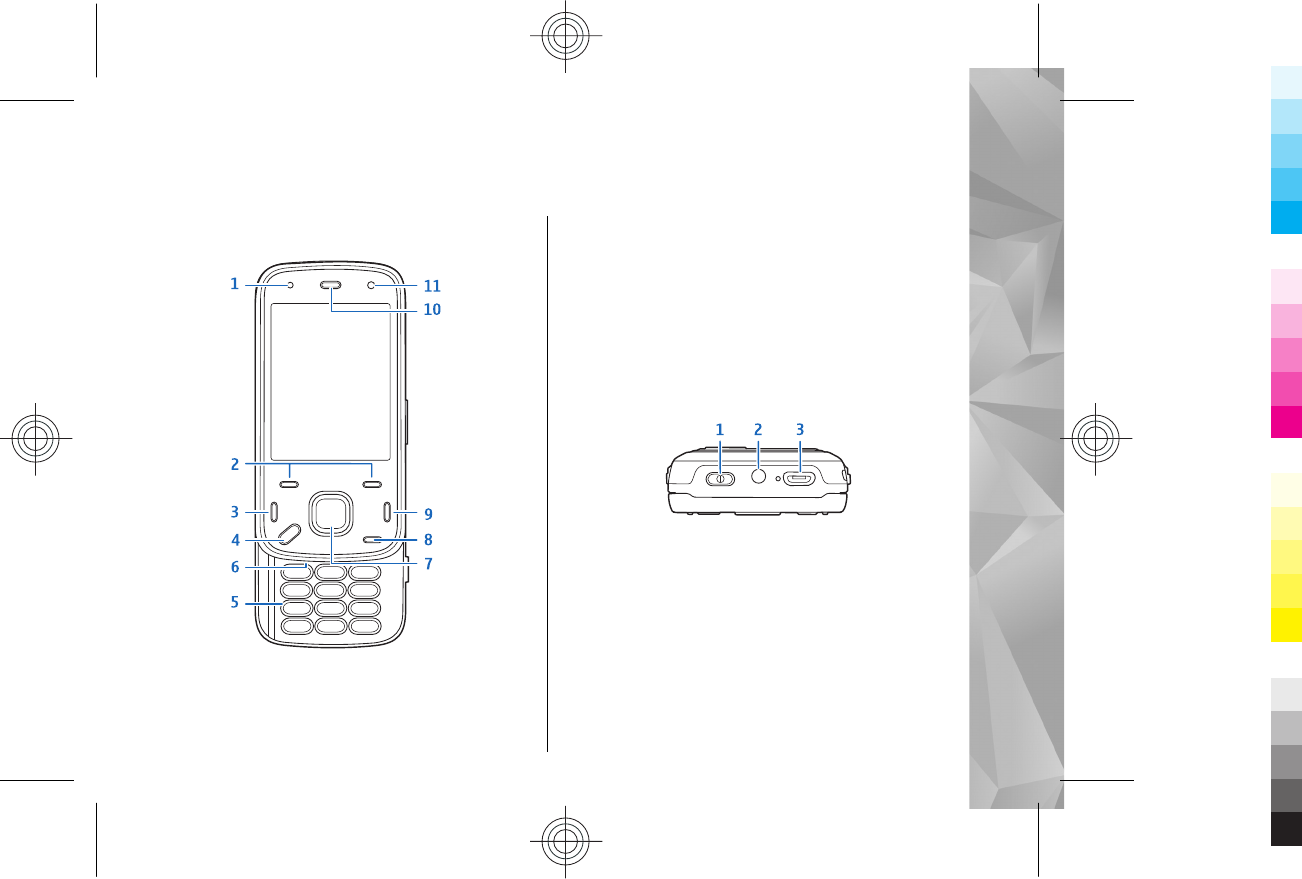
Get started
Keys and parts (front and top)
1 — Light sensor
2 — Selection keys
3 — Call key
4 — Menu key
5 — Numeric keypad
6 — Microphone
7 — Scroll and selection key
8 — Clear key C
9 — End key
10 — Earpiece
11 — Secondary camera
1 — Power key
2 — Nokia AV Connector (3.5 mm)
3 — Micro USB connector
9
Get started
Cyan
Cyan
Magenta
Magenta
Yellow
Yellow
Black
Black
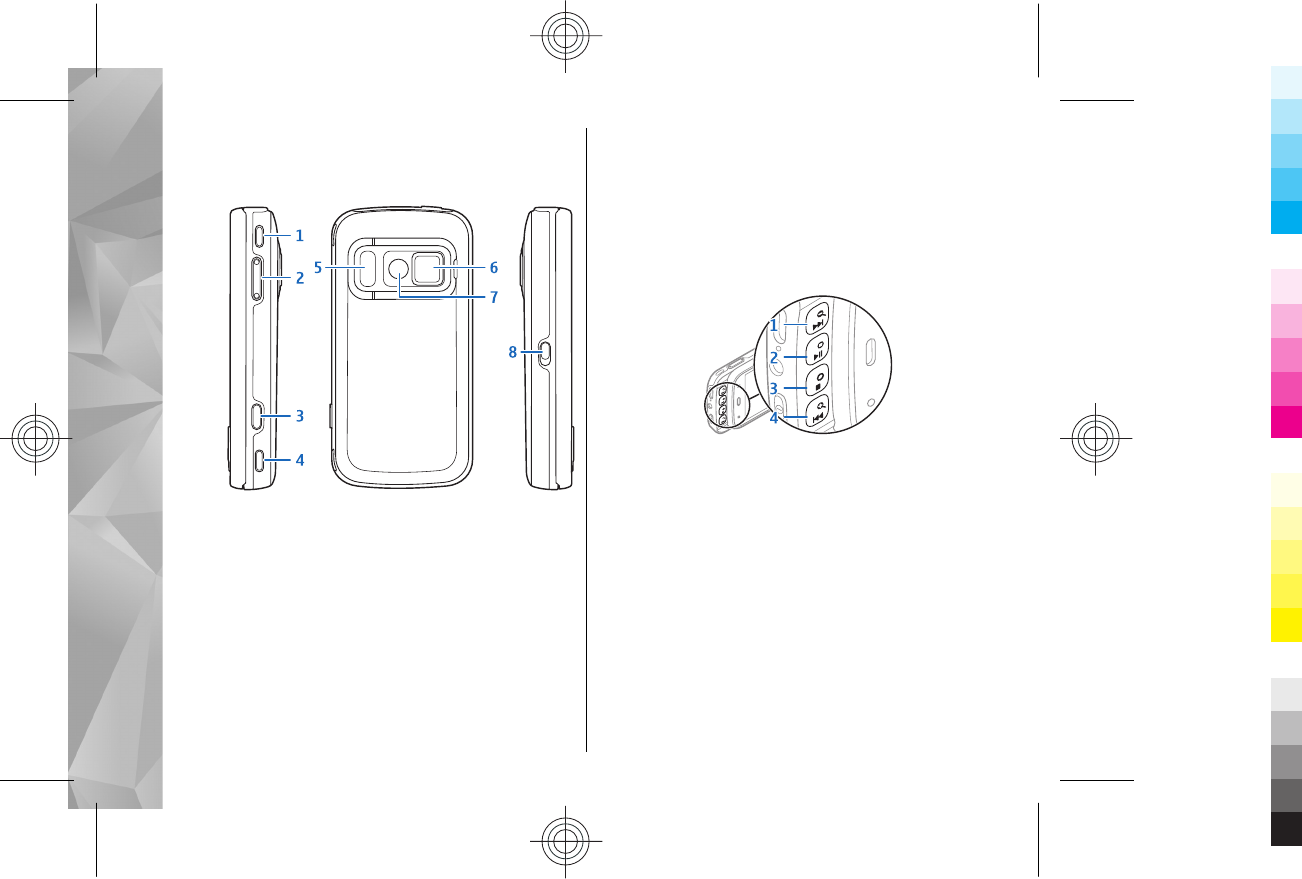
Keys and parts (back and
sides)
1 — Stereo speaker
2 — Volume/Zoom key
3 — Capture key
4 — Stereo speaker
5 — Flash and video light
6 — Lens cover
7 — Main camera
8 — Key lock switch
Short slide keys
Short slide keys act as media, zoom, or gaming keys
depending on the application. Short slide keys also
enable multitasking, for example, if you are browsing
the internet with the Music player application in the
background, you can control the player with the Play/
Pause key.
1 — Forward/Zoom in key
2 — Play/Pause key and gaming key
3 — Stop key and gaming key
4 — Rewind/Zoom out key
Kickstand
You can use the kickstand, for example, when you view
images or video clips.
10
Get started
Cyan
Cyan
Magenta
Magenta
Yellow
Yellow
Black
Black
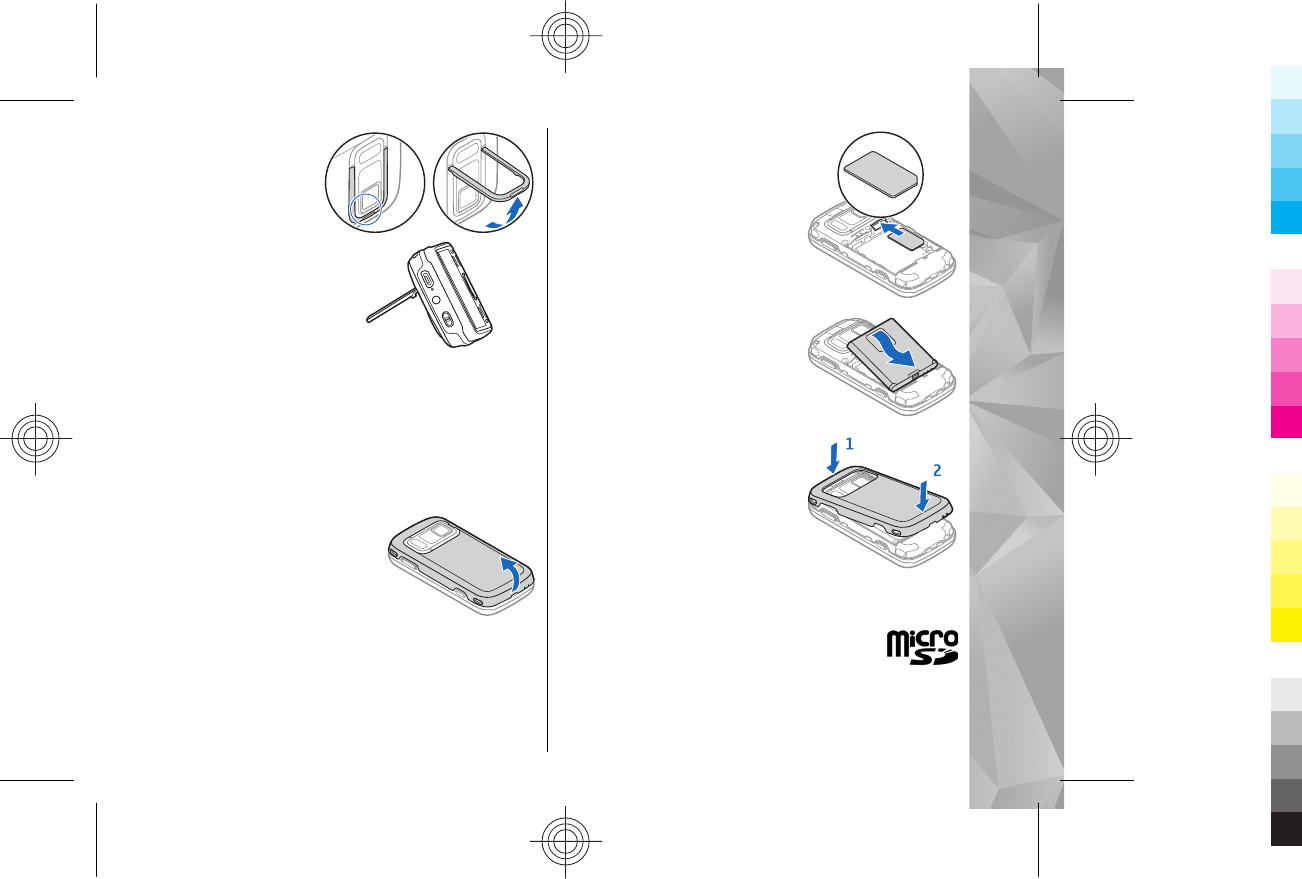
Open the kickstand at
the back of the device,
and place the device on
a level surface. When
you open the kickstand,
the Photos application is
opened automatically.
To modify the kickstand
settings, select Menu >
Tools > Settings and
General >
Personalisation >
Kickstand.
Insert SIM card and battery
Safe removal. Always switch the device off and
disconnect the charger before removing the battery.
1. With the back of the device
facing you, remove the back
cover by lifting it from the
bottom end of the device.
2. Insert the SIM card into the
card holder. Ensure that the
bevelled corner on the card is
facing right, and that the
contact area on the card is
facing down.
3. Insert the battery.
4. To replace the cover, press
the cover down until the
cover locks into place.
Memory card
Use only compatible microSD cards
approved by Nokia for use with this device.
Nokia uses approved industry standards for
memory cards, but some brands may not be fully
compatible with this device. Incompatible cards may 11
Get started
Cyan
Cyan
Magenta
Magenta
Yellow
Yellow
Black
Black
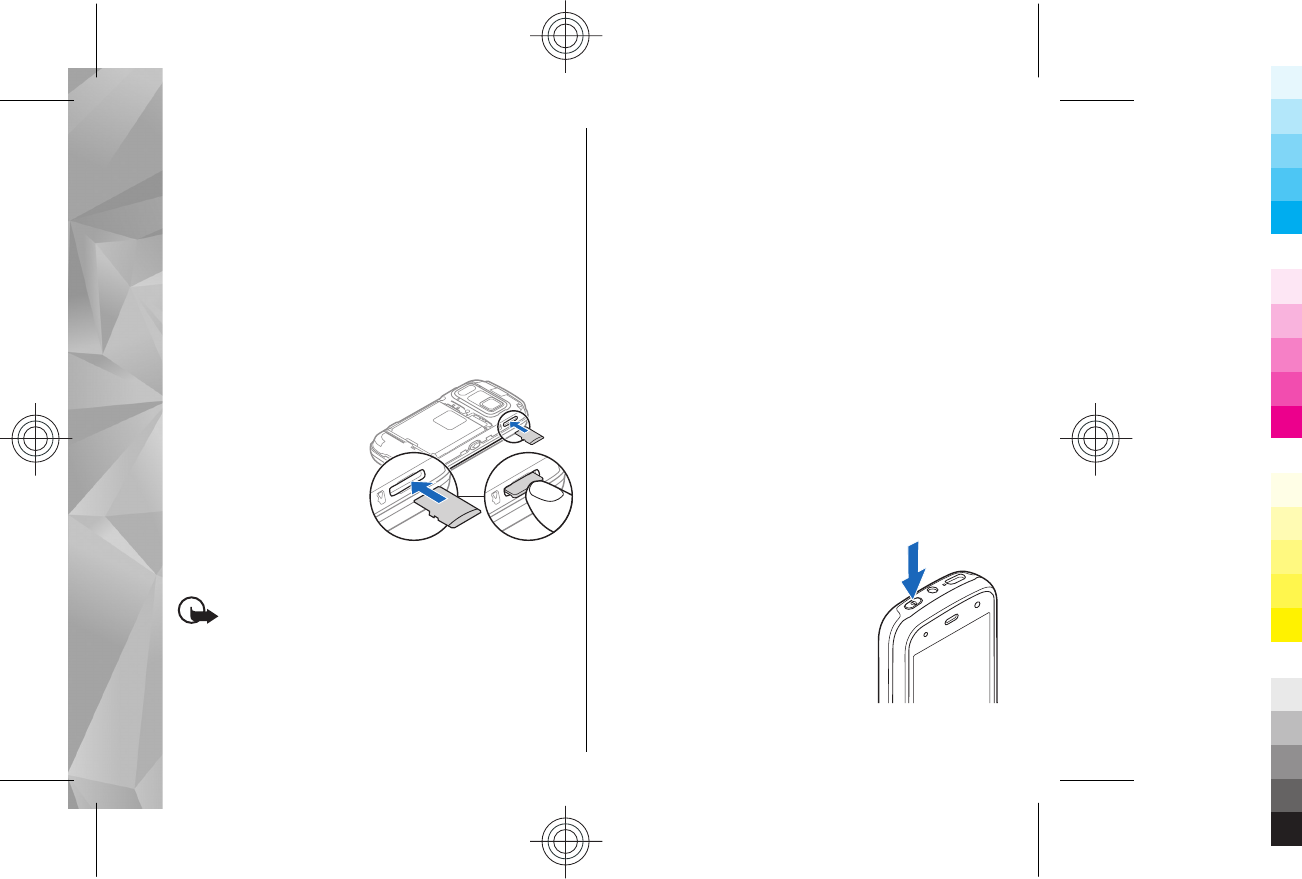
damage the card and the device and corrupt data
stored on the card.
Insert the memory card
A memory card may be already inserted in the device.
If not, do the following:
1. With the back of the device facing you, lift up the
cover.
2. Insert a compatible memory card in the slot. Ensure
that the contact area on the card is facing down and
towards the slot.
3. Push the card in. You
can hear a click when
the card locks into
place.
4. Close the back cover.
Ensure that the cover
is properly closed.
Remove the memory card
Important: Do not remove the memory card
during an operation when the card is being accessed.
Doing so may damage the memory card and the device,
and corrupt data stored on the card.
1. Before you remove the card, press the power key,
and select Remove memory card. All applications
are closed.
2. When Removing memory card will close all open
applications. Remove anyway? is displayed,
select Yes.
3. When Remove memory card and press 'OK' is
displayed, remove the back cover of the device.
4. Press the memory card to release it from the slot.
5. Pull out the memory card. If the device is switched
on, select OK.
6. Replace the back cover. Ensure that the cover is
properly closed.
Switch the device on and off
To switch on the device:
1. Press and hold the power key.
2. If the device asks for a PIN code or
lock code, enter it, and select OK.
The preset lock code is 12345. If
you forget the code and your
device is locked, your device will
require service and additional
charges may apply. For more
information, contact a Nokia Care
point or your device dealer.
12
Get started
Cyan
Cyan
Magenta
Magenta
Yellow
Yellow
Black
Black
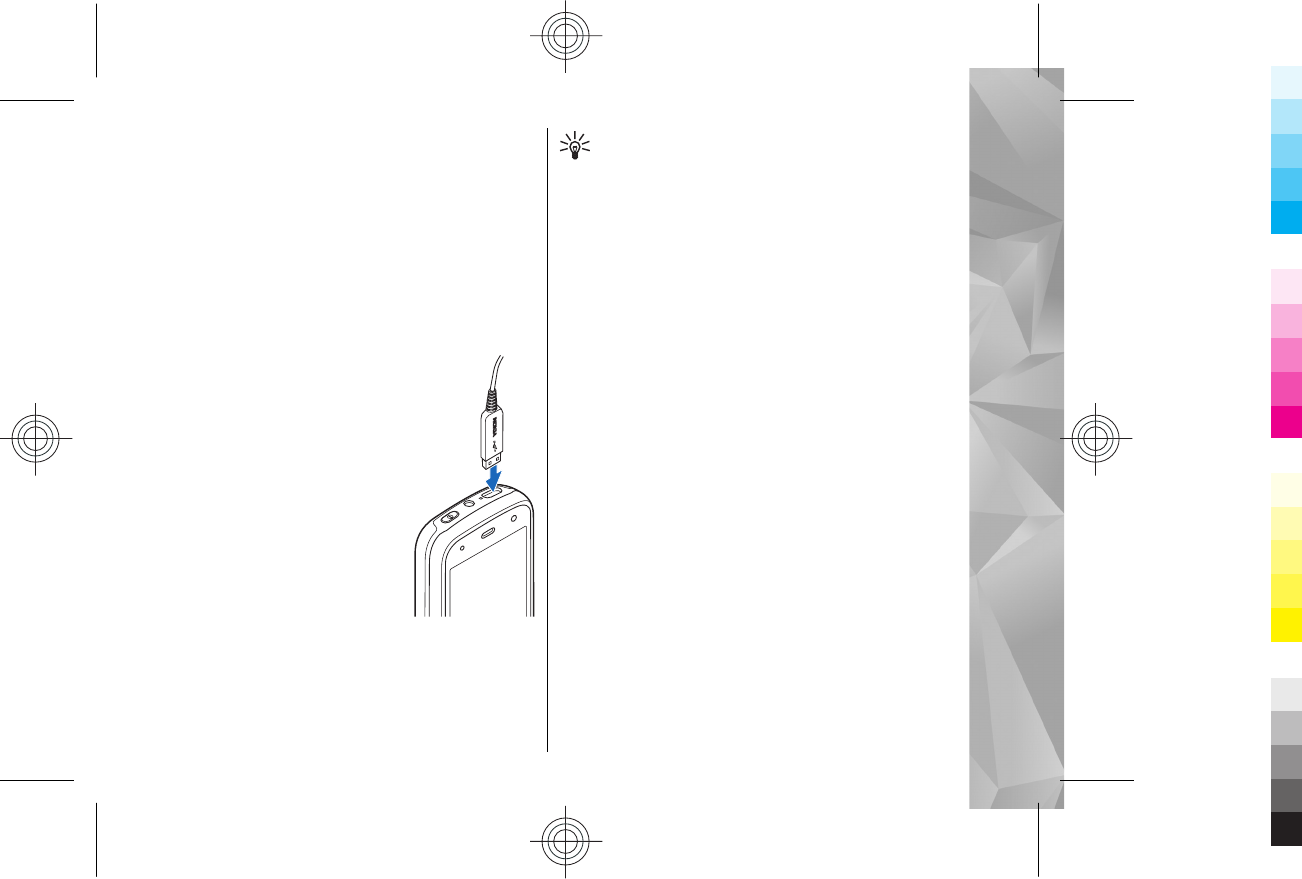
To switch off the device, press the power key briefly,
and select Switch off!.
Charge the battery
Your battery has been partially charged at the factory.
There may not be a need to charge the battery in
advance. If the device indicates a low charge, do the
following:
Regular charging
1. Connect the charger to a wall
outlet.
2. Connect the charger to the device.
The charging indicator light next
to the USB connector is lit when
the battery is being charged.
3. When the device indicates a full
charge, disconnect the charger
from the device, then from the
wall outlet.
You do not need to charge the
battery for a specific length of time,
and you can use the device while it is
charging. If the battery is completely discharged, it
may take several minutes before the charging
indicator appears on the display or before any calls can
be made.
Tip: Disconnect the charger from the wall outlet
when the charger is not in use. A charger that is
connected to the outlet consumes power even
when it is not connected to the device.
USB charging
You can use USB charging when a wall outlet is not
available. With USB charging, you can also transfer data
while charging the device.
1. Connect a compatible USB device to your device
using a compatible USB cable.
The efficiency of USB charging varies significantly.
In some cases, it may take a very long time for
charging to start and the device to start
functioning.
2. If your device is switched on, you can select from
the available USB mode options on the display of
the device.
During extended operation such as an active video call
and high speed data connection, the device may feel
warm. In most cases, this condition is normal. If you
suspect the device is not working properly, take it to
the nearest authorised service facility.
Headset
You can connect a compatible headset or compatible
headphones to your device. You may need to select the
cable mode. 13
Get started
Cyan
Cyan
Magenta
Magenta
Yellow
Yellow
Black
Black
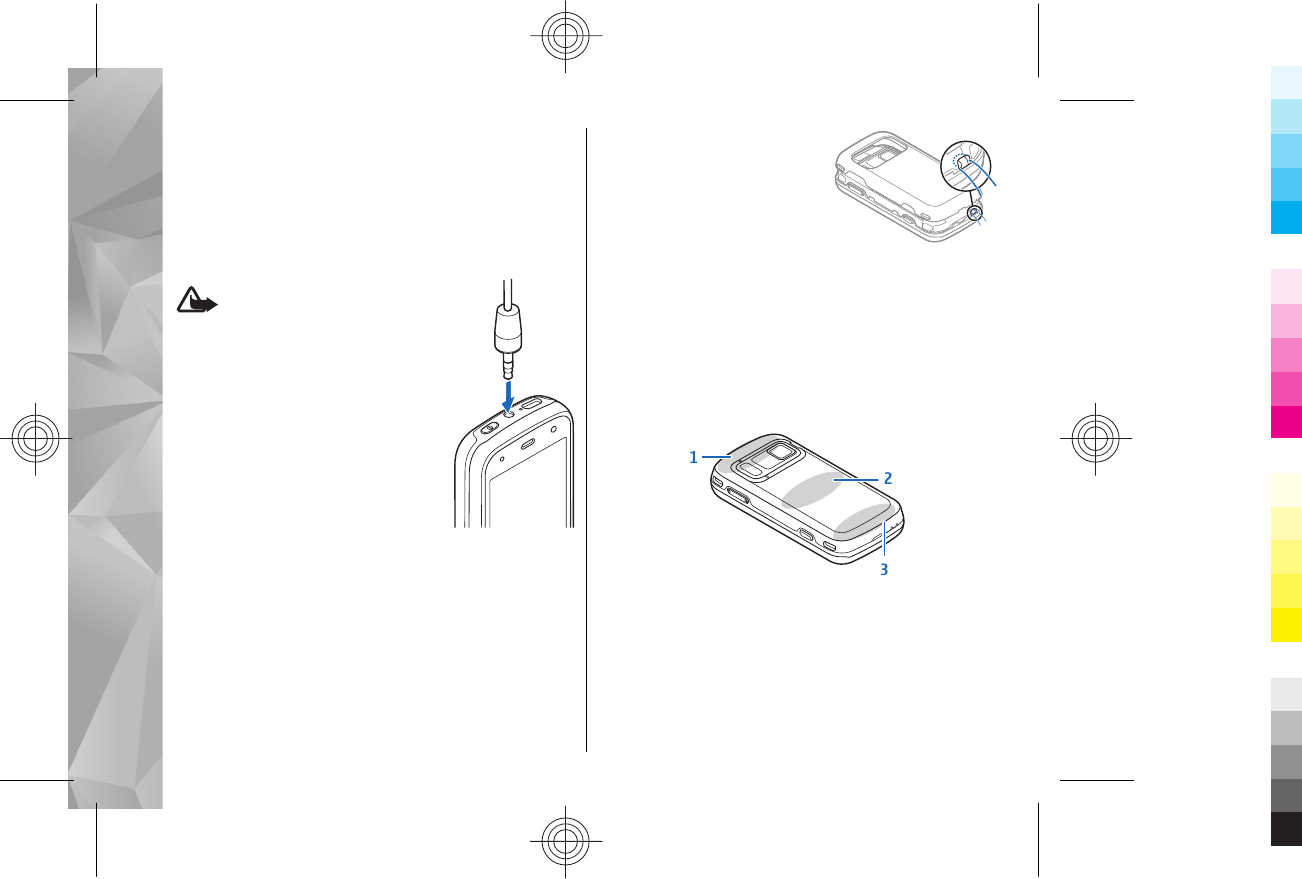
Some headsets come in two parts, a remote control
unit and headphones. A remote control unit has a
microphone and keys to answer or end a phone call,
adjust the volume, and play music or video files. To use
the headphones with a remote control unit, connect
the unit to the Nokia AV Connector in the device, then
connect the headphones to the unit.
Warning: When you use the
headset, your ability to hear outside
sounds may be affected. Do not use
the headset where it can endanger
your safety.
Do not connect products that create
an output signal as this may cause
damage to the device. Do not
connect any voltage source to the
Nokia AV Connector.
When connecting any external
device or any headset, other than
those approved by Nokia for use with this device, to
the Nokia AV Connector, pay special attention to
volume levels.
Attach wrist strap
1. Open the back cover.
2. Thread a wrist strap, and
tighten it.
3. Close the back cover.
Antenna locations
Your device may have internal and external antennas.
Avoid touching the antenna area unnecessarily while
the antenna is transmitting or receiving. Contact with
antennas affects the communication quality and may
cause a higher power level during operation and may
reduce the battery life.
1 — Bluetooth and wireless LAN (WLAN), and GPS
antennas
2 — FM transmitter antenna
3 — Cellular antenna
The FM transmitter antenna is located in the back cover
of your device. If you change the back cover, check that
the new cover includes this antenna, otherwise this
14
Get started
Cyan
Cyan
Magenta
Magenta
Yellow
Yellow
Black
Black

connection stops working. Bluetooth, WLAN, and GPS
antennas are located at the back of your device.
15
Get started
Cyan
Cyan
Magenta
Magenta
Yellow
Yellow
Black
Black
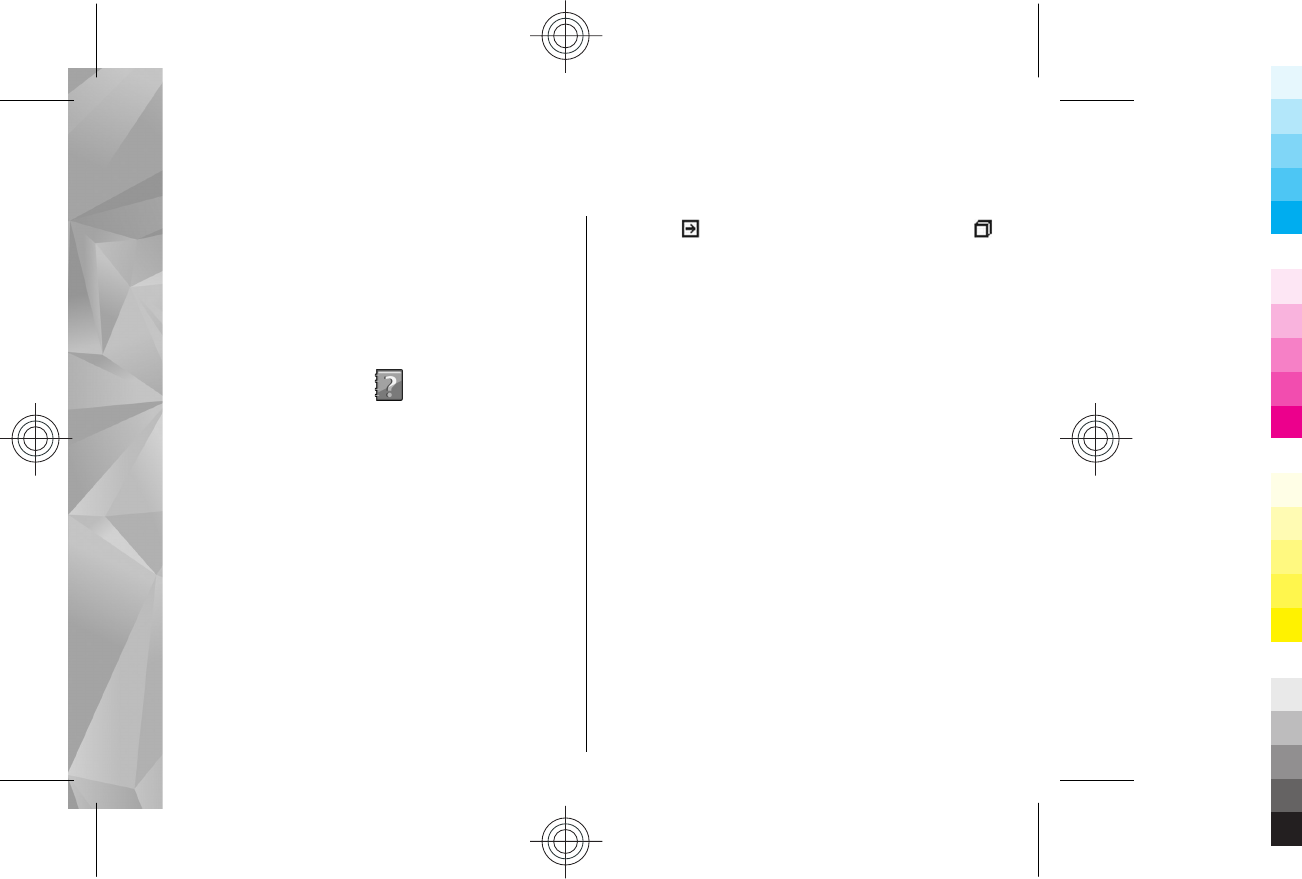
Find help
For local services and warranty information, please
refer to the separate booklet.
For more information on access codes, saving battery
power, and freeing memory, see the extended user
guide on the product support pages of the Nokia
website.
In-device help
Your device contains instructions to help to use the
applications in your device.
To open help texts from the main menu, select Menu >
Applications > Help and the application for which
you want to read instructions.
When an application is open, to access the help text for
the current view, select Options > Help.
When you are reading the instructions, to change the
size of the help text, select Options > Decrease font
size or Increase font size.
You can find links to related topics at the end of the
help text. If you select an underlined word, a short
explanation is displayed. Help texts use the following
indicators: shows a link to a related help topic.
shows a link to the application being discussed.
When you are reading the instructions, to switch
between help texts and the application that is open in
the background, press and hold the menu key, and
select from the list of open applications.
Accessibility solutions
Nokia is committed to making mobile phones easy to
use for all individuals, including those with disabilities.
For more information, visit the Nokia website at
www.nokiaaccessibility.com.
Support
When you want to learn more about how to use your
product or you are unsure how your device should
function, see the support pages at www.nokia.com/
support or your local Nokia website, www.nokia.mobi/
support (with a mobile device), the Help application in
the device, or the user guide.
If this does not resolve your issue, do the following:
16
Find help
Cyan
Cyan
Magenta
Magenta
Yellow
Yellow
Black
Black

●Restart the device: switch off the device, and remove
the battery. After about a minute, replace the
battery, and switch on the device.
●Restore the original factory settings as explained in
the user guide. Your documents and files are not
deleted in the reset.
If the issue remains unsolved, contact Nokia for repair
options. See www.nokia.com/repair, or in Latin
America, www.nokia-latinoamerica.com/
centrosdeservicio. Before sending your device for
repair, always back up the data in your device.
Extended user guide
An extended version of this user guide is available on
the product support pages of the Nokia website. Some
applications or functions are explained only in the
extended user guide. This is explained in the relevant
sections. The extended user guide also contains a
troubleshooting section.
Additional applications
There are various applications provided by Nokia and
different third-party software developers that help you
do more with your device. These applications are
explained in the guides that are available on the
product support pages of the Nokia website.
Update device software
Software updates using your PC
Software updates may include new features and
enhanced functions that were not available at the time
of purchase of your device. Updating the software may
also improve the device performance.
Nokia Software Updater is a PC application that enables
you to update your device software. To update your
device software, you need a compatible PC, broadband
internet access, and a compatible USB data cable to
connect your device to the PC.
To get more information, to check the release notes for
the latest software versions, and to download the
Nokia Software Updater application, see
www.nokia.com/softwareupdate, or in Latin America,
www.nokia-latinoamerica.com/nsu.
To update the device software, do the following:
1. Download and install the Nokia Software Updater
application to your PC.
2. Connect your device to the PC using a USB data
cable, and open the Nokia Software Updater
application. The Nokia Software Updater
application guides you to back up your files, update
the software, and restore your files.
17
Find help
Cyan
Cyan
Magenta
Magenta
Yellow
Yellow
Black
Black
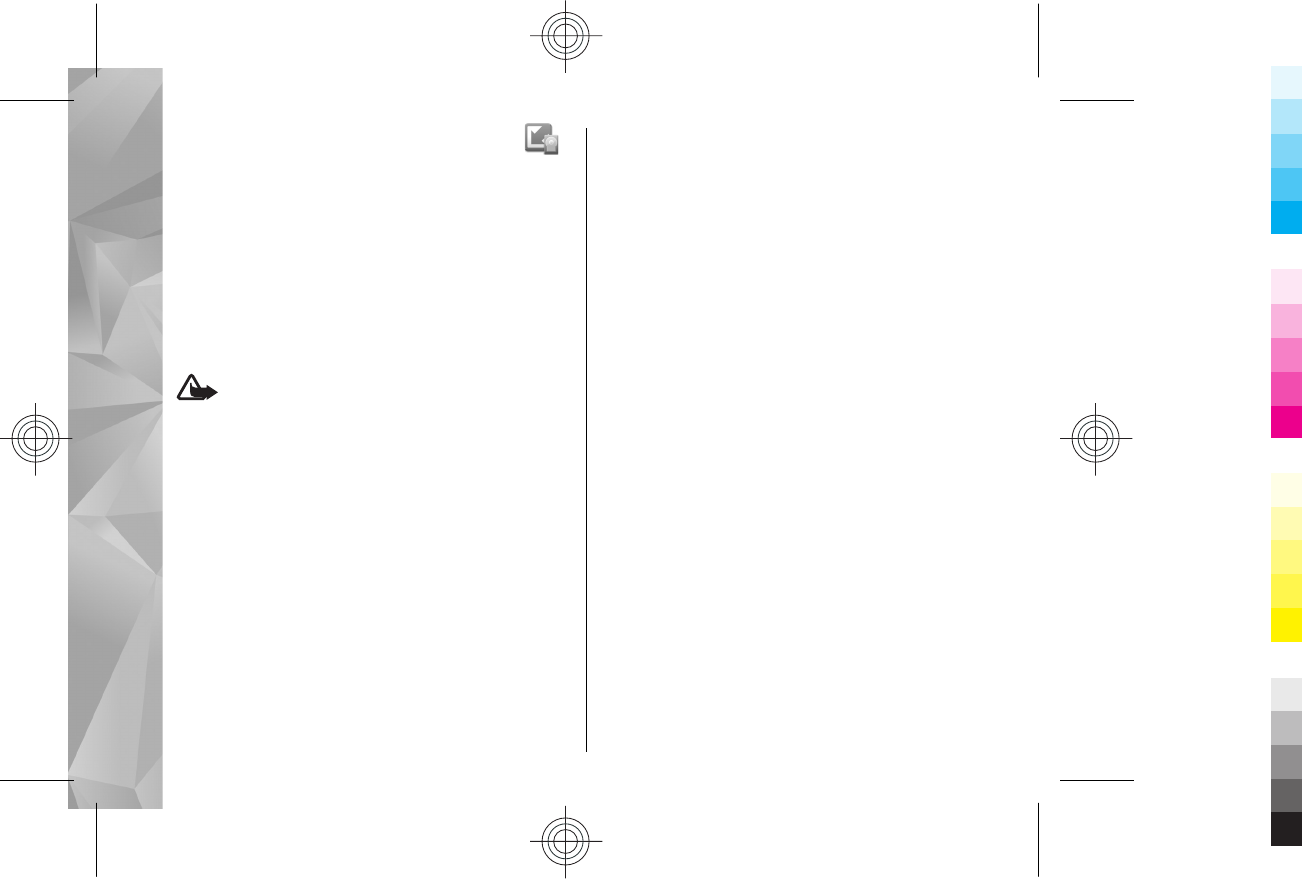
Software updates over the air
Select Menu > Applications > SW update.
With Software update (network service), you can check
if there are updates available for your device software
or applications, and download them to your device.
Downloading software updates may involve the
transmission of large amounts of data (network
service).
Make sure that the device battery has enough power,
or connect the charger before starting the update.
Warning: If you install a software update, you
cannot use the device, even to make emergency calls,
until the installation is completed and the device is
restarted. Be sure to back up data before accepting
installation of an update.
After updating your device software or applications
using Software update, the instructions related to the
updated applications in the user guide or the helps
may no longer be up to date.
Select Options and from the following:
●Start update — Download the available updates.
To unmark specific updates that you do not want to
download, select the updates from the list.
●Update via PC — Update your device using a PC.
This option replaces the Start update option when
updates are only available using the Nokia Software
Updater PC application.
●View details — View information on an update.
●View update history — View the status of previous
updates.
●Settings — Change the settings, such as the default
access point used for downloading updates.
●Disclaimer — View the Nokia licence agreement.
Settings
Your device normally has MMS, GPRS, streaming, and
mobile internet settings automatically configured,
based on your network service provider information.
You may have settings from your service providers
already installed in your device, or you may receive or
request the settings from the network service
providers as a special message.
You can change the general settings in your device,
such as language, standby mode, display, and keypad
lock settings.
18
Find help
Cyan
Cyan
Magenta
Magenta
Yellow
Yellow
Black
Black

Your device
Transfer content
You can use the Switch application to copy content
such as phone numbers, addresses, calendar items,
and images from your previous Nokia device to your
device.
The type of content that can be transferred depends on
the model of the device from which you want to
transfer content. If that device supports
synchronisation, you can also synchronise data
between the devices. Your device notifies you if the
other device is not compatible.
If the other device cannot be switched on without a
SIM card, you can insert your SIM card in it. When your
device is switched on without a SIM card, the Offline
profile is automatically activated, and transfer can be
done.
Transfer content for the first time
1. To retrieve data from the other device for the first
time, on your device, select Phone switch in the
Welcome application, or select Menu > Tools >
Switch.
2. Select the connection type you want to use to
transfer the data. Both devices must support the
selected connection type.
3. If you select Bluetooth connectivity as the
connection type, connect the two devices. To have
your device search for devices with Bluetooth
connectivity, select Continue. Select the device
from which you want to transfer content. You are
asked to enter a code on your device. Enter a code
(1-16 digits), and select OK. Enter the same code on
the other device, and select OK. The devices are now
paired.
Some earlier Nokia devices may not have the Switch
application. In this case, the Switch application is
sent to the other device as a message. To install the
Switch application on the other device, open the
message, and follow the instructions on the display.
4. On your device, select the content you want to
transfer from the other device.
When the transfer has started, you can cancel it and
continue later.
Content is transferred from the memory of the other
device to the corresponding location in your device. 19
Your device
Cyan
Cyan
Magenta
Magenta
Yellow
Yellow
Black
Black
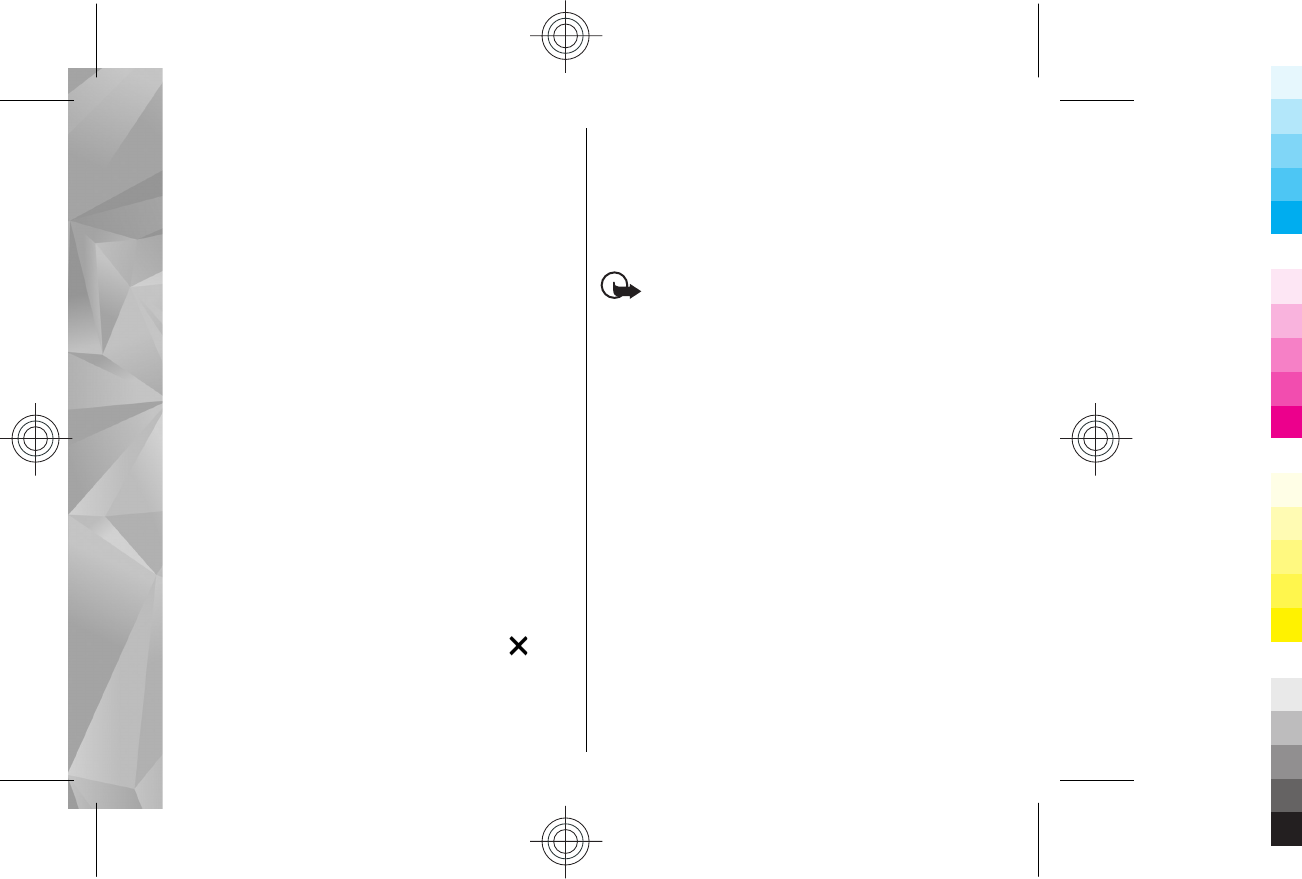
The transfer time depends on the amount of data to be
transferred.
Lock the keypad
To lock or unlock the keys, use the lock switch on the
right side of the device, or close or open the 2-way
slide.
To set the keypad to lock automatically after a time-
out, select Menu > Tools > Settings and General >
Security > Phone and SIM card > Keypad autolock
period.
To select whether to lock the keypad when the 2-way
slide is closed, select Menu > Tools > Settings and
General > Slide handling > Keyguard activation.
Offline profile
To activate the offline profile, press the power key
briefly, and select Offline.
The offline profile lets you use the device without
connecting to the wireless cellular network. When you
activate the offline profile, the connection to the
cellular network is turned off, as indicated by in the
signal strength indicator area. All radio frequency (RF)
signals to and from the device to the cellular network
are prevented. If you try to send messages using the
cellular network, they are placed in the Outbox folder
to be sent later.
When the offline profile is active, you can use your
device without a SIM card.
If the SIM card is not properly in place, the device starts
in the offline profile.
Important: In the Offline profile you cannot
make or receive any calls, or use other features that
require cellular network coverage. Calls may still be
possible to the official emergency number
programmed into your device. To make calls, you must
first activate the phone function by changing profiles.
If the device has been locked, enter the lock code.
When you have activated the offline profile, you can
still use the wireless LAN, for example, to read your e-
mail or browse on the internet. You can also use
Bluetooth connectivity while in the offline profile.
Remember to comply with any applicable safety
requirements when establishing and using a wireless
LAN or Bluetooth connections.
To switch to another profile, press the power key
briefly, and select another profile. The device re-
enables wireless transmissions (providing there is
sufficient signal strength).
20
Your device
Cyan
Cyan
Magenta
Magenta
Yellow
Yellow
Black
Black
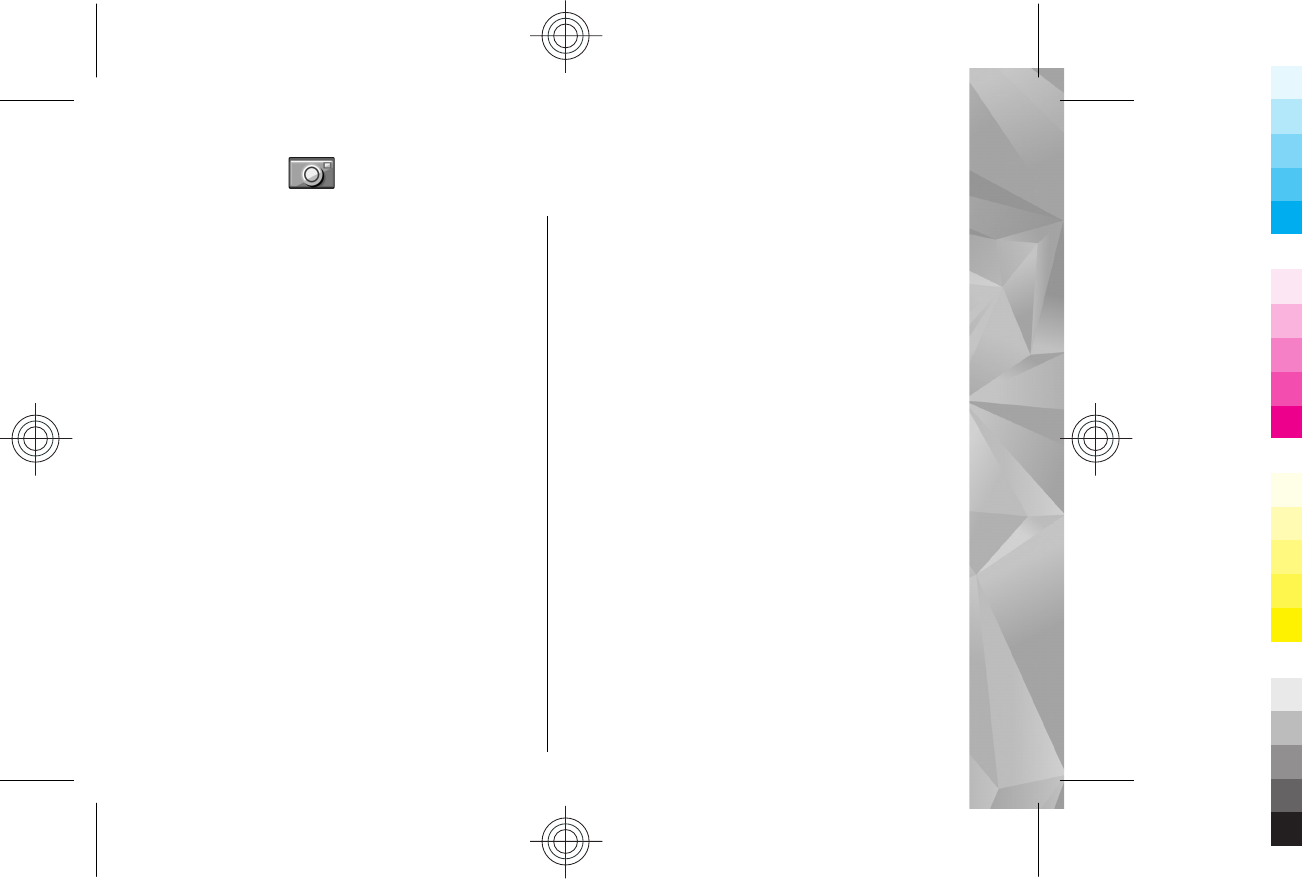
Camera
For more information on the camera and camera
settings, see the extended user guide on the product
support pages of the Nokia website.
About the camera
Your Nokia N86 8MP has two cameras. The main, high-
resolution camera, is on the back of the device. The
secondary, lower resolution camera is on the front. You
can use both cameras to capture images and record
videos.
Your device supports an image capture resolution of
3264x2448 pixels (8 megapixels). The image
resolution in this guide may appear different.
The images and video clips are saved in Photos.
The produced images are in the JPEG format. Video clips
are recorded in the MPEG-4 file format with the .mp4
file extension, or in the 3GPP file format with the .3gp
file extension (sharing quality).
To free memory for new images and video clips,
transfer files to a compatible PC using a compatible USB
data cable, for example, and remove the files from your
device. The device informs you when the memory is
full. You can then free up memory in the current
storage or change the memory in use.
Activate the camera
To activate the main camera, open the lens cover. To
activate the main camera when the lens cover is
already open and the camera is active in the
background, press and hold the capture key.
To close the main camera, close the lens cover.
Image capture
Still image camera indicators
The still image camera viewfinder displays the
following:
21
Camera
Cyan
Cyan
Magenta
Magenta
Yellow
Yellow
Black
Black
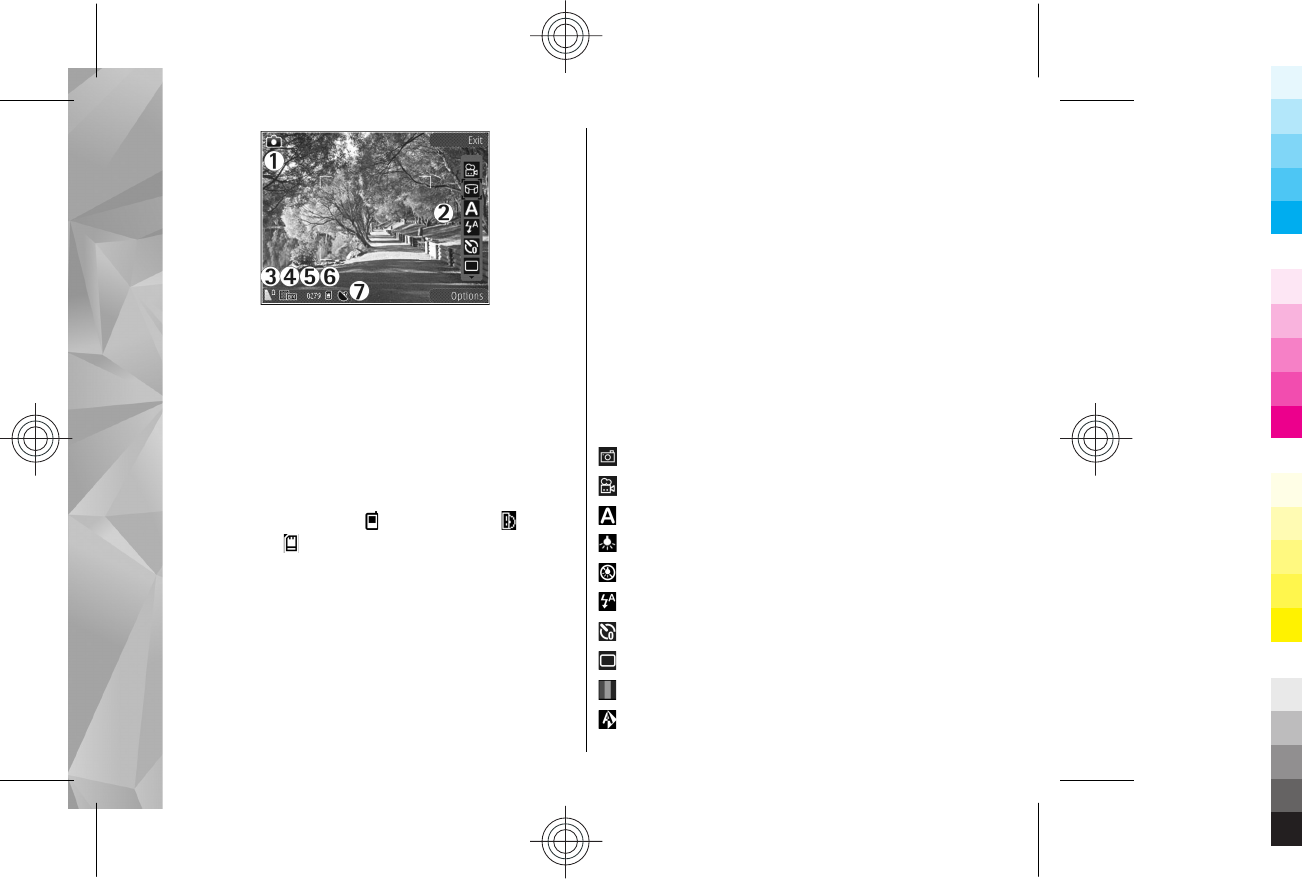
1 — Capture mode indicator
2 — Active toolbar (not displayed during image
capture).
3 — Battery charge level indicator
4 — Image resolution indicator
5 — Image counter (the estimated number of images
you can capture using the current image quality setting
and memory)
6 — The device memory ( ), mass memory , and
memory card ( ) indicators, which show where
images are saved
7 — GPS signal indicator
Active toolbar
The active toolbar provides you with shortcuts to
different items and settings before and after capturing
an image or recording a video clip. To select a toolbar
item, scroll to the item, and press the scroll key. You
can also define when the active toolbar is displayed.
The settings in the active toolbar return to the default
settings after you close the camera.
To view the active toolbar before and after capturing
an image or recording a video clip, select Options >
Show toolbar. To view the active toolbar only when
you need it, select Options > Hide toolbar. To display
the toolbar when it is hidden, press the scroll key. The
toolbar is displayed for 5 seconds.
By default, not all shortcuts are available. To add or
remove shortcuts from the toolbar, select Options >
Customise toolbar.
From the active toolbar, select from the following:
Switch to video mode.
Switch to image mode.
Select the scene.
Turn the video light off (video mode only).
Turn the video light on (video mode only).
Select the flash mode (images only).
Activate the self-timer (images only).
Activate sequence mode (images only).
Select a colour effect.
Adjust the white balance.
22
Camera
Cyan
Cyan
Magenta
Magenta
Yellow
Yellow
Black
Black
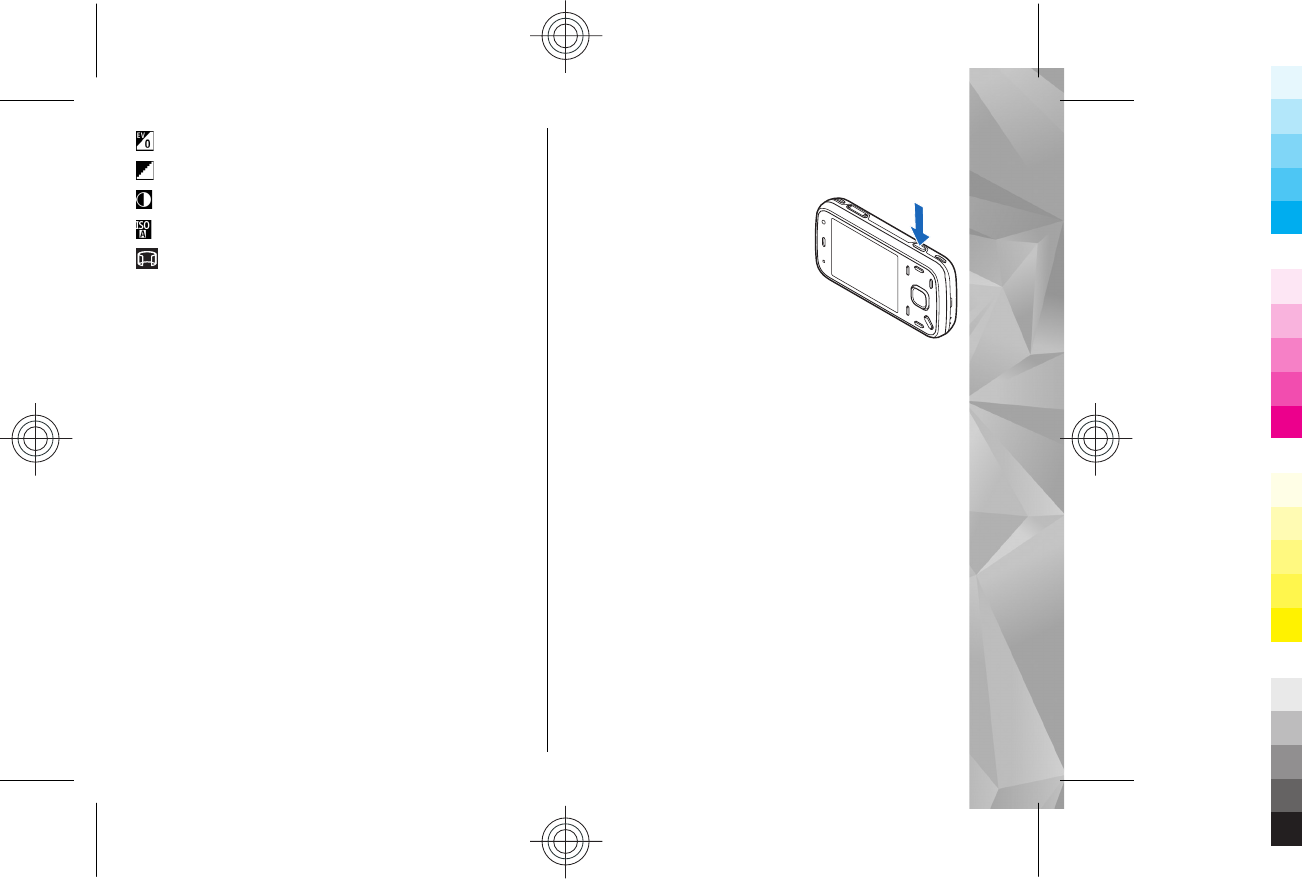
Adjust the exposure compensation (images only).
Adjust sharpness (images only).
Adjust contrast (images only).
Adjust light sensitivity (images only).
Activate panorama mode.
The icons change to reflect the current setting.
Saving the captured image may take longer if you
change the zoom, lighting, or colour settings.
Capture images
When capturing an image, note the following:
●Use both hands to keep the camera still.
●The quality of a digitally zoomed image is lower
than that of a nonzoomed image.
●The camera goes into the battery saving mode if
there are no keypresses for a moment. To continue
capturing images, press the capture key.
To capture an image, do the following:
1. If the camera is in the video mode, select the image
mode from the active toolbar.
2. To lock the focus on an object, press the capture key
halfway down (main camera only, not available in
landscape or sport scene.). A green locked focus
indicator appears on the display. If the focus was
not locked, a red focus indicator appears. Release
the capture key, and press it halfway down again.
You can also capture an image without locking the
focus.
3. To capture an image, press the
capture key. Do not move the
device before the image is
saved and the final image
appears on the screen.
To zoom in or out when capturing
an image, use the zoom key in
your device.
To leave the camera open in the background and use
other applications, press the menu key. To return to
the camera, press and hold the capture key.
Location information
You can automatically add capture location
information to the file details of the captured material.
For example, in the Photos application, you can then
view the location where an image was captured.
Select Menu > Applications > Camera.
To add location information to all captured material,
select Options > Settings > Record location >
On. The location information is available only for
images captured with the main camera.
The availability and quality of GPS signals may be
affected by your location, buildings, natural obstacles, 23
Camera
Cyan
Cyan
Magenta
Magenta
Yellow
Yellow
Black
Black
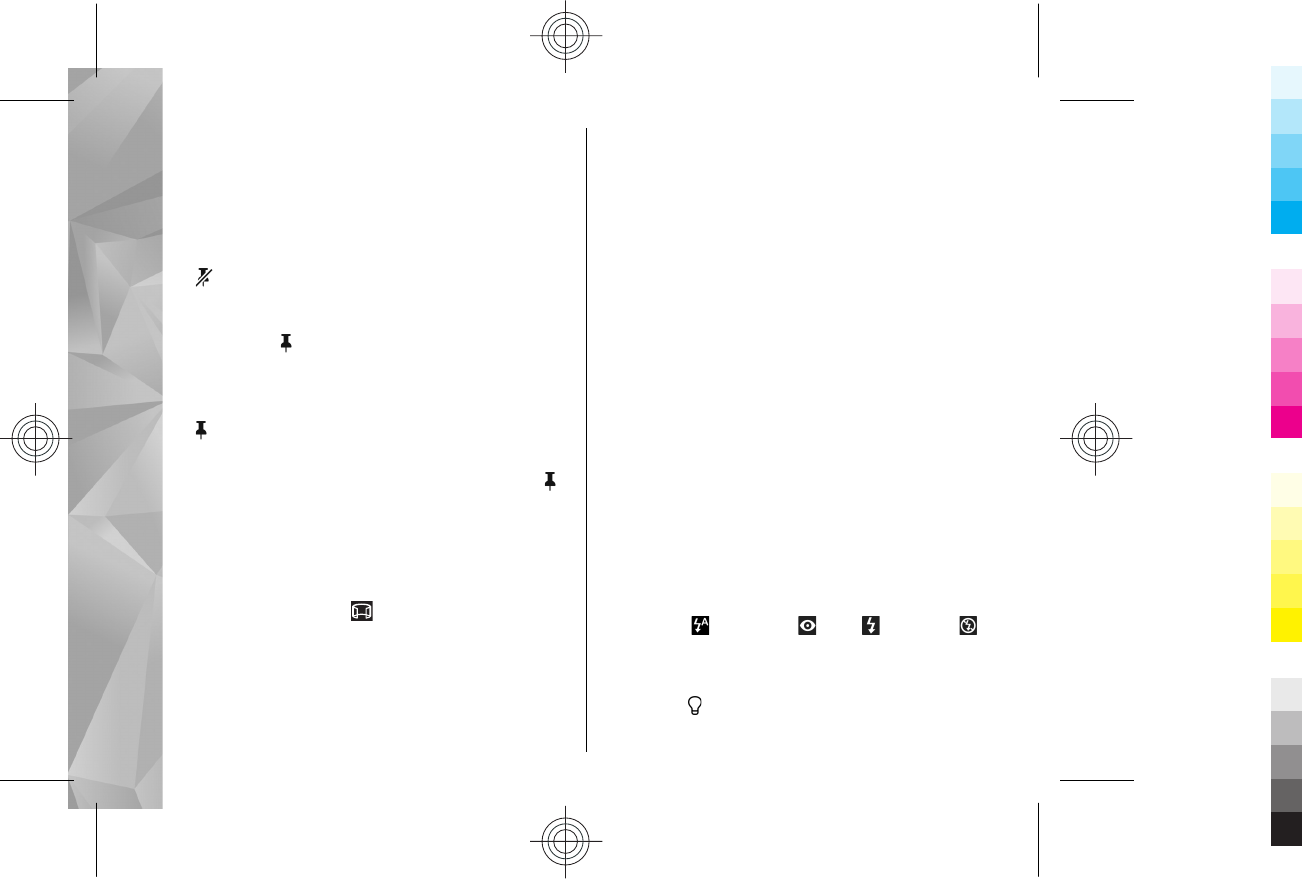
and weather conditions. If you share a file that includes
location information, also the location information is
shared, and your location may be visible to third
parties viewing the file. The device requires network
services to acquire location information.
Location information indicators:
● — Location information unavailable. GPS stays
on in the background for several minutes. If a
satellite connection is found and the indicator
changes to within that time, all the images
captured and video clips recorded during that time
are tagged based on the received GPS positioning
information.
● — Location information is available. Location
information is added to the file details.
Files with location information are indicated with in
the Photos application.
Panorama mode
Select Menu > Applications > Camera.
Select panorama mode from the toolbar.
1. To capture the first image in the panorama, press
the capture key.
2. Slowly turn the device left or right as shown by the
arrows.
A panorama preview is displayed and the camera
captures the image as you turn. The green arrow
indicates that you can slowly proceed to turn. The
red pause mark indicates that you should stop
moving until the green arrow is displayed again.
You can predict when the next key frame is captured
when the red rectangle moves to the centre of the
preview area.
3. To complete the capture, select Stop. The
panoramic capture stops automatically when the
maximum image width has been reached. Note that
it may take some time for the device to process the
captured image.
Flash
The flash is available only in the main camera.
Keep a safe distance when using the flash. Do not use
the flash on people or animals at close range. Do not
cover the flash while taking a picture.
The camera of your device has a dual LED flash for low
light conditions.
Select the desired flash mode from the active toolbar:
Automatic ( ), Red-eye ( ), On ( ), and Off ( ).
Video light
To increase light levels when recording video in low
light, select .
24
Camera
Cyan
Cyan
Magenta
Magenta
Yellow
Yellow
Black
Black
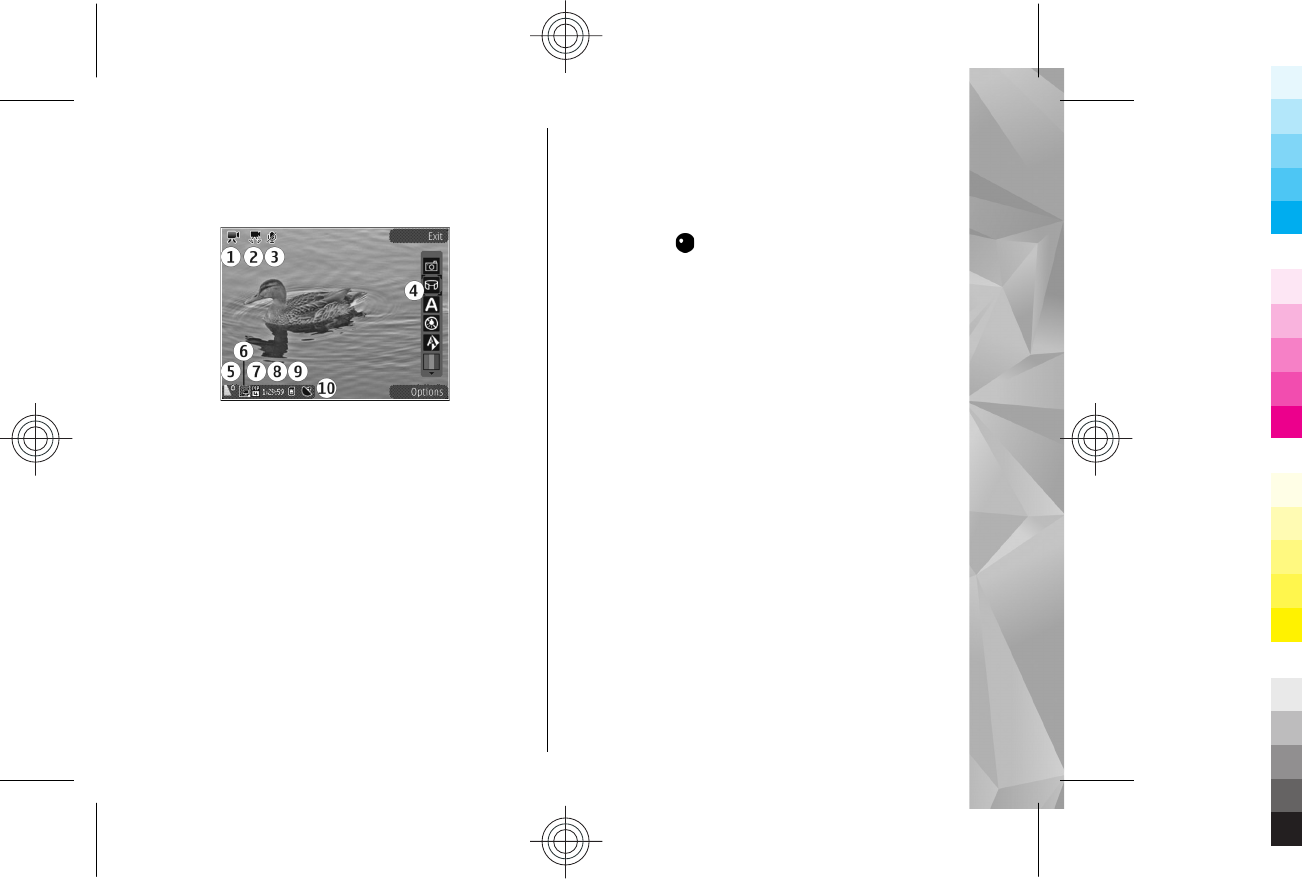
Video recording
Video capture indicators
The video viewfinder displays the following:
1 — Capture mode indicator
2 — Video stabilisation on indicator
3 — Audio mute on indicator
4 — Active toolbar (not displayed during recording)
5 — Battery charge level indicator
6 — Video quality indicator. To change this setting,
select Options > Settings > Video quality.
7 — Video clip file type
8 — Available recording time. When you are recording,
the current video length indicator also shows the
elapsed and remaining time.
9 — The location to which the video clip is saved.
10 — GPS signal indicator
Record videos
1. If the camera is in the image mode, select the video
mode from the active toolbar.
2. To start recording, press the capture key. The red
record icon ( ) is displayed and a tone sounds.
3. To pause recording at any time, press Pause. Select
Continue to resume. If you pause recording and do
not press any key within one minute, the recording
stops.
To zoom in or out of the subject, use the zoom key
in your device.
4. To stop recording, press the capture key. The video
clip is automatically saved in Photos. The maximum
length of a video clip is approximately 30 seconds
with sharing quality and 90 minutes with other
quality settings.
To activate the front camera, select Options > Use
secondary camera. To start recording a video, press
the scroll key. To zoom in or out, scroll up or down.
25
Camera
Cyan
Cyan
Magenta
Magenta
Yellow
Yellow
Black
Black
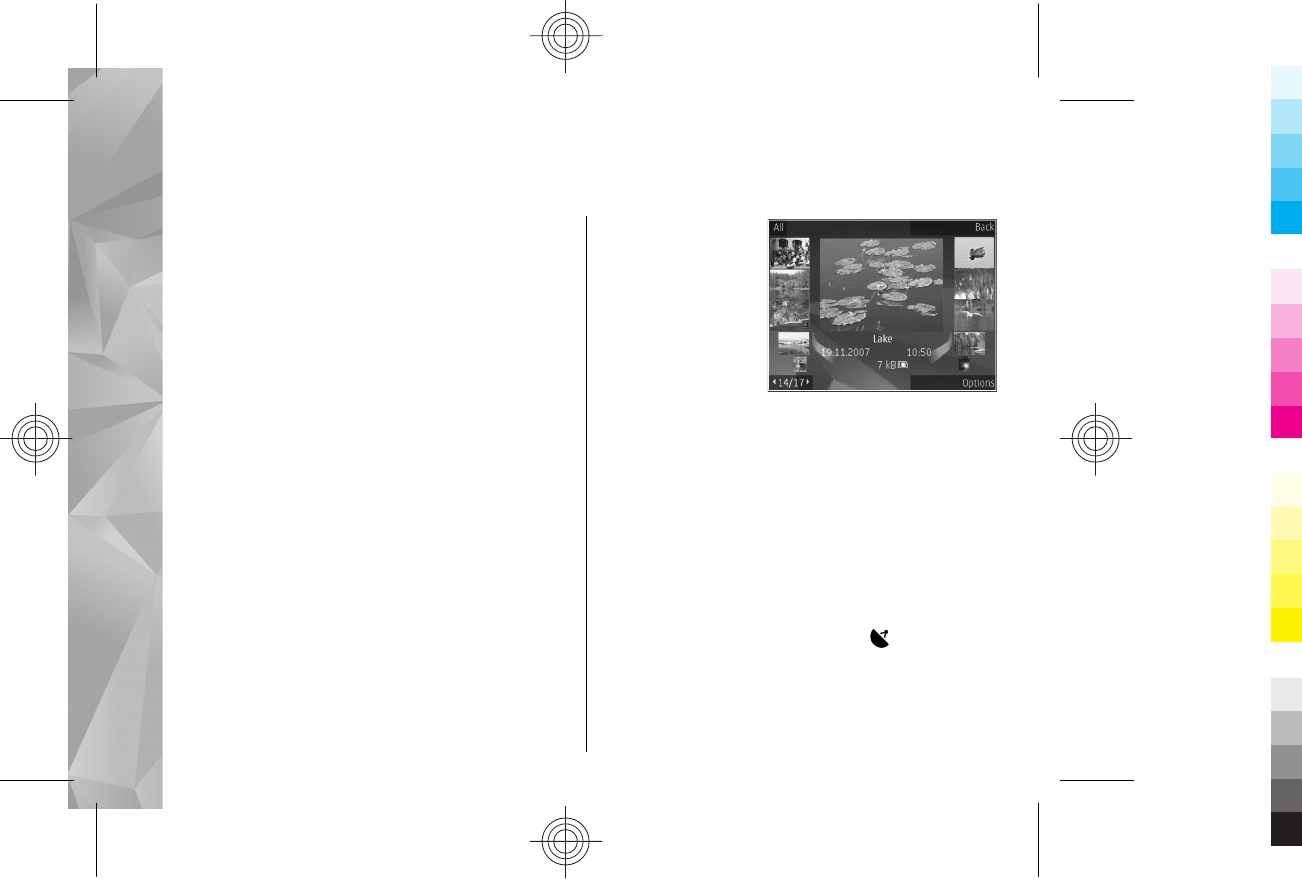
Photos
About Photos
Select Menu > Photos and from the following:
●Captured — View all the images and videos you
have captured.
●Months — View images and videos categorised by
the month they where captured.
●Albums — View the default albums and the ones
you have created.
●Tags — View the tags you have created for each
item.
●Downloads — View items and videos downloaded
from the web or received as a multimedia or e-mail
message.
●All — View all items.
●Share online — Post your images or videos to the
web.
View images and videos
Select Menu > Photos and from the following:
●All — View all images and videos.
●Captured — View images captured and video clips
recorded with the camera of your device.
●Downloads — View downloaded video clips.
Images and video
clips can also be sent
to you from a
compatible device. To
be able to view a
received image or
video clip in Photos,
you must first save it.
The images and video
clip files are in a loop and ordered by date and time.
The number of files is displayed. To browse the files
one by one, scroll left or right. To browse files in
groups, scroll up or down.
To open a file, select the file. When an image opens, to
zoom in the image, use the zoom keys. The zooming
ratio is not stored permanently.
To edit an image or a video clip, select Options >
Edit.
To see where an image marked with was captured,
select Options > Show on map.
To print your images on a compatible printer, select
Options > Print.
26
Photos
Cyan
Cyan
Magenta
Magenta
Yellow
Yellow
Black
Black

To move images to an album for later printing, select
Options > Add to album > Print later.
Active toolbar
The active toolbar is available only when you have
selected an image or a video clip in a view.
In the active toolbar, go to different items, and select
the desired option. The available options vary
depending on the view you are in and whether you
have selected an image or a video clip.
To hide the toolbar, select Options > Hide icons. To
activate the active toolbar when it is hidden, press the
scroll key.
Select an image or a video clip and from the following:
Play the video clip.
Send the image or video clip.
Upload the image or video clip to a compatible
online album (only available if you have set up an
account for a compatible online album).
Add the item to an album.
Manage tags and other properties of the item.
27
Photos
Cyan
Cyan
Magenta
Magenta
Yellow
Yellow
Black
Black
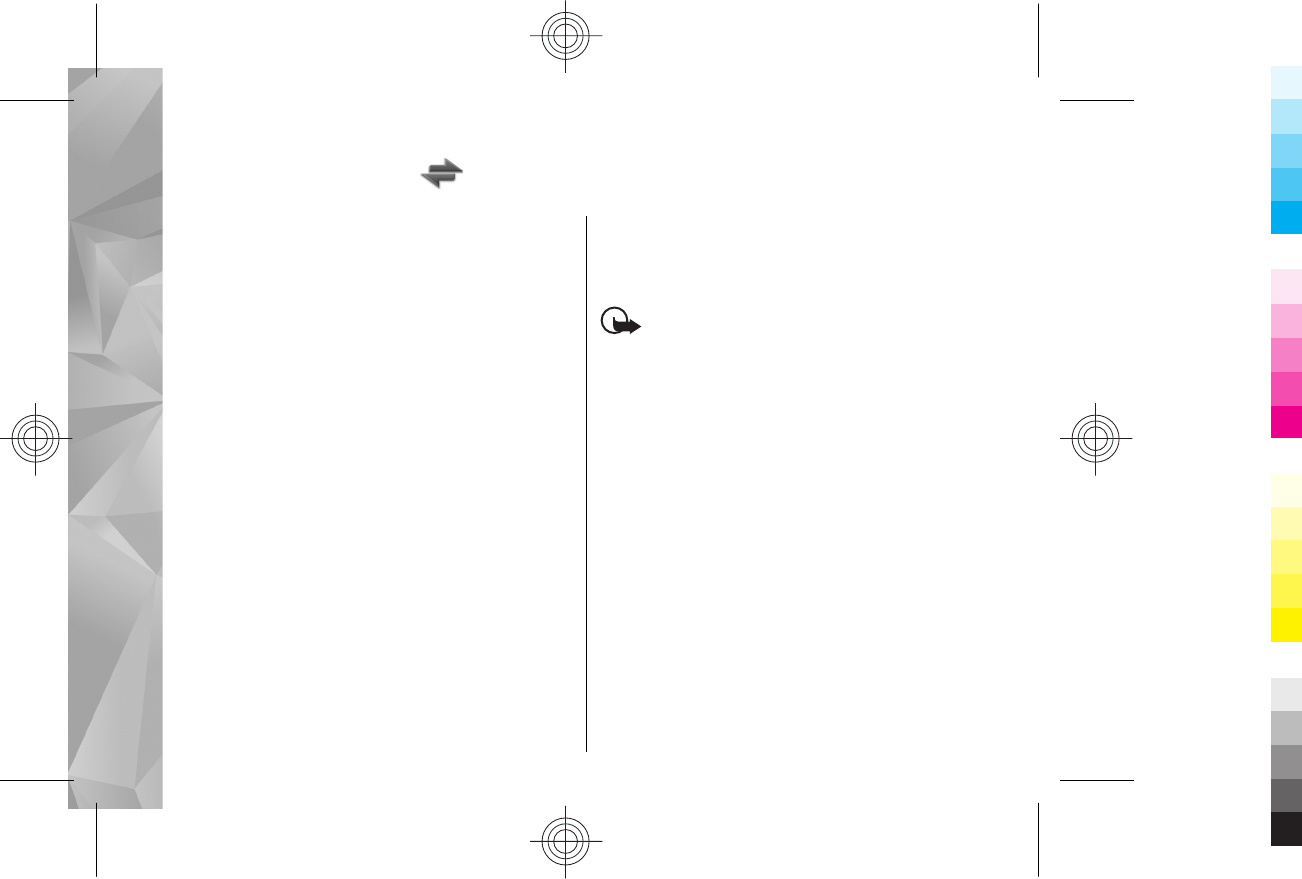
Connectivity
Your device offers several options to connect to the
internet or to another compatible device or PC.
For more information on different connection methods
and applications, such as Bluetooth, data cable, and
sync, see the extended user guide on the product
support pages of the Nokia website.
Wi-Fi/WLAN connection
About WLAN
To use a wireless LAN (WLAN) connection, it must be
available in the location, and your device must be
connected to the WLAN. Some WLANs are protected,
and you need an access key from the service provider
to connect to them.
Features that use WLAN, or that are allowed to run in
the background while using other features, increase
the demand on battery power and reduce the battery
life.
Your device supports the following WLAN features:
●IEEE 802.11b/g standard
●Operation at 2.4 GHz
●Wired equivalent privacy (WEP) with keys up to 128
bits, Wi-Fi protected access (WPA), and 802.1x
authentication methods. These functions can be
used only if they are supported by the network.
Important: Always enable one of the available
encryption methods to increase the security of your
wireless LAN connection. Using encryption reduces the
risk of unauthorised access to your data.
WLAN connections
To use a WLAN, you must create an internet access
point in a WLAN. Use the access point for applications
that need to connect to the internet. A WLAN
connection is established when you create a data
connection using a WLAN access point. The active
WLAN connection is ended when you end the data
connection. You can also end the connection manually.
You can use a WLAN during a voice call or when packet
data connection is active. You can only be connected
to one WLAN access point device at a time, but several
applications can use the same internet access point.
When the device is in the Offline profile, you can still
use a WLAN, if available. Remember to comply with any
28
Connectivity
Cyan
Cyan
Magenta
Magenta
Yellow
Yellow
Black
Black
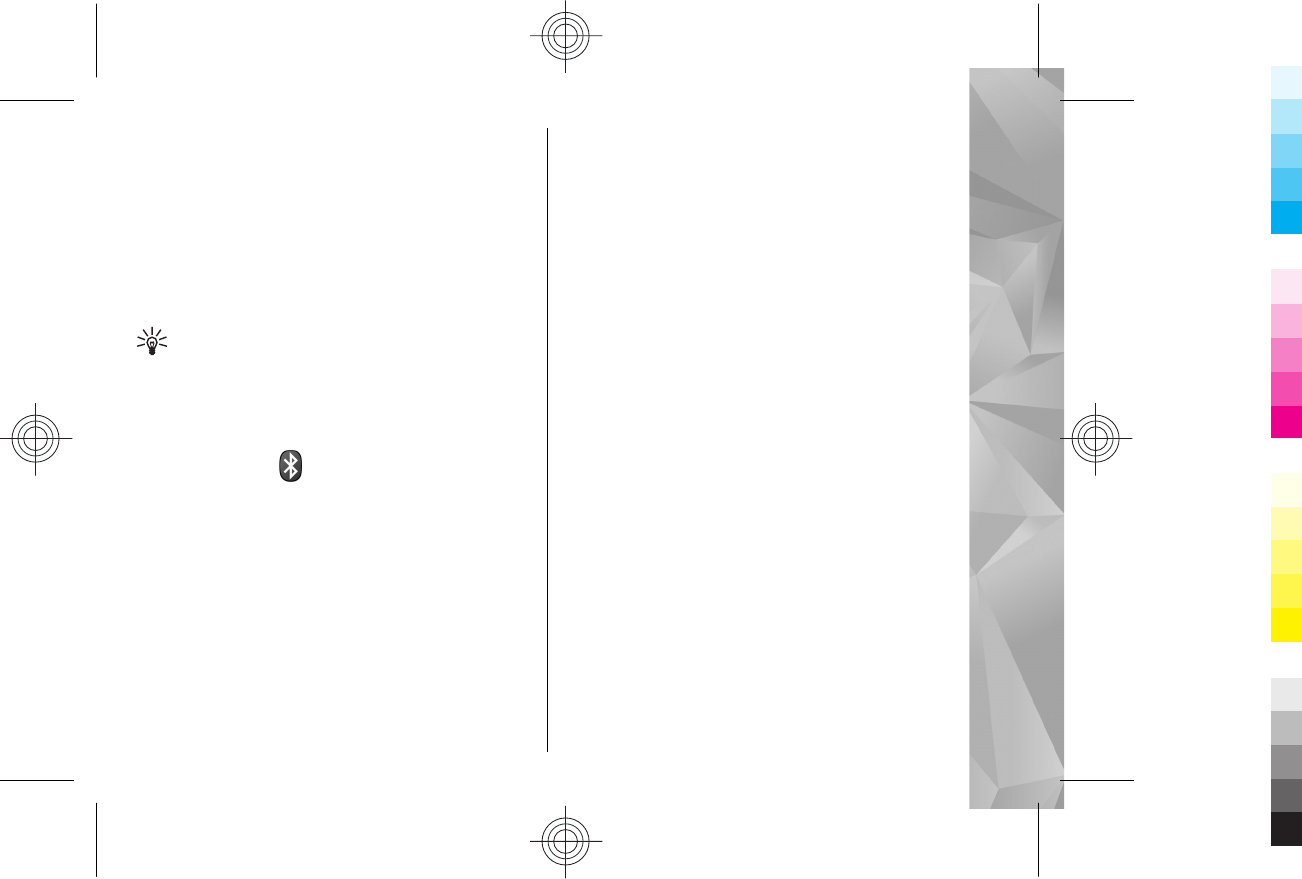
applicable safety requirements when establishing and
using a WLAN connection.
If you move the device to another location within the
WLAN and out of range of a WLAN access point, the
roaming functionality can automatically connect your
device to another access point that belongs to the
same WLAN. As long as you remain within range of
access points that belong to the same network, your
device can stay connected to the network.
Tip: To check the unique media access control
(MAC) address that identifies your device, for
example to configure the MAC address of your
device to a WLAN router, enter *#62209526# in
the home screen. The MAC address is displayed.
Bluetooth
Select Menu > Tools > Connectivity > Bluetooth.
About Bluetooth
Bluetooth technology in your device enables wireless
connections between electronic devices within a range
of 10 metres (33 feet). A Bluetooth connection can be
used to send images, videos, text, business cards,
calendar notes, or to connect wirelessly to devices that
use Bluetooth technology.
Since devices using Bluetooth technology
communicate using radio waves, your device and the
other devices do not need to be in direct line-of-sight.
The two devices only need to be within a maximum of
10 metres of each other, although the connection can
be subject to interference from obstructions such as
walls or other electronic devices.
Several Bluetooth connections can be active at a time.
For example, if your device is connected to a headset,
you can also transfer files to another compatible device
at the same time.
This device is compliant with Bluetooth Specification
2.0 + EDR supporting the following profiles: Dial-Up
Networking (DUN), Object Push Profile (OPP), File
Transfer Profile (FTP), Hands Free Profile (HFP), Headset
Profile (HSP), Basic Imaging Profile (BIP), Remote SIM
Access Profile (SimAP), Device Identification Profile
(DI), Phonebook Access Profile (PBAP), Generic Audio/
Video Distribution Profile (GAVDP), Audio/Video
Remote Control Profile (AVRCP), Advanced Audio
Distribution Profile (A2DP). To ensure interoperability
between other devices supporting Bluetooth
technology, use Nokia approved accessories for this
model. Check with the manufacturers of other devices
to determine their compatibility with this device.
Features using Bluetooth technology increase the
demand on battery power and reduce the battery life.
29
Connectivity
Cyan
Cyan
Magenta
Magenta
Yellow
Yellow
Black
Black
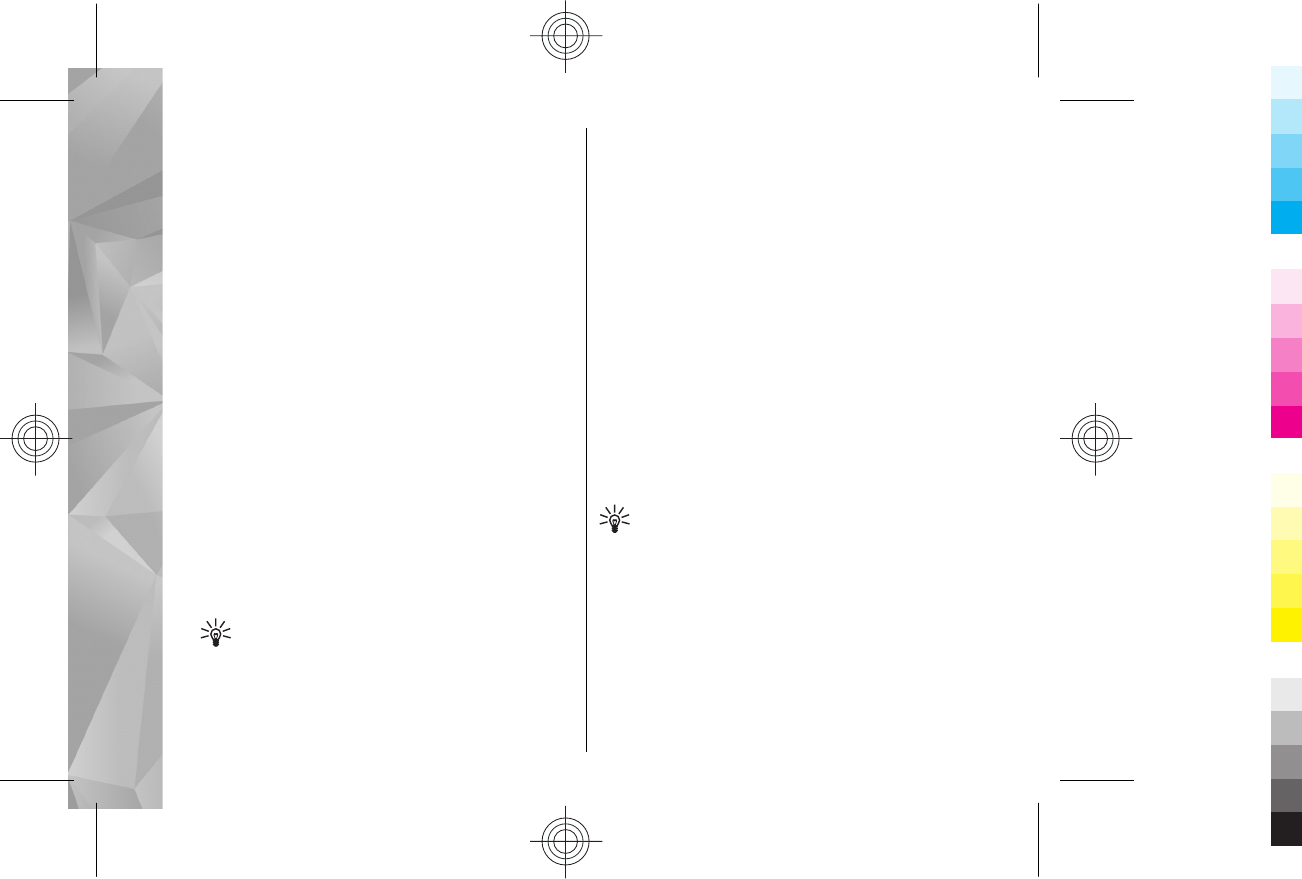
Send and receive data with
Bluetooth
Select Menu > Tools > Connectivity > Bluetooth.
1. When you activate Bluetooth connectivity for the
first time, you are asked to name your device. Give
your device a unique name to make it easy to
recognise if there are several Bluetooth devices
nearby.
2. Select Bluetooth > On.
3. Select My phone's visibility > Shown to all or
Define period. If you select Define period, you
need to define the time during which your device is
visible to others. Your device and the name you
entered can now be seen by other users with
devices using Bluetooth technology.
4. Open the application where the item you want to
send is stored.
5. Select the item and Options > Send > Via
Bluetooth. The device searches for other devices
using Bluetooth technology within range and lists
them.
Tip: If you have sent data using Bluetooth
connectivity before, a list of the previous
search results is displayed. To search for more
Bluetooth devices, select More devices.
6. Select the device with which you want to connect.
If the other device requires pairing before data can
be transmitted, you are asked to enter a passcode.
When the connection has been established, Sending
data is displayed.
The Sent folder in the Messaging application does not
store messages sent using Bluetooth connectivity.
To receive data using Bluetooth connectivity, select
Bluetooth > On and My phone's visibility > Shown
to all to receive data from a non-paired device or
Hidden to receive data from a paired device only.
When you receive data through Bluetooth
connectivity, depending on the settings of an active
profile, a tone sounds, and you are asked if you want
to accept the message in which the data is included. If
you accept, the message is placed in the Inbox folder
in the Messaging application.
Tip: You can access the files in the device or on
the memory card using a compatible accessory
that supports the File Transfer Profile Client
service (for example, a laptop computer).
A Bluetooth connection is disconnected automatically
after sending or receiving data. Only Nokia Ovi Suite
and some accessories such as headsets may maintain
a connection even if not actively used.
30
Connectivity
Cyan
Cyan
Magenta
Magenta
Yellow
Yellow
Black
Black

Security tips
When you are not using Bluetooth connectivity, select
Bluetooth > Off or My phone's visibility >
Hidden.
Do not pair with an unknown device.
31
Connectivity
Cyan
Cyan
Magenta
Magenta
Yellow
Yellow
Black
Black
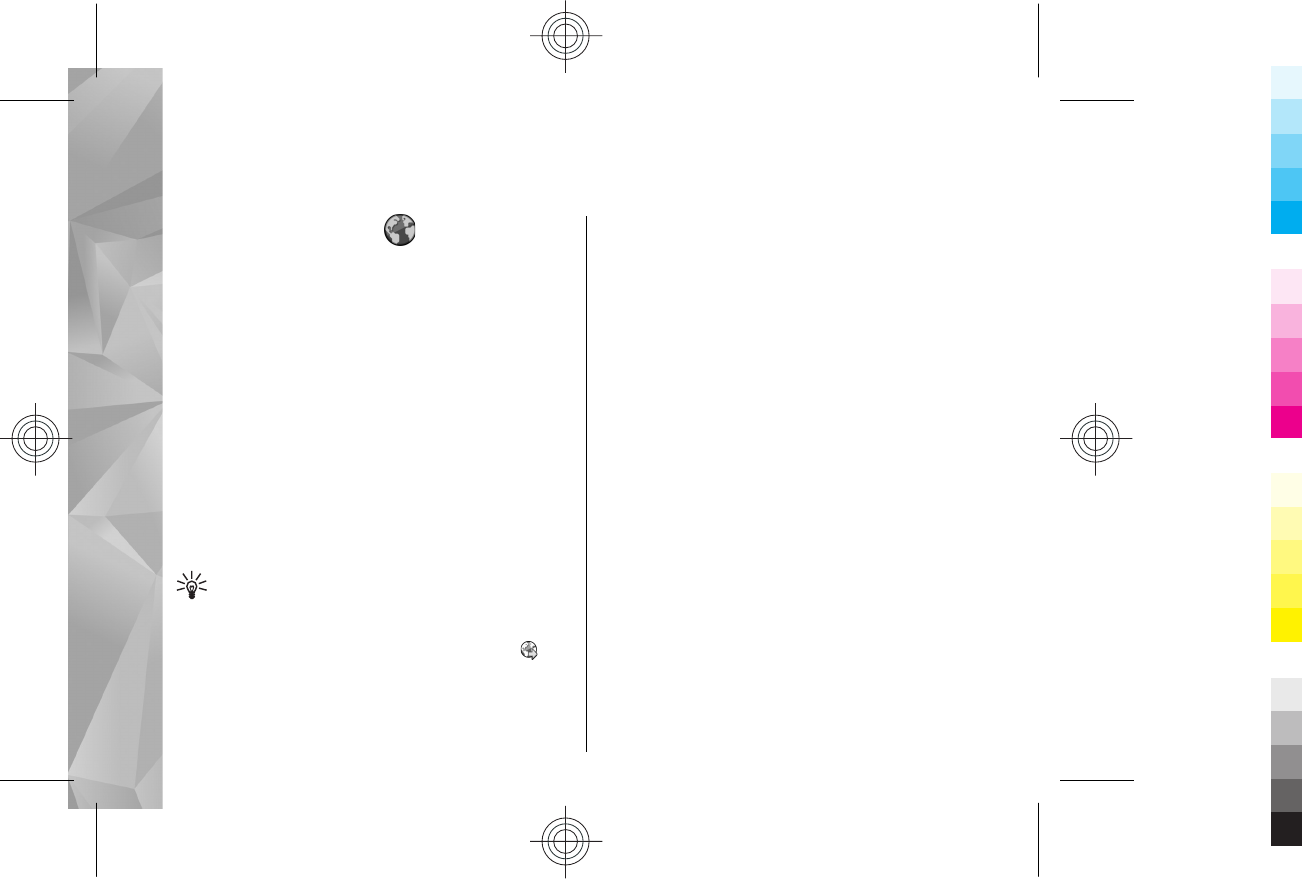
Browser
About Browser
Select Menu > Web.
With the Browser application, you can view hypertext
markup language (HTML) web pages on the internet as
originally designed. You can also browse web pages
that are designed specifically for mobile devices, and
use extensible hypertext markup language (XHTML), or
the wireless markup language (WML).
To browse the web, you need to have an internet
access point configured in your device. The browser
requires network service.
Browse the web
Select Menu > Web.
Shortcut: To start the browser, press and hold
0 in the home screen.
To browse the web, in the bookmarks view, select a
bookmark, or start to enter a web address (the field
opens automatically), and select Go to.
Some web pages may contain material, such as
graphics and sounds, that requires a large amount of
memory to view. If your device runs out of memory
while loading such a web page, the graphics on the
page are not shown.
To browse web pages with graphics disabled, to save
memory and increase the page loading speed, select
Options > Settings > Page > Load content >
Text only.
To enter a web address, select Options > Go to >
New web page.
To refresh the content of the web page, select
Options > Web page options > Reload.
To save the current web page as a bookmark, select
Options > Web page options > Save as
bookmark.
To view snapshots of the web pages you have visited
during the current browsing session, select Back
(available if History list is activated in the browser
settings and the current web page is not the first web
page you visit).
To prevent or allow the automatic opening of multiple
windows, select Options > Web page options >
Block pop-ups or Allow pop-ups.
32
Browser
Cyan
Cyan
Magenta
Magenta
Yellow
Yellow
Black
Black
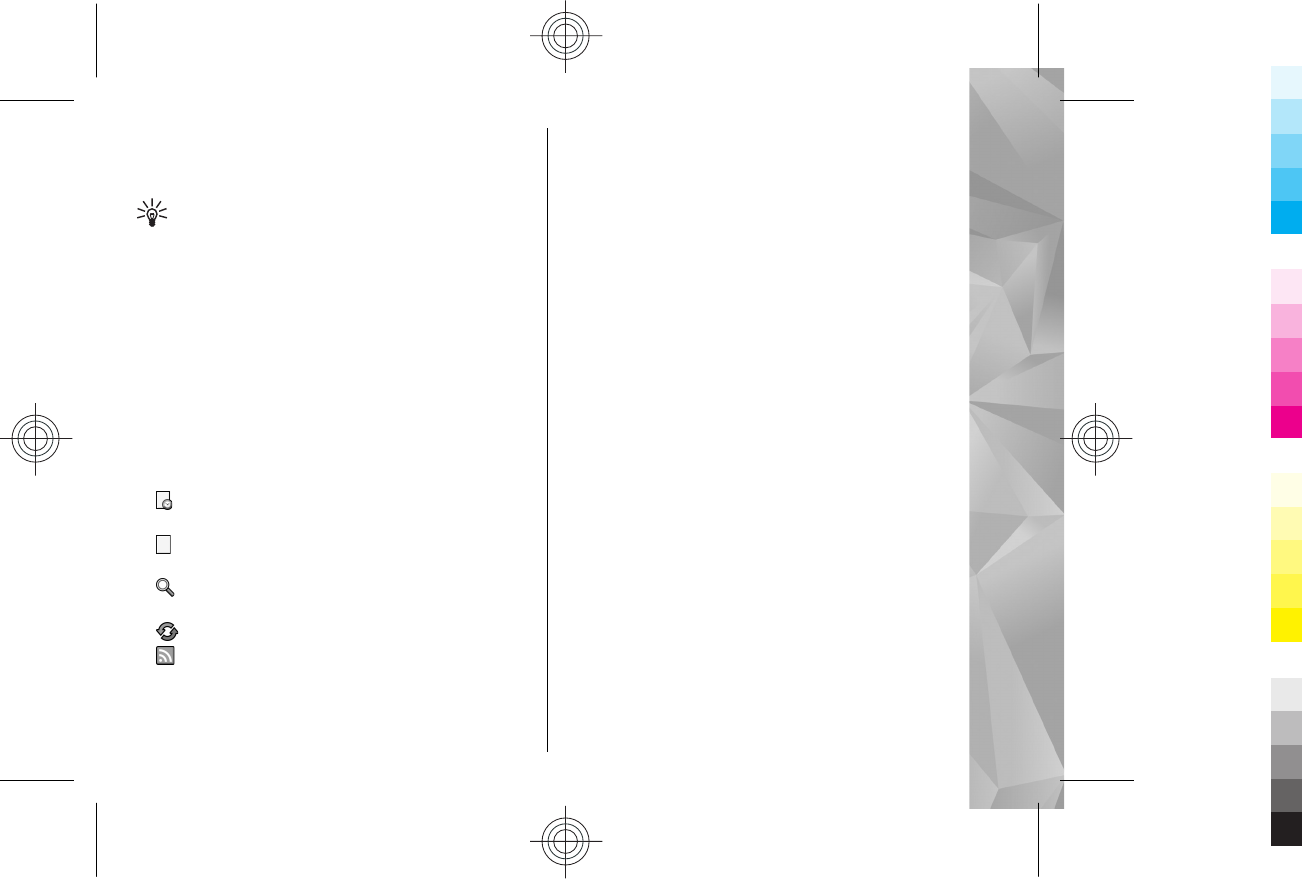
To view the shortcut key map, select Options >
Keypad shortcuts. To edit the shortcut keys, select
Edit.
Tip: To minimise the browser without exiting
the application or connection, press the end key
once.
Browser toolbar
The browser toolbar helps you select frequently used
functions of the browser.
To open the toolbar, press and hold the scroll key on a
blank spot on a web page. To move within the toolbar,
scroll left or right. To select a feature, press the scroll
key.
From the toolbar, select from the following:
● Recently visited pages — View a list of the web
addresses you visit frequently.
● Overview — View an overview of the current
web page.
● Search by keyword — Search on the current
web page.
● Reload — Refresh the web page.
●Subscribe to web feeds (if available) — View a
list of available web feeds on the current web page,
and subscribe to a web feed.
Empty the cache
The information or services you have accessed are
stored in the cache memory of the device.
A cache is a memory location that is used to store data
temporarily. If you have tried to access or have
accessed confidential information requiring
passwords, empty the cache after each use.
To empty the cache, select Options > Clear privacy
data > Cache.
33
Browser
Cyan
Cyan
Magenta
Magenta
Yellow
Yellow
Black
Black
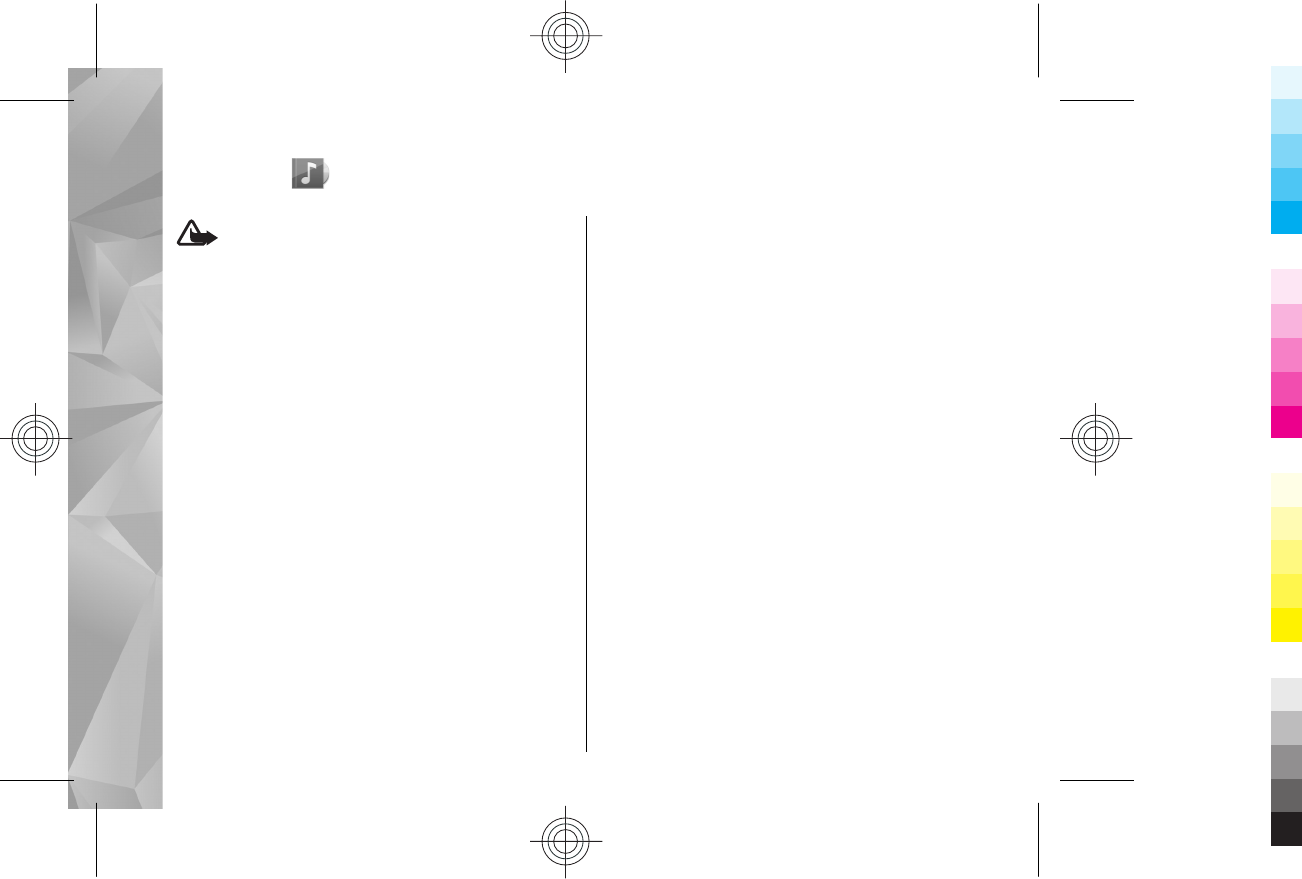
Music
Warning: Continuous exposure to high volume
may damage your hearing. Listen to music at a
moderate level, and do not hold the device near your
ear when the loudspeaker is in use.
Digital rights management (DRM) protected content
comes with an associated licence that defines your
rights to use the content.
If your device has OMA DRM-protected content, to back
up both the licence and the content, use the backup
feature of Nokia Ovi Suite.
Other transfer methods may not transfer the licence
which need to be restored with the content for you to
be able to continue the use of OMA DRM-protected
content after the device memory is formatted. You may
also need to restore the licence in case the files on your
device get corrupted.
If your device has WMDRM-protected content, both the
licence and the content will be lost if the device
memory is formatted. You may also lose the licence and
the content if the files on your device get corrupted.
Losing the licence or the content may limit your ability
to use the same content on your device again. For more
information, contact your service provider.
Some licence may be connected to a specific SIM card,
and the protected content can be accessed only if the
SIM card is inserted in the device.
For more information on music player, FM radio,
internet radio, and Nokia Podcasting, see the extended
user guide on the product support pages of the Nokia
website.
FM radio
The FM radio depends on an antenna other than the
wireless device antenna. A compatible headset or
accessory needs to be attached to the device for the FM
radio to function properly.
To open the radio, select Menu > Music > FM
radio.
When you open the radio for the first time, a wizard
helps you to save local radio stations (network service).
To check availability and costs of the visual service and
station directory services, contact your service
provider.
Listen to the radio
Select Menu > Music > FM radio.
34
Music
Cyan
Cyan
Magenta
Magenta
Yellow
Yellow
Black
Black
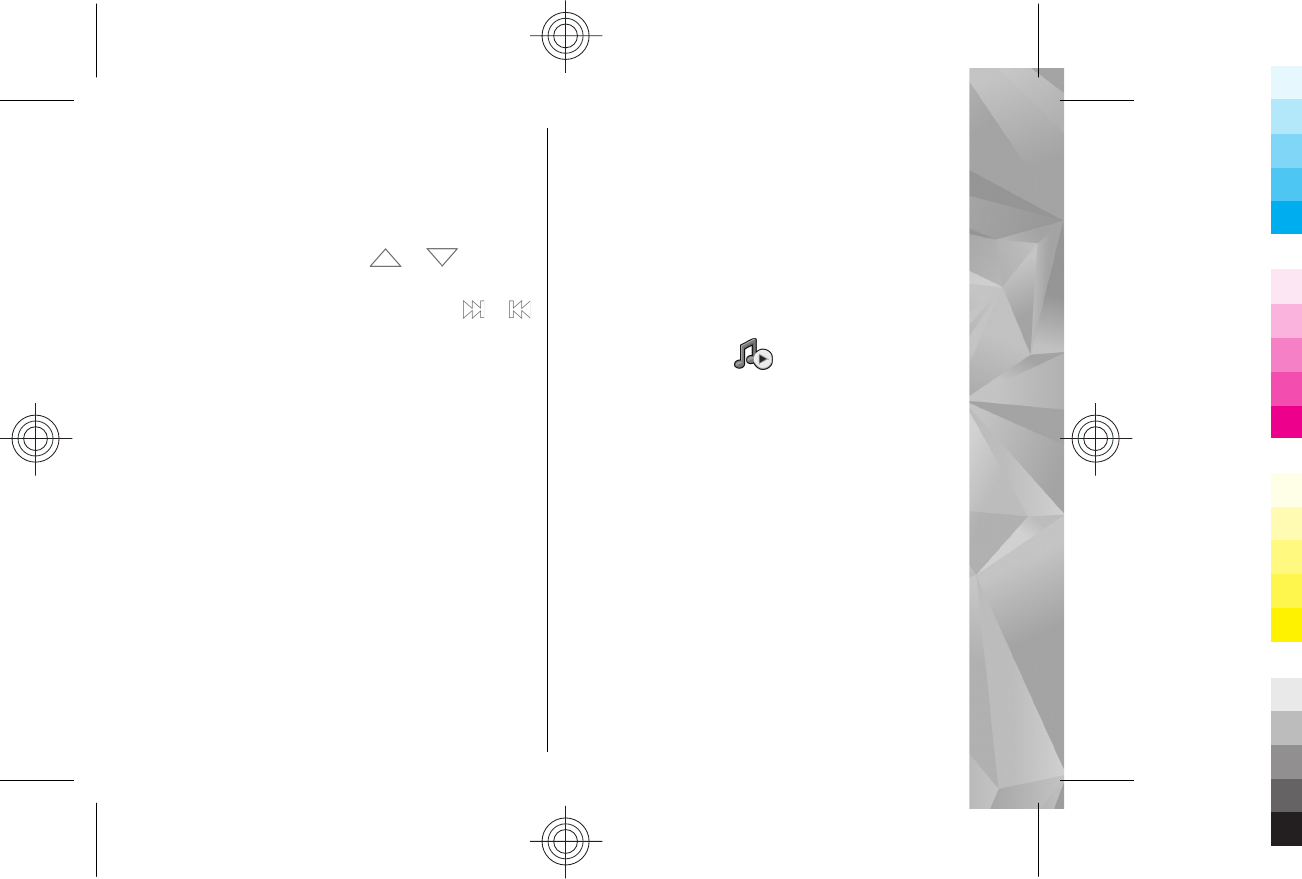
The quality of the radio broadcast depends on the
coverage of the radio station in that particular area.
You can make a call or answer an incoming call while
listening to the radio. The radio is muted when there
is an active call.
To start a station search, select or .
If you have saved radio stations in your device, to go
to the next or previous saved station, select or .
Select Options and from the following:
●Activate loudspeaker — Listen to the radio using
the loudspeaker.
●Manual tuning — Change the frequency manually.
●Station directory — View available stations based
on location (network service).
●Save station — Save the station to which you are
currently tuned to your station list.
●Stations — Open the list of your saved stations.
●Play in background — Return to the standby mode
while listening to the FM radio in the background.
Nokia Music Store
Select Menu > Music > Music store.
In the Nokia Music Store (network service) you can
search, browse, and purchase music to download to
your device. To purchase music, you first need to
register for the service.
To access the Nokia Music Store, you must have a valid
internet access point defined in the device.
Nokia Music Store is not available for all countries or
regions.
To find more music in the different categories, select
Options > Find in Music store.
To select the access point to use with the Nokia Music
Store, select Default access point.
Music player
Music player supports files formats such as AAC, AAC+,
eAAC+, MP3, and WMA. Music player does not
necessarily support all features of a file format or all
the variations of file formats.
You can also use Music player to listen to podcast
episodes. Podcasting is the method for delivering
audio or video content over the internet using either
RSS or Atom technologies for playback on mobile
devices and PCs.
Play a song or a podcast episode
To open Music player, select Menu > Music > Music
player.
You may have to refresh the music and podcast
libraries after you have updated the song or podcast
selection in your device. To add all available items to 35
Music
Cyan
Cyan
Magenta
Magenta
Yellow
Yellow
Black
Black
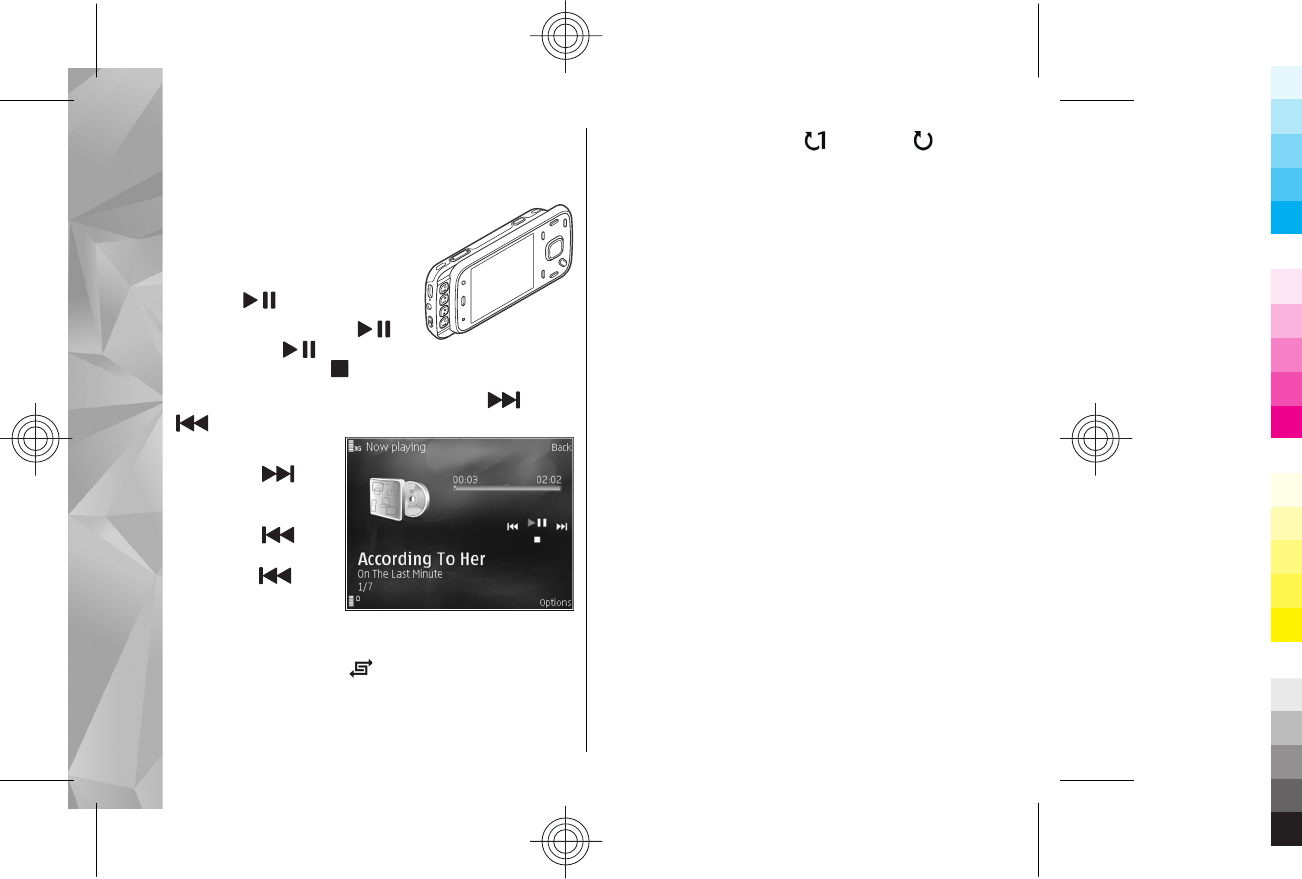
the library, in the Music player main view, select
Options > Refresh library.
To play a song or a podcast episode, do the following:
1. Select categories to navigate
to the song or podcast
episode you want to hear.
2. To play the selected files,
press .
To pause playback, press ; to
resume, press again. To
stop playback, press .
To fast forward or rewind, press and hold or
.
To go to the next
item, press . To
return to the
beginning of the
item, press . To
skip to the previous
item, press again
within 2 seconds after
a song or podcast has
started.
To switch random play ( ) on or off, select Options >
Shuffle play.
To repeat the current item ( ), all items ( ), or to
switch repeat off, select Options > Repeat.
If you play podcasts, shuffle and repeat are
automatically switched off.
To adjust the volume, press the volume key.
To modify the tone of the music playback, select
Options > Equaliser.
To modify the balance and stereo image or to enhance
bass, select Options > Settings.
To view a visualisation during playback, select
Options > Show visualisation.
To return to the standby mode and leave the player
playing in the background, press the end key, or to
switch to another open application, press and hold the
menu key.
To close the player, select Options > Exit.
FM transmitter
About the FM transmitter
Some countries may restrict the use of the FM
transmitter. Before using the feature in a foreign
country, see www.nokia.com/fmtransmitter to check
if use is permitted.
36
Music
Cyan
Cyan
Magenta
Magenta
Yellow
Yellow
Black
Black
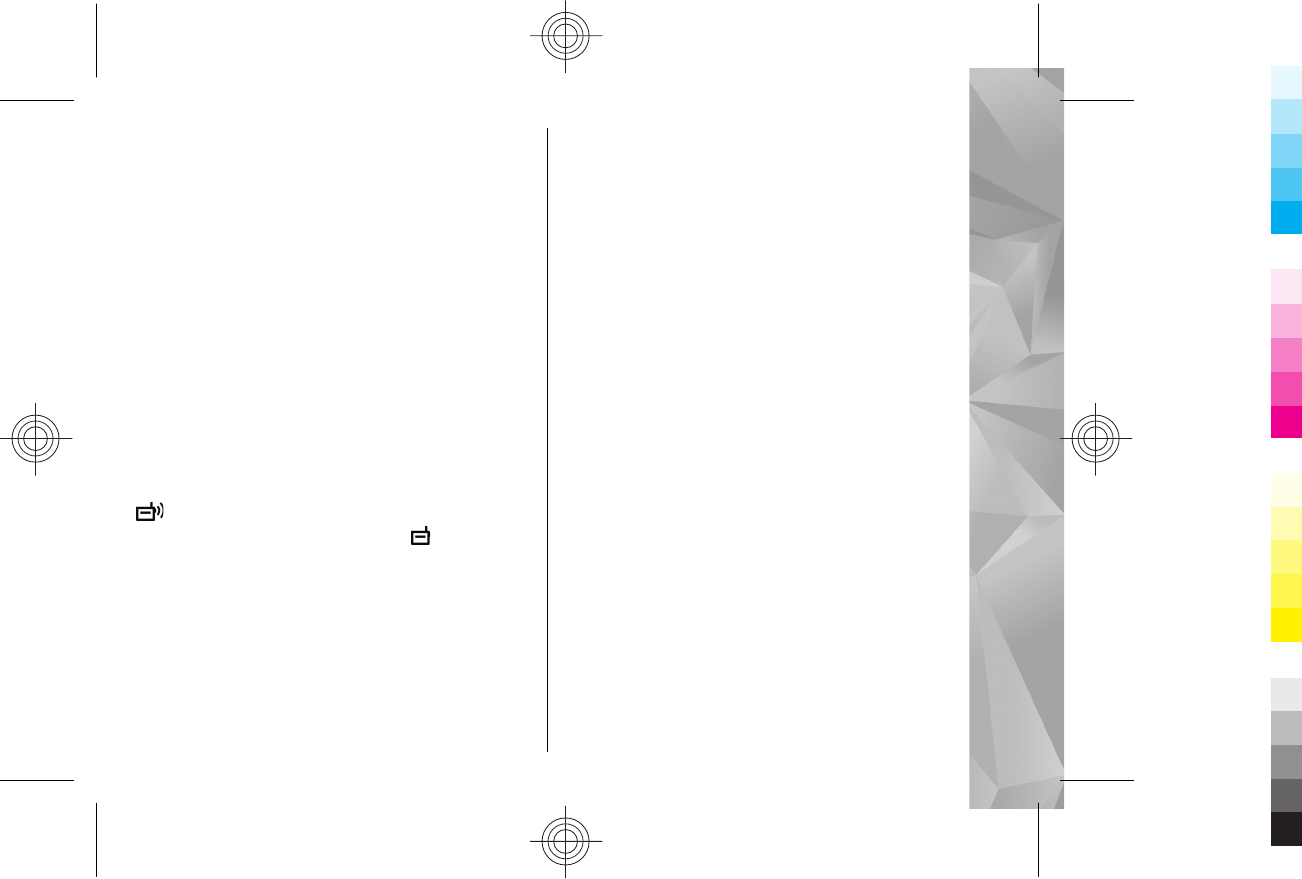
With the FM transmitter, you can play songs in your
device through any compatible FM receiver, such as a
car radio or a home stereo system.
The operating distance of the FM transmitter is up to a
maximum of 2 metres (6.5 feet). The transmission may
be subject to interference due to obstructions, such as
walls, other electronic devices, or from public radio
stations. The FM transmitter may cause interference to
nearby FM receivers operating on the same frequency.
To avoid interference, always search for a free FM
frequency on the receiver before using the FM
transmitter.
The FM transmitter cannot be used at the same time as
the FM radio of your device.
The operating frequency range of the transmitter is
from 88.1 to 107.9 MHz.
When the transmitter is on and transmitting sound,
is displayed in the standby mode. If the transmitter
is on, but not transmitting anything, is displayed
and a periodic tone sounds. If the transmitter is not
transmitting anything for several minutes, it switches
off automatically.
Play a song using FM transmitter
Select Menu > Music > Music player.
To play a song stored in your device through a
compatible FM receiver, do the following:
1. Select a song or a playlist to be played.
2. In the Now playing view, select Options > FM
transmitter.
3. To activate the FM transmitter, select FM
transmitter > On, and enter a frequency that is
free from other transmissions. For example, if the
frequency 107.8 MHz is free in your area and you
tune your FM receiver to it, you must also tune the
FM transmitter to 107.8 MHz.
4. Tune the receiving device to the same frequency,
and select Options > Exit.
To adjust the volume, use the volume function in the
receiving device. Continuous exposure to high volume
may damage your hearing. Listen to music at a
moderate level, and do not hold the device near your
ear when the loudspeaker is in use.
If music is not played for several minutes, the
transmitter is automatically deactivated.
FM transmitter settings
Select Menu > Music player > FM transmitter.
To activate the FM transmitter, select FM
transmitter > On.
To set a frequency manually, select Frequency and
enter the desired value.
To list the previously used frequencies, select
Options > Last frequencies.
37
Music
Cyan
Cyan
Magenta
Magenta
Yellow
Yellow
Black
Black

Positioning (GPS)
You can use applications such as GPS data to determine
your location, or measure distances and coordinates.
These applications require a GPS connection.
About GPS
The Global Positioning System (GPS) is operated by the
government of the United States, which is solely
responsible for its accuracy and maintenance. The
accuracy of location data can be affected by
adjustments to GPS satellites made by the United
States government and is subject to change with the
United States Department of Defense civil GPS policy
and the Federal Radionavigation Plan. Accuracy can
also be affected by poor satellite geometry. Availability
and quality of GPS signals may be affected by your
location, buildings, natural obstacles, and weather
conditions. GPS signals may not be available inside
buildings or underground and may be impaired by
materials such as concrete and metal.
GPS should not be used for precise location
measurement, and you should never rely solely on
location data from the GPS receiver and cellular radio
networks for positioning or navigation.
The trip meter has limited accuracy, and rounding
errors may occur. Accuracy can also be affected by
availability and quality of GPS signals.
Different positioning methods can be enabled or
disabled in positioning settings.
Assisted GPS (A-GPS)
Your device also supports assisted GPS (A-GPS).
A-GPS is requires network support.
Assisted GPS (A-GPS) is used to retrieve assistance data
over a packet data connection, which assists in
calculating the coordinates of your current location
when your device is receiving signals from satellites.
When you activate A-GPS, your device receives useful
satellite information from an assistance data server
over the cellular network. With the help of assisted
data, your device can obtain the GPS position faster.
Your device is preconfigured to use the Nokia A-GPS
service, if no service provider-specific A-GPS settings
are available. The assistance data is retrieved from the
Nokia A-GPS service server only when needed.
To disable the A-GPS service, select Menu >
Applications > GPS data and Options >
38
Positioning (GPS)
Cyan
Cyan
Magenta
Magenta
Yellow
Yellow
Black
Black
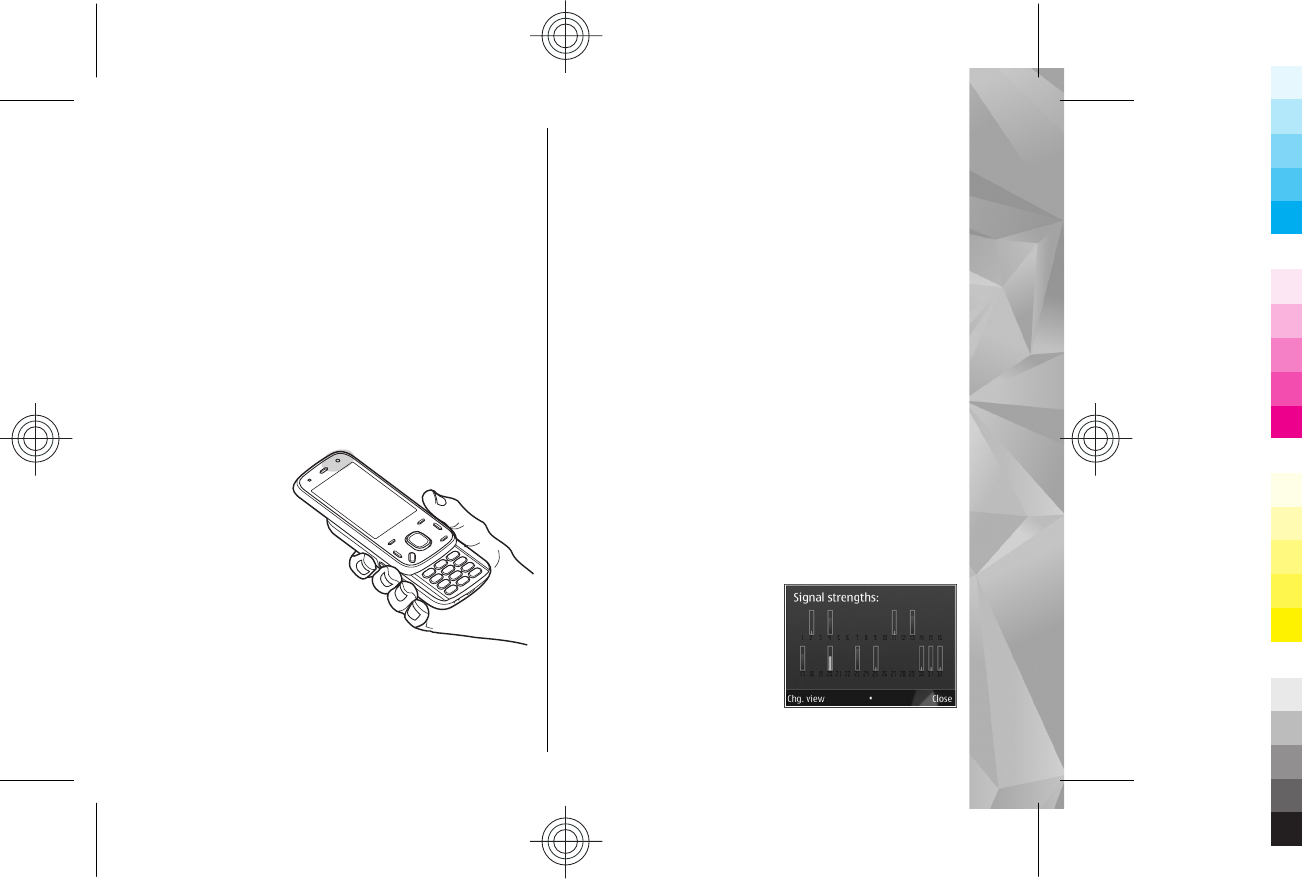
Positioning settings > Positioning methods >
Assisted GPS > Disable.
You must have an internet access point defined in the
device to retrieve assistance data from the Nokia A-GPS
service over a packet data connection. The access point
for A-GPS can be defined in positioning settings. A
wireless LAN (WLAN) access point cannot be used for
this service. Only a packet data internet access point
can be used. Your device asks you to select the internet
access point when GPS is used for the first time.
Hold your device correctly
When using the GPS receiver, ensure you do not cover
the antenna with your hand.
Establishing a GPS
connection may
take from a couple
of seconds to
several minutes.
Establishing a GPS
connection in a
vehicle may take
longer.
The GPS receiver
draws its power
from the device battery. Using the GPS receiver may
drain the battery faster.
Tips on creating a GPS
connection
If your device cannot find the satellite signal, consider
the following:
●If you are indoors, go outdoors to receive a better
signal.
●If you are outdoors, move to a more open space.
●Ensure that your hand does not cover the GPS
antenna of your device.
●If the weather conditions are bad, the signal
strength may be affected.
●Some vehicles have tinted (athermic) windows,
which may block the satellite signals.
Check satellite signal status
To check how many satellites your device has found,
and whether your device is receiving satellite signals,
select Menu > Applications > GPS data and
Options > Satellite status.
If your device has found
satellites, a bar for each
satellite is displayed in the
satellite information view.
The longer the bar, the
stronger the satellite signal
is. When your device has
received enough data from the satellite signal to 39
Positioning (GPS)
Cyan
Cyan
Magenta
Magenta
Yellow
Yellow
Black
Black

calculate the coordinates of your location, the bar
colour changes.
Initially, your device must receive signals from at least
four satellites to be able to calculate the coordinates
of your location. When the initial calculation has been
made, it may be possible to continue calculating the
coordinates of your location with three satellites.
However, the accuracy is generally better when more
satellites are found.
40
Positioning (GPS)
Cyan
Cyan
Magenta
Magenta
Yellow
Yellow
Black
Black

Nokia Maps
For more information on Maps, see the extended user
guide on the product support pages of the Nokia
website.
About Maps
With Maps, you can see your current location on the
map, browse maps of different cities and countries,
search for places, plan routes from one location to
another, save locations, and send them to compatible
devices. You can also purchase licences for traffic
information and navigation services, if available for
your country or region.
When you use Maps for the first time, you may need to
select an internet access point for downloading maps.
If you browse to an area which is not covered by maps
already downloaded in your device, a map for the area
is automatically downloaded through the internet.
Some maps may be available in your device or on a
memory card. You can also use the Nokia Map Loader
PC software to download maps. To install Nokia Map
Loader to a compatible PC, see www.nokia.com/
maps.
Tip: To avoid data transfer costs, you can also use
Maps without an internet connection, and
browse the maps that are saved in your device
or memory card.
Note: Downloading content such as maps,
satellite images, voice files, guides or traffic
information may involve transmission of large
amounts of data (network service).
Almost all digital cartography is inaccurate and
incomplete to some extent. Never rely solely on the
cartography that you download for use in this device.
Network positioning
Select Menu > Maps.
You can use the mobile network to find your current
location, even indoors. This is faster but less accurate
than with GPS, and you cannot use the location as a
starting point for navigation.
To use the mobile network for positioning, select the
network-based positioning method from the device
settings. When you start the Maps application and your 41
Nokia Maps
Cyan
Cyan
Magenta
Magenta
Yellow
Yellow
Black
Black
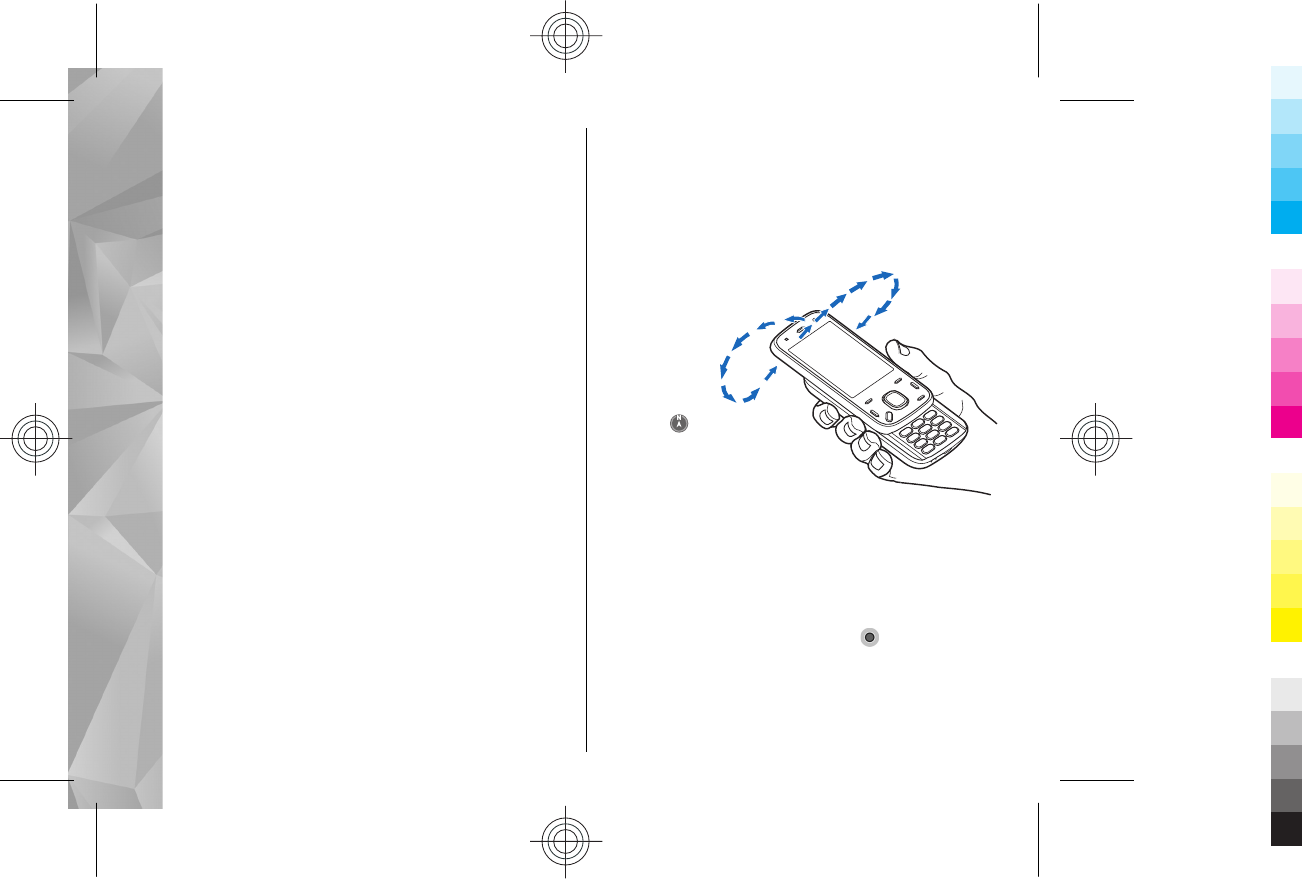
GPS connection is ready, GPS replaces mobile network
as the positioning method.
Compass
Select Menu > Maps.
Your device has an internal compass. When the
compass is enabled, the circle around the compass is
green, and the map view rotates automatically
according to the direction to which the top of the
device is pointing.
The compass has limited accuracy. Electromagnetic
fields, metal objects, or other external circumstances
may also affect the accuracy of the compass. The
compass should always be properly calibrated.
The compass is active by default. To turn off the
compass, in the Maps main view, select Options >
Tools > Turn compass off. When the compass is not
turned on, the circle around the compass is white, and
the map view does not rotate automatically. Turning
off the compass is only valid for the current session.
When you open Maps the next time, it will be turned
on automatically.
Before you can calibrate the compass you should check
the following:
●GPS connection is active.
●The device sensors are on. Select Menu >
Settings > Phone > Sensor settings >
Sensors > On.
●The map is zoomed to your GPS position. Otherwise
the compass icon is not shown.
To calibrate the compass:
Rotate the
device around
all axes in a
continuous
movement
until the
calibration
indicator
changes its
colour to
green . If the
indicator is
yellow , the accuracy of the compass is low. If the
indicator is red, the compass is not calibrated.
Move on a map
When the GPS connection is active, shows your
current location on the map.
To view your current or last known location, select
Options > My position.
42
Nokia Maps
Cyan
Cyan
Magenta
Magenta
Yellow
Yellow
Black
Black

To move on the map, scroll up, down, left, or right with
the scroll key. The map is oriented towards north by
default.
When you have an active data connection and browse
the map on the display, a new map is automatically
downloaded if you scroll to an area not covered by the
maps that have already been downloaded. The maps
are automatically saved in the device memory or on a
compatible memory card, if inserted.
To zoom in and out on the map, press * and #.
To change the map type, select Options > Map
mode.
Display indicators
The GPS indicator shows the availability of
the satellite signals. One bar is one satellite. When the
device tries to find satellite signals, the bar is yellow.
When the device receives enough data from the
satellites for GPS to calculate your location, the bar
turns green. The more green bars, the more reliable
the location calculation.
Initially, your device must receive signals from at least
four satellites to calculate your location. After the
initial calculation, signals from three satellites may be
enough.
The data transfer indicator shows the
internet connection used, and the amount of data
transferred since the application started.
Plan a route
To plan a route, scroll to your start point on the map,
press the scroll key, and select Add to route. To add
the destination and more locations to the route, select
Add new route point. If you want to use your current
position as the starting point, add the destination to
the route.
To change the order of the locations in the route, scroll
to a location, press the scroll key, and select Move.
Scroll to the place where you want to move the
location, and select Select.
To edit the route, press the scroll key, and select Edit
route.
To show the route on the map, select Show route.
To navigate to the destination by car or on foot, if you
have purchased a licence for these services, select
Show route > Options > Start driving or Start
walking.
To save the route, select Show route > Options >
Save route.
43
Nokia Maps
Cyan
Cyan
Magenta
Magenta
Yellow
Yellow
Black
Black
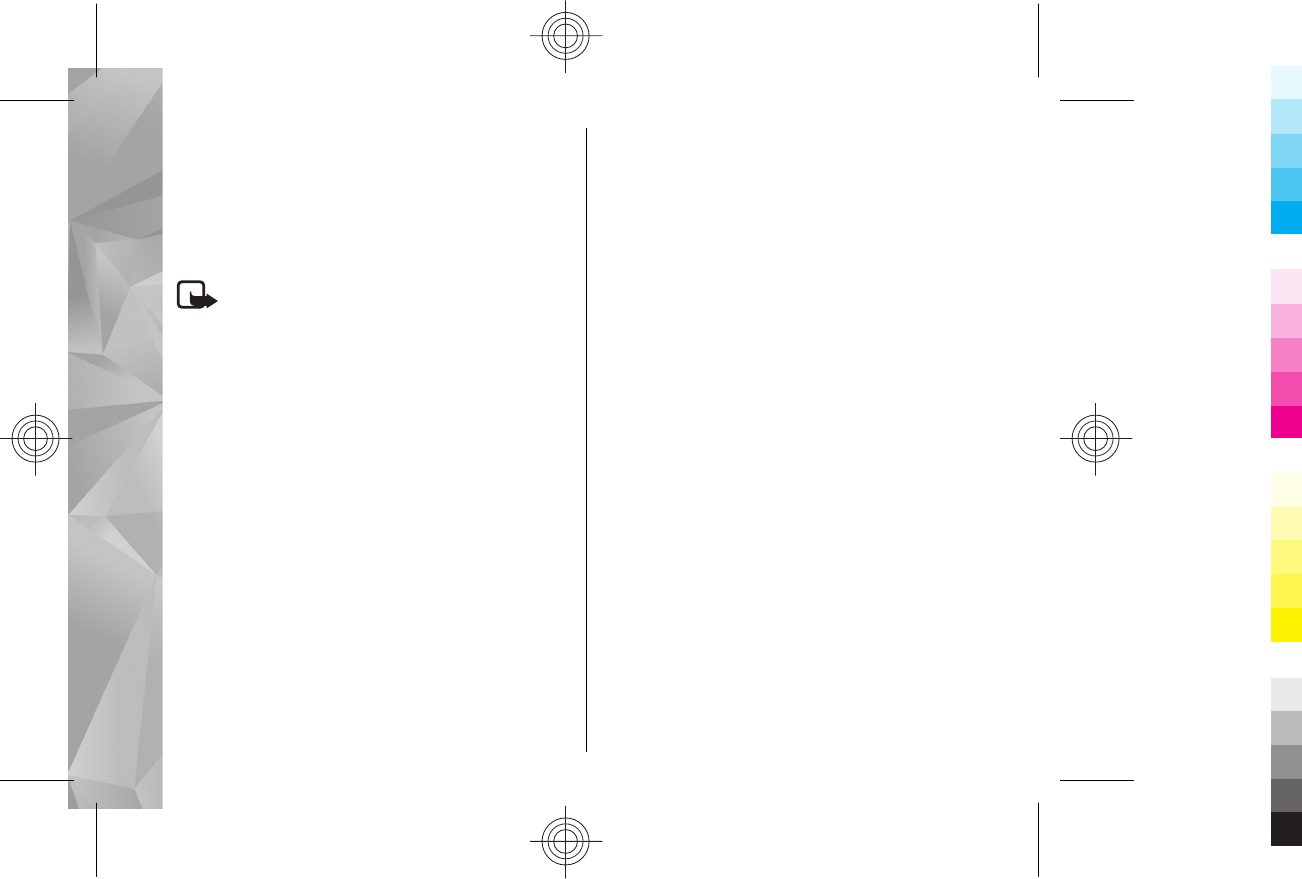
Traffic and safety
The real-time traffic information service provides
information about traffic events that may affect your
travel. You can purchase and download the traffic
information service to your device, if available in your
country or region.
Note: Downloading content such as maps,
satellite images, voice files, guides or traffic
information may involve transmission of large
amounts of data (network service).
Content such as satellite images, guides, weather and
traffic information and related services are generated
by third parties independent of Nokia. The content may
be inaccurate and incomplete to some extent and is
subject to availability. Never rely solely on the
aforementioned content and related services.
To purchase a licence for the traffic information
service, select Options > Shop & Licenses > Shop >
Traffic & Safety %s.
When you purchase the licence, you also get the
notification service for speed cameras, if available for
your country or region.
The location of speed cameras can be shown on your
route during navigation and tracking, if this feature is
enabled. Some jurisdictions prohibit or regulate the
use of speed camera location data. Nokia is not
responsible for the accuracy, or the consequences of
use of speed camera location data.
To view information about traffic events, select
Options > Traffic info. The events are shown on the
map as triangles and lines.
To view the details of an event, including possible
rerouting options, select Options > Open.
To update the traffic information, select Update traffic
info.
To set your device to plan a new route automatically
to avoid traffic events, in the main view, select
Options > Tools > Settings > Navigation >
Reroute due to traffic.
44
Nokia Maps
Cyan
Cyan
Magenta
Magenta
Yellow
Yellow
Black
Black
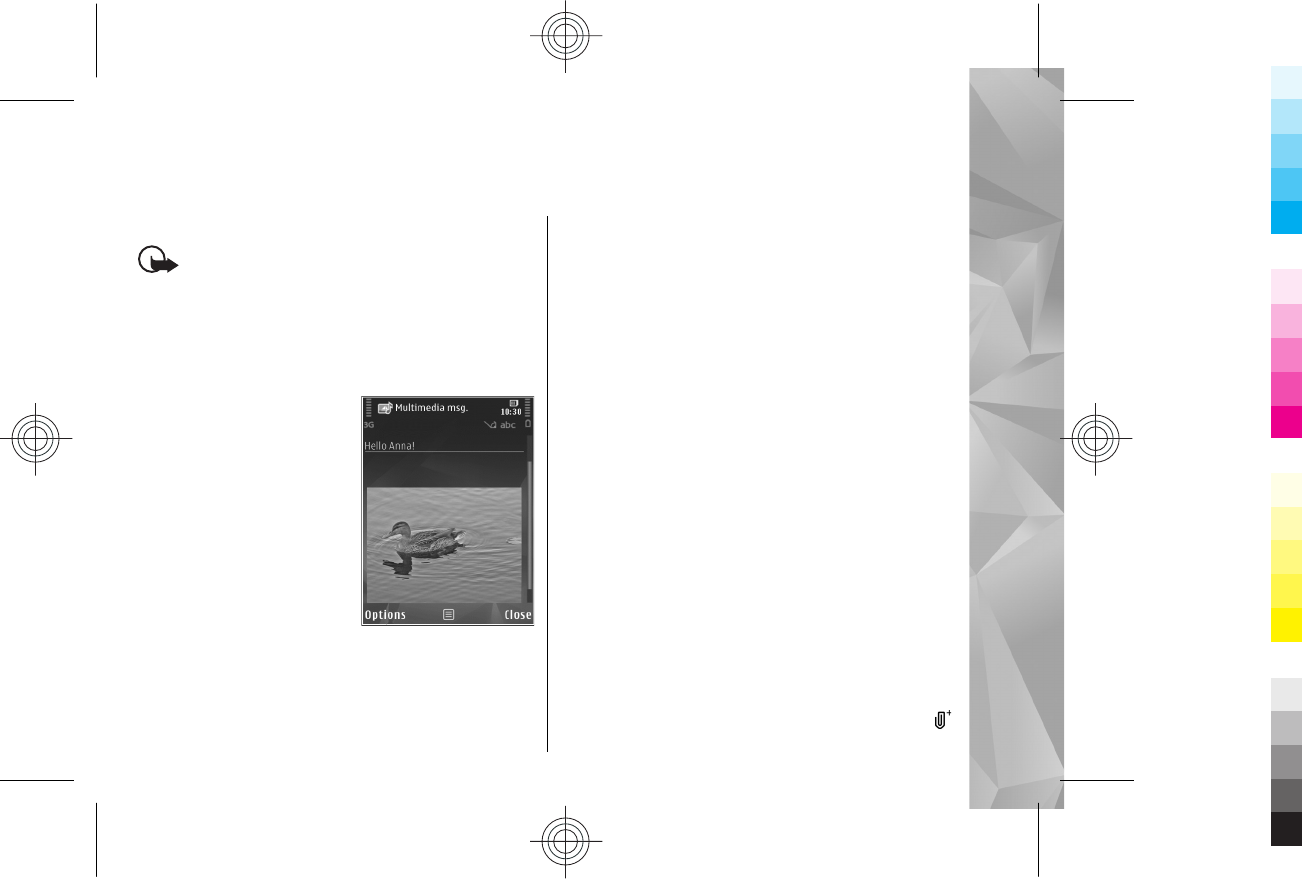
Write and send messages
Select Menu > Messaging.
Important: Exercise caution when opening
messages. Messages may contain malicious software
or otherwise be harmful to your device or PC.
Before you can create a multimedia message or write
an e-mail, you must have the correct connection
settings defined.
The wireless network may
limit the size of MMS
messages. If the inserted
picture exceeds this limit, the
device may make it smaller so
that it can be sent by MMS.
Only devices that have
compatible features can
receive and display
multimedia messages. The
appearance of a message may
vary depending on the
receiving device.
Check the size limit of e-mail messages with your
service provider. If you attempt to send an e-mail
message that exceeds the size limit of the e-mail
server, the message is left in the Outbox folder, and the
device attempts to resend it periodically. Sending an e-
mail requires a data connection, and continuous
attempts to resend the e-mail may incur charges from
your service provider. In the Outbox folder, you can
delete such a message or move it to the Drafts folder.
Messaging requires network services.
1. To send a text or a multimedia message, select New
message.
To send an audio or e-mail message, select
Options > Create message, and the relevant
option.
2. To select recipients or groups from the contacts list,
select To. To enter the recipient’s phone number or
e-mail address manually, select the To field. To add
a semicolon (;) that separates the recipients, press
*.
3. In the Subject field, enter the subject of the e-mail
or multimedia message. If the Subject field is not
visible, select Options > Message header fields
to change the fields that are visible.
4. In the message field, write the message.
5. To add an object to a message or e-mail, select
and the relevant type of content.
45
Write and send messages
Cyan
Cyan
Magenta
Magenta
Yellow
Yellow
Black
Black
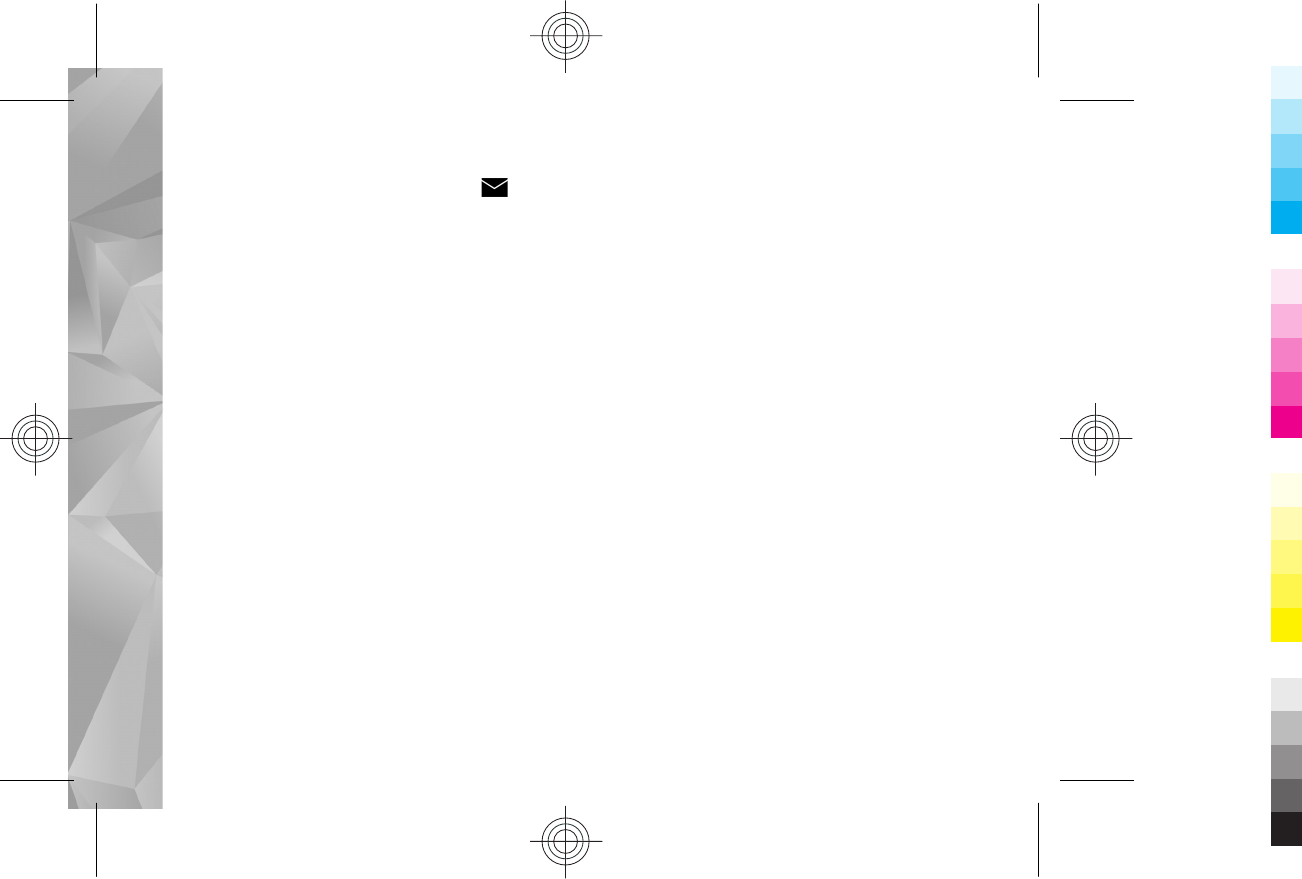
The message type may change to multimedia
message based on the inserted content.
6. To send the message or e-mail, select , or press
the call key.
Your device supports text messages beyond the limit
for a single message. Longer messages are sent as two
or more messages. Your service provider may charge
accordingly. Characters with accents, other marks, or
some language options take more space, and limit the
number of characters that can be sent in a single
message.
46
Write and send messages
Cyan
Cyan
Magenta
Magenta
Yellow
Yellow
Black
Black

Make calls
For more information on different call types, options
during calls, speed dialling, voice dialling, call waiting,
video sharing,internet calls, and log, see the extended
user guide on the product support pages of the Nokia
website.
Voice calls
1. In the standby mode, enter the phone number,
including the area code. To remove a number, press
C.
For international calls, press * twice for the +
character (which replaces the international access
code), and enter the country code, area code (omit
the leading zero if necessary), and phone number.
The character + as a replacement for the
international access code may not work in all
regions. In this case, enter the international access
code directly.
2. To make the call, press the call key.
3. To end the call (or to cancel the call attempt), press
the end key.
Pressing the end key always ends a call, even if
another application is active.
To make a call from Contacts, select Menu >
Contacts. Scroll to the desired name, or enter the first
letters of the name to the search field. To call the
contact, press the call key. If you have saved several
numbers for a contact, select the desired number from
the list, and press the call key.
Make a video call
When you make a video call (network service), you can
see a real-time, two-way video between you and the
recipient of the call. The live video image, or video
image captured by the camera in your device is shown
to the video call recipient.
To be able to make a video call, you must have a USIM
card and be in the coverage of a UMTS network. For
availability of and subscription to video call services,
contact your network service provider.
A video call can only be made between two parties. The
video call can be made to a compatible mobile device
or an ISDN client. Video calls cannot be made while
another voice, video, or data call is active.
Icons
47
Make calls
Cyan
Cyan
Magenta
Magenta
Yellow
Yellow
Black
Black

You are not receiving video (the recipient is not
sending video or the network is not transmitting it).
You have denied video sending from your device.
To send a still image instead, select Menu > Tools >
Settings and Phone > Call > Image in video call.
Even if you denied video sending during a video call,
the call is still charged as a video call. Check the pricing
with your service provider.
1. To start a video call, enter the phone number in the
standby mode, or select Contacts and a contact.
2. Select Options > Call > Video call.
3. To end the video call, press the end key.
48
Make calls
Cyan
Cyan
Magenta
Magenta
Yellow
Yellow
Black
Black
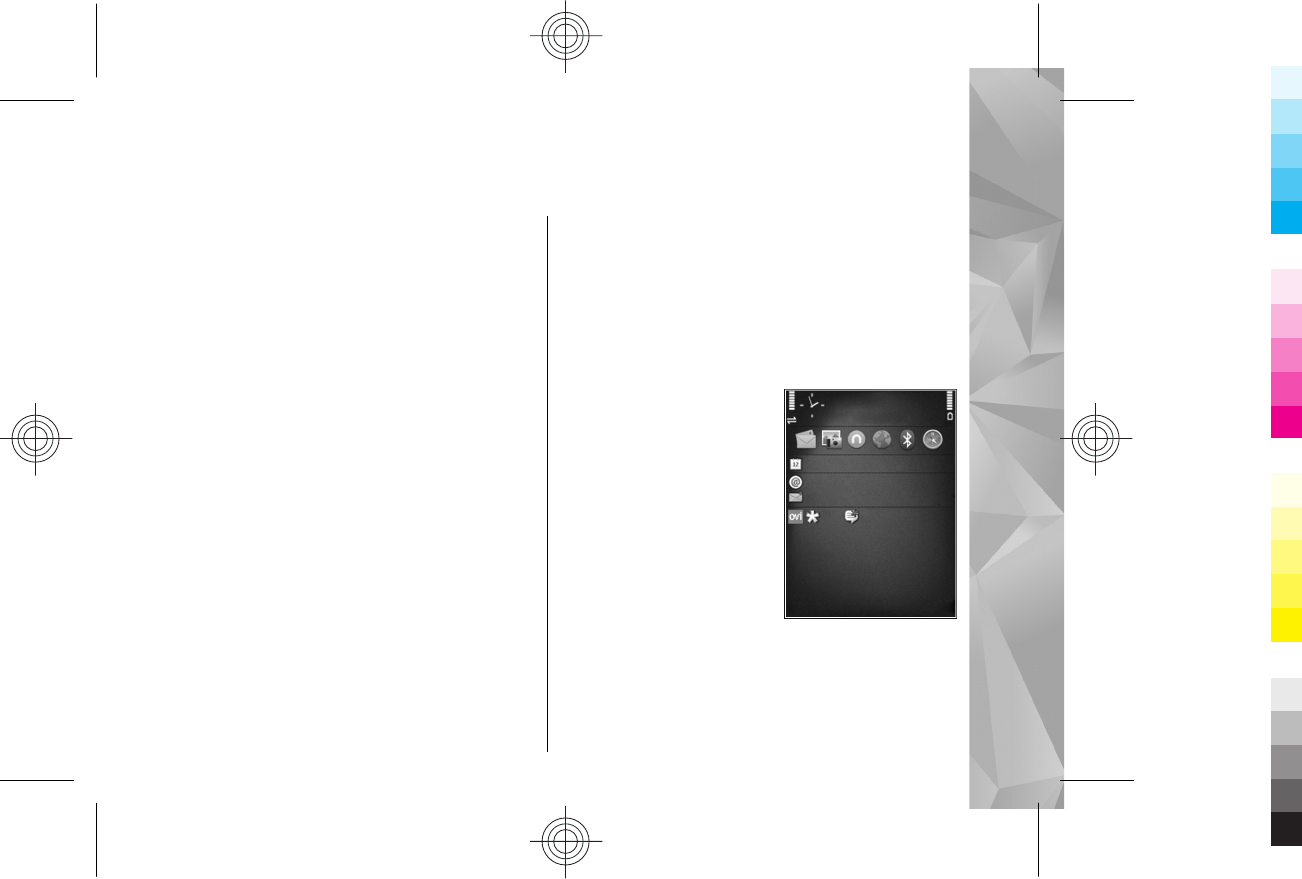
Personalise your device
You can personalise your device by changing the
standby mode, main menu, tones, themes, or font size.
Most of the personalisation options, such as changing
the font size, can be accessed through the device
settings.
For information on Themes and 3-D tones, see the
extended user guide on the product support pages of
the Nokia website.
Set tones
Select Menu > Tools > Settings and General >
Personalisation > Profiles.
To modify a profile, scroll to the profile, and select
Options > Personalise.
To set ringing tones, select Ringing tone and a ringing
tone. To select a bookmark and open a connection to
a web page to download m ore tones, select Download
sounds (network service).
To set other tones, such as key tones and warning
tones, select the desired setting.
If you want the caller’s name to be spoken when your
device rings, select Options > Personalise > Say
caller's name > On. The caller’s name must be found
in the contacts list.
Modify the standby mode
To change the look of the standby mode, select
Menu > Tools > Settings and General >
Personalisation > Standby mode. The active
standby display shows
application shortcuts, and
events from applications such
as calendar, e-mail, and music
player.
To change the selection key
shortcuts or the default
shortcut icons in the active
standby mode, select Tools >
Settings > General >
Personalisation > Standby
mode > Shortcuts.
To change the clock shown in the standby mode, select
Menu > Applications > Clock and Options >
Settings > Clock type.
49
Personalise your device
Cyan
Cyan
Magenta
Magenta
Yellow
Yellow
Black
Black

You can also change the standby mode background
image or what is shown in the power saver in the
device settings.
Tip: To check whether there are applications
running in the background, press and hold the
menu key.To close the applications you do not
use, scroll to an application in the list, and press
C. Leaving applications running in the
background increases the demand on battery
power.
Modify the main menu
To change the main menu view, in the main menu,
select Menu > Tools > Settings and General >
Personalisation > Themes > Menu view. You can
change the main menu to be shown as Grid, List,
Horseshoe, or V-shaped.
To rearrange the main menu, in the main menu, select
Options > Move, Move to folder, or New folder. You
can move applications used less frequently into folders
and place applications that you use more often into the
main menu.
50
Personalise your device
Cyan
Cyan
Magenta
Magenta
Yellow
Yellow
Black
Black
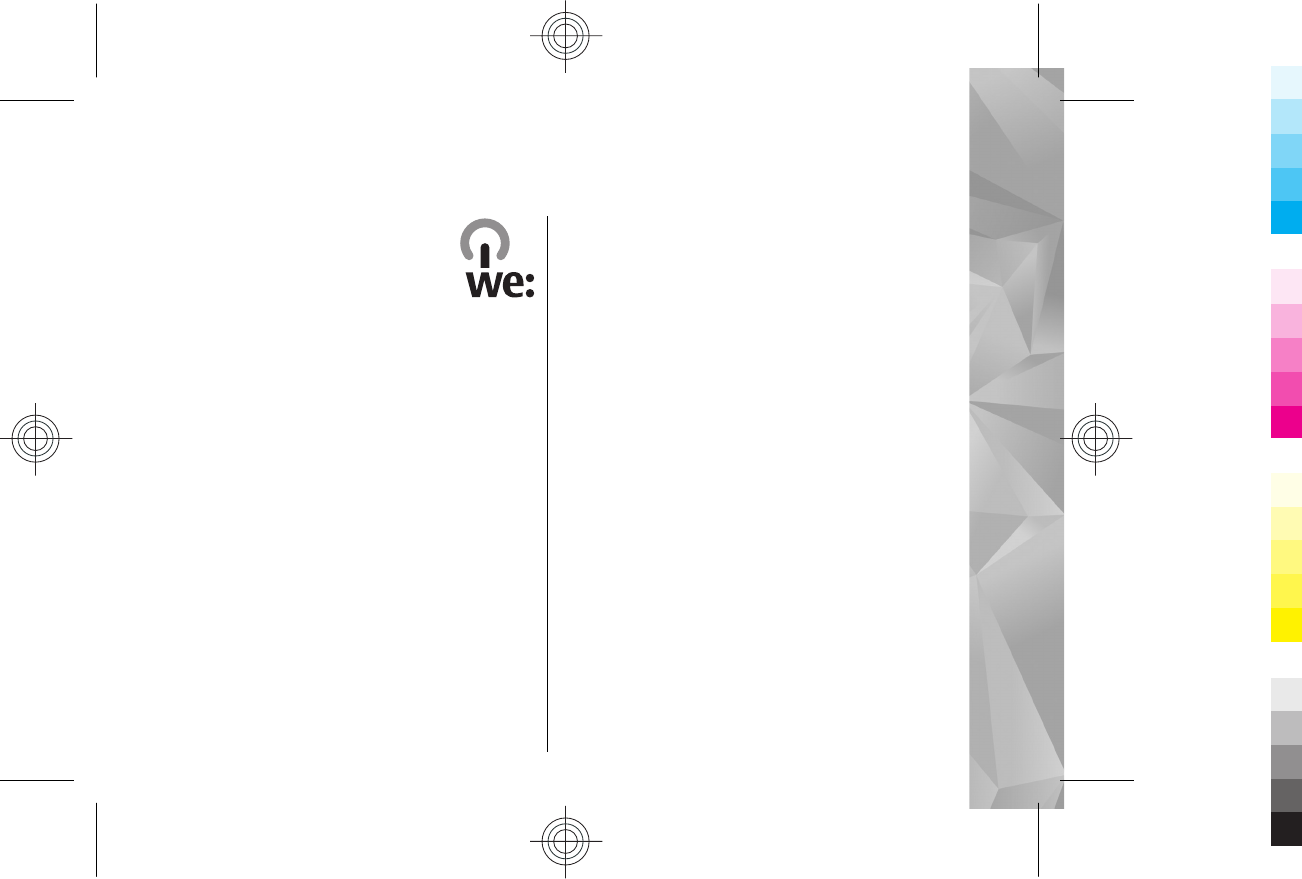
Green tips
Here are tips on how you can contribute to
protecting the environment.
Save energy
When you have fully charged the battery and
disconnected the charger from the device, unplug the
charger from the wall outlet.
You do not need to charge your battery so often if you
do the following:
●Close and disable applications, services, and
connections when not in use.
●Decrease the brightness of the screen.
●Set the device to enter the power saver mode after
the minimum period of inactivity, if available in your
device.
●Disable unnecessary sounds, such as keypad and
ringing tones.
Recycle
Most of the materials in a Nokia phone are recyclable.
Check how to recycle your Nokia products at
www.nokia.com/werecycle, or with a mobile device,
www.nokia.mobi/werecycle.
Recycle packaging and user guides at your local
recycling scheme.
Save paper
This user guide helps you get started with your device.
For more detailed instructions, open the in-device help
(in most applications, select Options > Help). For
further support, see www.nokia.com/support.
Learn more
For more information on the environmental attributes
of your device, see www.nokia.com/ecodeclaration.
51
Green tips
Cyan
Cyan
Magenta
Magenta
Yellow
Yellow
Black
Black
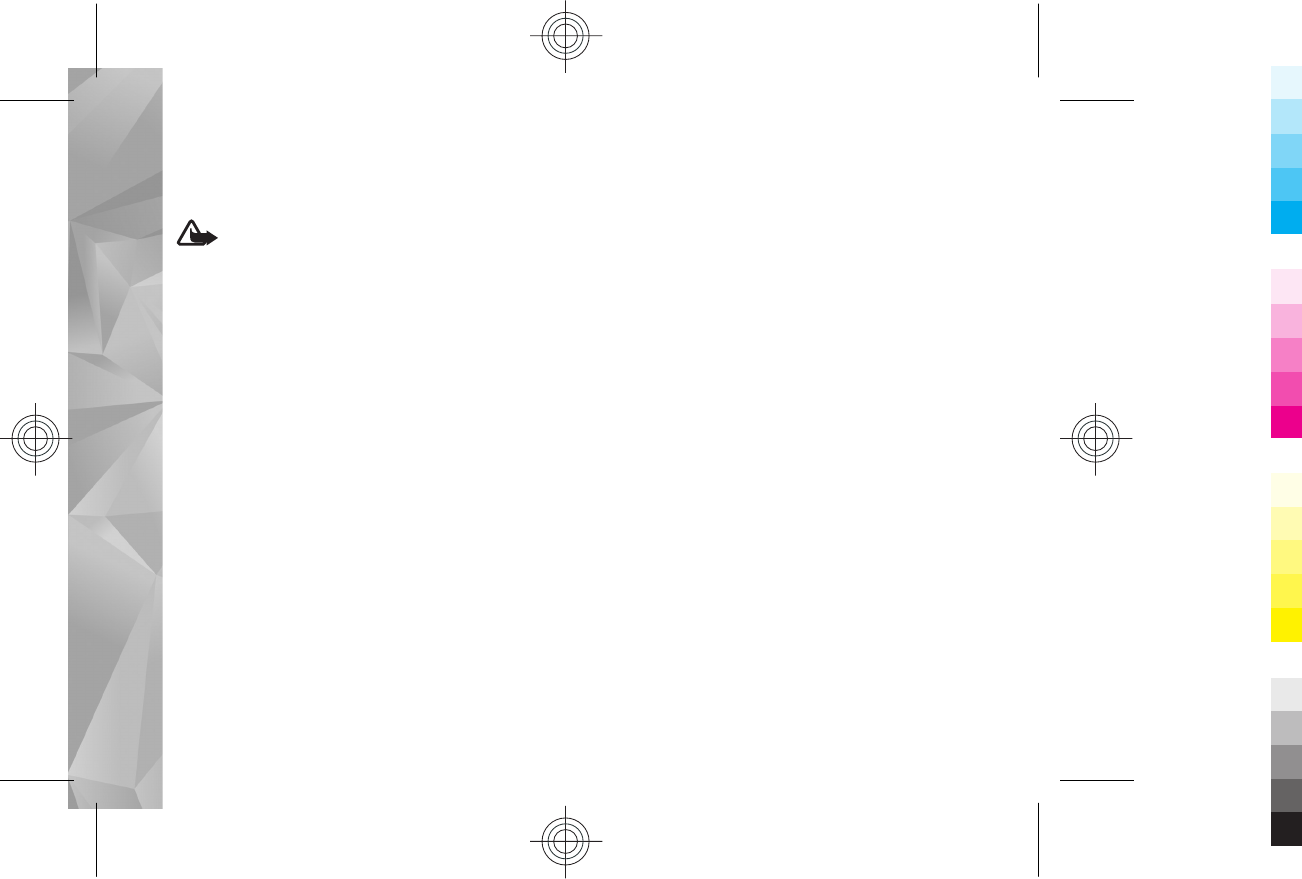
Accessories
Warning: Use only batteries, chargers, and
accessories approved by Nokia for use with this
particular model. The use of any other types may
invalidate any approval or warranty, and may be
dangerous. In particular, use of unapproved chargers
or batteries may present a risk of fire, explosion,
leakage, or other hazard.
For availability of approved accessories, please check
with your dealer. When you disconnect the power cord
of any accessory, grasp and pull the plug, not the cord.
52
Accessories
Cyan
Cyan
Magenta
Magenta
Yellow
Yellow
Black
Black

Battery
Battery and charger
information
Your device is powered by a rechargeable battery. The
battery intended for use with this device is BL-5K. Nokia
may make additional battery models available for this
device. This device is intended for use when supplied
with power from the following chargers: AC-10. The
exact charger model number may vary depending on
the type of plug. The plug variant is identified by one
of the following: E, EB, X, AR, U, A, C, K, or UB.
The battery can be charged and discharged hundreds
of times, but it will eventually wear out. When the talk
and standby times are noticeably shorter than normal,
replace the battery. Use only Nokia approved batteries,
and recharge your battery only with Nokia approved
chargers designated for this device.
If a battery is being used for the first time or if the
battery has not been used for a prolonged period, it
may be necessary to connect the charger, then
disconnect and reconnect it to begin charging the
battery. If the battery is completely discharged, it may
take several minutes before the charging indicator
appears on the display or before any calls can be made.
Safe removal. Always switch the device off and
disconnect the charger before removing the battery.
Proper charging. Unplug the charger from the electrical
plug and the device when not in use. Do not leave a
fully charged battery connected to a charger, since
overcharging may shorten its lifetime. If left unused, a
fully charged battery will lose its charge over time.
Avoid extreme temperatures. Always try to keep the
battery between 15°C and 25°C (59°F and 77°F).
Extreme temperatures reduce the capacity and lifetime
of the battery. A device with a hot or cold battery may
not work temporarily. Battery performance is
particularly limited in temperatures well below
freezing.
Do not short-circuit. Accidental short-circuiting can
occur when a metallic object such as a coin, clip, or pen
causes direct connection of the positive (+) and
negative (-) terminals of the battery. (These look like
metal strips on the battery.) This might happen, for
example, when you carry a spare battery in your pocket
or purse. Short-circuiting the terminals may damage
the battery or the connecting object.
Disposal. Do not dispose of batteries in a fire as they
may explode. Dispose of batteries according to local 53
Battery
Cyan
Cyan
Magenta
Magenta
Yellow
Yellow
Black
Black
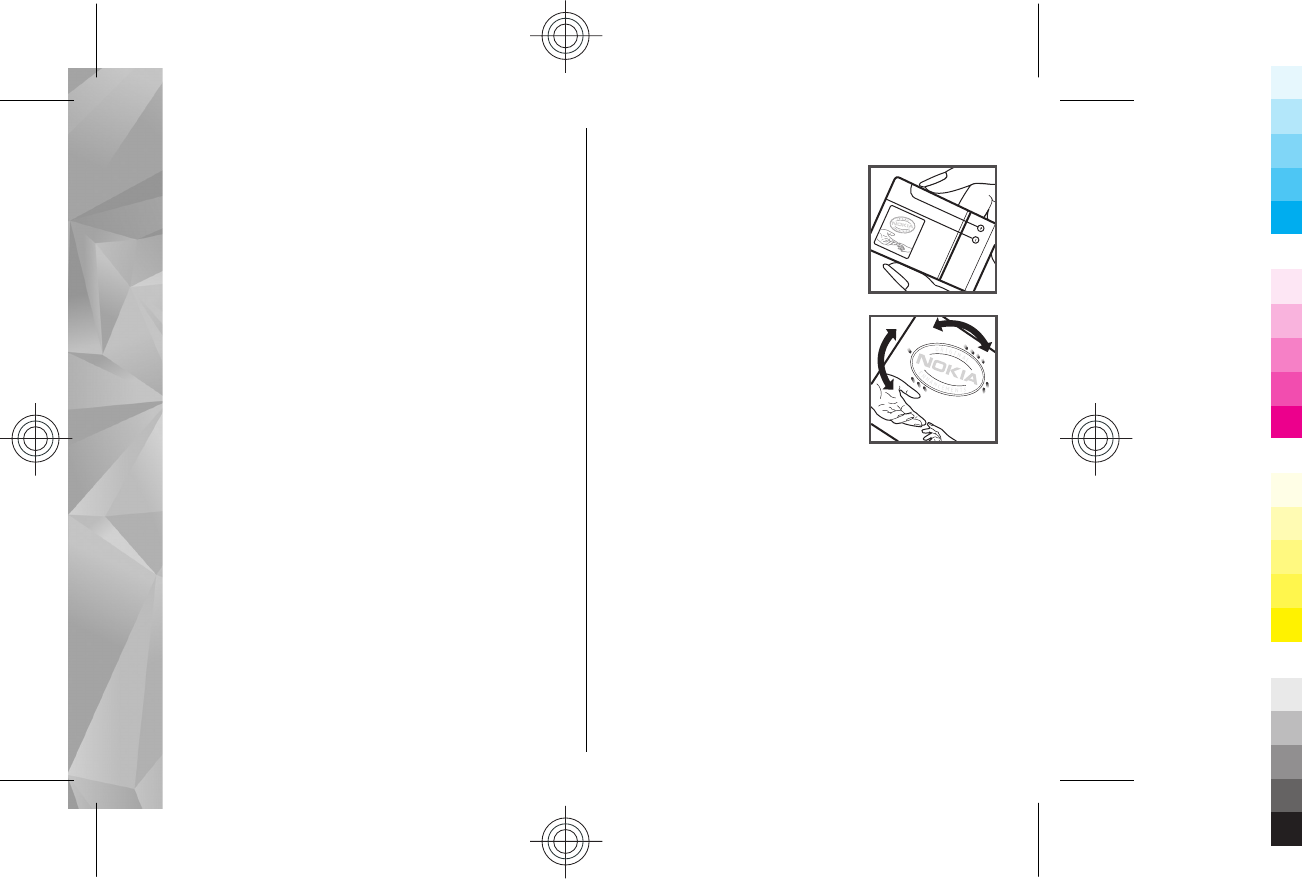
regulations. Please recycle when possible. Do not
dispose as household waste.
Leak. Do not dismantle, cut, open, crush, bend,
puncture, or shred cells or batteries. In the event of a
battery leak, prevent battery liquid contact with skin
or eyes. If this happens, flush the affected areas
immediately with water, or seek medical help.
Damage. Do not modify, remanufacture, attempt to
insert foreign objects into the battery, or immerse or
expose it to water or other liquids. Batteries may
explode if damaged.
Correct use. Use the battery only for its intended
purpose. Improper battery use may result in a fire,
explosion, or other hazard. If the device or battery is
dropped, especially on a hard surface, and you believe
the battery has been damaged, take it to a service
centre for inspection before continuing to use it. Never
use any charger or battery that is damaged. Keep your
battery out of the reach of small children.
Nokia battery authentication
guidelines
Always use original Nokia batteries for your safety. To
check that you are getting an original Nokia battery,
purchase it from a Nokia authorised service centre or
dealer, and inspect the hologram label using the
following steps:
Authenticate hologram
1. When you look at the hologram
on the label, you should see the
Nokia connecting hands symbol
from one angle and the Nokia
Original Enhancements logo
when looking from another
angle.
2. When you angle the hologram
left, right, down and up, you
should see 1, 2, 3 and 4 dots on
each side respectively.
Successful completion of the steps
is not a total assurance of the
authenticity of the battery. If you
cannot confirm authenticity or if
you have any reason to believe that your Nokia battery
with the hologram on the label is not an authentic
Nokia battery, you should refrain from using it, and
take it to the nearest Nokia authorised service centre
or dealer for assistance.
For additional information, refer to the warranty and
reference leaflet included with your Nokia device.
54
Battery
Cyan
Cyan
Magenta
Magenta
Yellow
Yellow
Black
Black

Taking care of your device
Your device is a product of superior design and
craftsmanship and should be treated with care. The
following suggestions will help you protect your
warranty coverage.
●Keep the device dry. Precipitation, humidity, and all
types of liquids or moisture can contain minerals
that will corrode electronic circuits. If your device
does get wet, remove the battery, and allow the
device to dry completely before replacing it.
●Do not use or store the device in dusty, dirty areas.
Its moving parts and electronic components can be
damaged.
●Do not store the device in high or cold temperature.
High temperatures can shorten the life of electronic
devices, damage batteries, and warp or melt certain
plastics. When the device warms to its normal
temperature from a cold temperature, moisture can
form inside the device and damage electronic circuit
boards.
●Do not attempt to open the device other than as
instructed in this guide.
●Do not drop, knock, or shake the device. Rough
handling can break internal circuit boards and fine
mechanics.
●Do not use harsh chemicals, cleaning solvents, or
strong detergents to clean the device. Only use a
soft, clean, dry cloth to clean the surface of the
device.
●Do not paint the device. Paint can clog the moving
parts and prevent proper operation.
●Use only the supplied or an approved replacement
antenna. Unauthorised antennas, modifications, or
attachments could damage the device and may
violate regulations governing radio devices.
●Use chargers indoors.
●Backup all data you want to keep, such as contacts
and calendar notes.
●To reset the device from time to time for optimum
performance, power off the device and remove the
battery.
These suggestions apply equally to your device,
battery, charger, or any accessory.
Recycle
Always return your used electronic products, batteries,
and packaging materials to dedicated collection
points. This way you help prevent uncontrolled waste
55
Taking care of your device
Cyan
Cyan
Magenta
Magenta
Yellow
Yellow
Black
Black

disposal and promote the recycling of materials. Check
product environmental information and how to recycle
your Nokia products at www.nokia.com/werecycle, or
nokia.mobi/werecycle.
56
Taking care of your device
Cyan
Cyan
Magenta
Magenta
Yellow
Yellow
Black
Black

Additional safety information
Small children
Your device and its accessories are not toys. They may
contain small parts. Keep them out of the reach of small
children.
Operating environment
This device meets RF exposure guidelines in the normal
use position at the ear or at least 1.5 centimetres (5/8
inch) away from the body. Any carry case, belt clip, or
holder for body-worn operation should not contain
metal and should position the device the above-stated
distance from your body.
To send data files or messages requires a quality
connection to the network. Data files or messages may
be delayed until such a connection is available. Follow
the separation distance instructions until the
transmission is completed.
Parts of the device are magnetic. Metallic materials
may be attracted to the device. Do not place credit
cards or other magnetic storage media near the device,
because information stored on them may be erased.
Medical devices
Operation of radio transmitting equipment, including
wireless phones, may interfere with the function of
inadequately protected medical devices. Consult a
physician or the manufacturer of the medical device to
determine whether they are adequately shielded from
external RF energy. Switch off your device when
regulations posted instruct you to do so. Hospitals or
health care facilities may use equipment sensitive to
external RF energy.
Implanted medical devices
Manufacturers of medical devices recommend a
minimum separation of 15.3 centimetres (6 inches)
between a wireless device and an implanted medical
device, such as a pacemaker or implanted cardioverter
defibrillator, to avoid potential interference with the
medical device. Persons who have such devices should:
●Always keep the wireless device more than 15.3
centimetres (6 inches) from the medical device.
●Not carry the wireless device in a breast pocket.
●Hold the wireless device to the ear opposite the
medical device. 57
Additional safety information
Cyan
Cyan
Magenta
Magenta
Yellow
Yellow
Black
Black
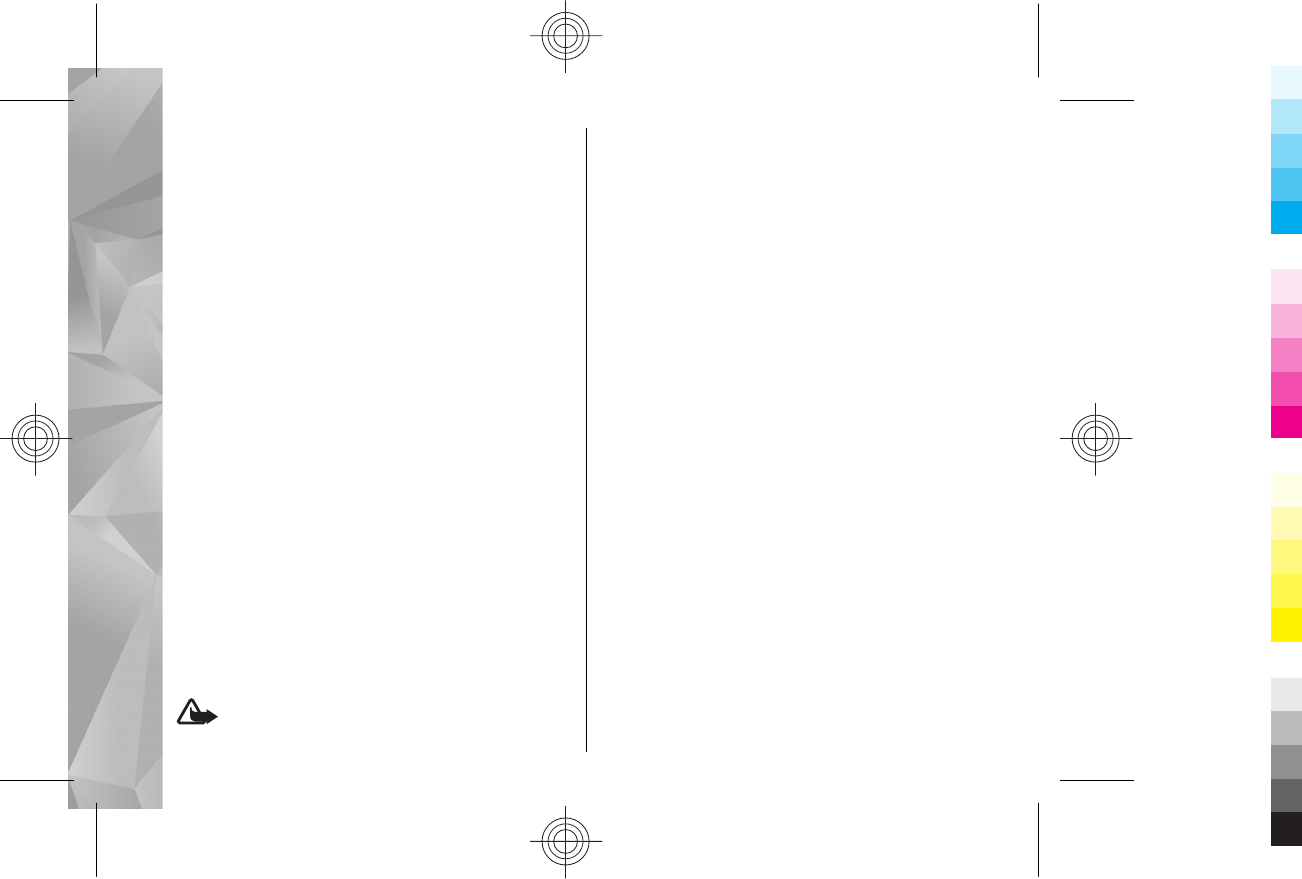
●Turn the wireless device off if there is any reason to
suspect that interference is taking place.
●Follow the manufacturer directions for the
implanted medical device.
If you have any questions about using your wireless
device with an implanted medical device, consult your
health care provider.
Hearing aids
Some digital wireless devices may interfere with some
hearing aids.
Your mobile device model complies with FCC rules
governing hearing aid compatibility. These require a
M3 microphone or higher value. Your device M-value is
shown on the box. A higher M-value generally indicates
that a device model has a lower RF emissions level,
which may improve the likelihood that the device will
operate with certain hearing aids. Some hearing aids
are more immune than others to interference. Please
consult your hearing health professional to determine
whether your hearing aid will work with this device.
More information on accessibility can be found at
www.nokiaaccessibility.com.
Hearing aids
Warning: For hearing aid compatibility, you
must turn off the Bluetooth connectivity.
Your mobile device model complies with FCC rules
governing hearing aid compatibility. These rules
require an M3 microphone or higher value. The M-
value, shown on the device box , refers to lower radio
frequency (RF) emissions. A higher M-value generally
indicates that a device model has a lower RF emissions
level, which may improve the likelihood that the device
will operate with certain hearing aids. Some hearing
aids are more immune than others to interference.
Please consult your hearing health professional to
determine the M-rating of your hearing aid and
whether your hearing aid will work with this device.
More information on accessibility can be found at
www.nokiaaccessibility.com.
Vehicles
RF signals may affect improperly installed or
inadequately shielded electronic systems in motor
vehicles such as electronic fuel injection, electronic
antilock braking, electronic speed control, and air bag
systems. For more information, check with the
manufacturer of your vehicle or its equipment.
Only qualified personnel should service the device or
install the device in a vehicle. Faulty installation or
service may be dangerous and may invalidate your
warranty. Check regularly that all wireless device
equipment in your vehicle is mounted and operating
properly. Do not store or carry flammable liquids,
58
Additional safety information
Cyan
Cyan
Magenta
Magenta
Yellow
Yellow
Black
Black
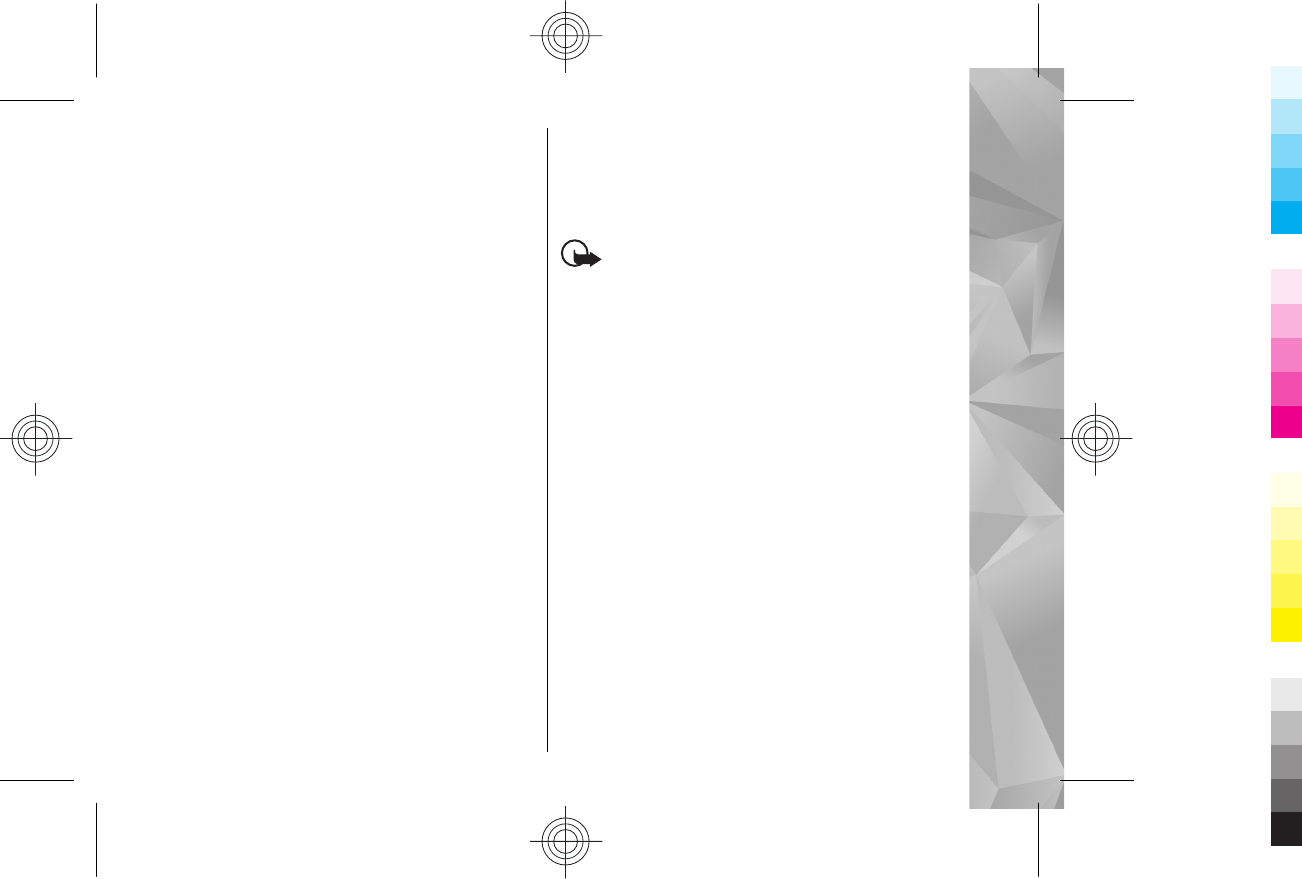
gases, or explosive materials in the same compartment
as the device, its parts, or accessories. Remember that
air bags inflate with great force. Do not place your
device or accessories in the air bag deployment area.
Switch off your device before boarding an aircraft. The
use of wireless teledevices in an aircraft may be
dangerous to the operation of the aircraft and may be
illegal.
Potentially explosive
environments
Switch off your device in any area with a potentially
explosive atmosphere. Obey all posted instructions.
Sparks in such areas could cause an explosion or fire
resulting in bodily injury or death. Switch off the device
at refuelling points such as near gas pumps at service
stations. Observe restrictions in fuel depots, storage,
and distribution areas; chemical plants; or where
blasting operations are in progress. Areas with a
potentially explosive atmosphere are often, but not
always, clearly marked. They include areas where you
would be advised to turn off your vehicle engine, below
deck on boats, chemical transfer or storage facilities
and where the air contains chemicals or particles such
as grain, dust, or metal powders. You should check with
the manufacturers of vehicles using liquefied
petroleum gas (such as propane or butane) to
determine if this device can be safely used in their
vicinity.
Emergency calls
Important: This device operates using radio
signals, wireless networks, landline networks, and
user-programmed functions. If your device supports
voice calls over the internet (internet calls), activate
both the internet calls and the cellular phone. The
device may attempt to make emergency calls over both
the cellular networks and through your internet call
provider if both are activated. Connections in all
conditions cannot be guaranteed. You should never
rely solely on any wireless device for essential
communications like medical emergencies.
To make an emergency call:
1. If the device is not on, switch it on. Check for
adequate signal strength. Depending on your
device, you may also need to complete the
following:
●Insert a SIM card if your device uses one.
●Remove certain call restrictions you have
activated in your device.
●Change your profile from Offline or Flight profile
to an active profile.
59
Additional safety information
Cyan
Cyan
Magenta
Magenta
Yellow
Yellow
Black
Black

2. Press the end key as many times as needed to clear
the display and ready the device for calls.
3. Enter the official emergency number for your
present location. Emergency numbers vary by
location.
4. Press the call key.
When making an emergency call, give all the necessary
information as accurately as possible. Your wireless
device may be the only means of communication at the
scene of an accident. Do not end the call until given
permission to do so.
Certification information (SAR)
This mobile device meets guidelines for exposure
to radio waves.
Your mobile device is a radio transmitter and receiver.
It is designed not to exceed the limits for exposure to
radio waves recommended by international
guidelines. These guidelines were developed by the
independent scientific organisation ICNIRP and include
safety margins designed to assure the protection of all
persons, regardless of age and health.
The exposure guidelines for mobile devices employ a
unit of measurement known as the Specific Absorption
Rate or SAR. The SAR limit stated in the ICNIRP
guidelines is 2.0 watts/kilogram (W/kg) averaged over
10 grams of tissue. Tests for SAR are conducted using
standard operating positions with the device
transmitting at its highest certified power level in all
tested frequency bands. The actual SAR level of an
operating device can be below the maximum value
because the device is designed to use only the power
required to reach the network. That amount changes
depending on a number of factors such as how close
you are to a network base station.
The highest SAR value under the ICNIRP guidelines for
use of the device at the ear is 0.76 W/kg.
Use of device accessories may result in different SAR
values. SAR values may vary depending on national
reporting and testing requirements and the network
band. Additional SAR information may be provided
under product information at www.nokia.com.
Your mobile device is also designed to meet the
requirements for exposure to radio waves established
by the Federal Communications Commission (USA) and
Industry Canada. These requirements set a SAR limit of
1.6 W/kg averaged over one gram of tissue. The
highest SAR value reported under this standard during
product certification for use at the ear is 1.01 W/kg and
when properly worn on the body is 1.00 W/kg.
60
Additional safety information
Cyan
Cyan
Magenta
Magenta
Yellow
Yellow
Black
Black

Index
A
active standby mode 49
active toolbar
in camera 22
in Photos 27
antennas 14
assisted GPS (A-GPS) 38
audio messages 45
B
battery
charging 13
Bluetooth
receiving data 30
security 31
sending data 30
browser 32
browsing pages 32
cache memory 33
toolbar 33
C
cache memory 33
calls 47
camera
flash 24
imaging mode 23
indicators 21
location information 23
video mode 25
charging the battery 13
clock 49
compass 42
connection methods
Bluetooth 30
F
FM transmitter 36
playing songs 37
settings 37
G
general information 16
GPS (global positioning
system) 38
grid view of menus 50
H
headset 13
help application 16
I
internet connection 32
See also
browser
K
keyguard 20
keypad 20
L
list view of menus 50
location information 38
lock code 12
locking keypad 20
M
main menu 50
Maps 41
compass 42
indicators 43
network positioning 41
maps
browsing 42
routes 43
traffic and safety 44
media
music player 35
memory
web cache 33 61
Index
Cyan
Cyan
Magenta
Magenta
Yellow
Yellow
Black
Black

MMS (multimedia message
service) 45
multimedia messages 45
music player 35
N
navigation tools 38
Nokia support information 16
O
offline profile 20
P
photographs
See
camera
photos
toolbar 27
viewing 26
pin code 12
positioning information 38
profiles
offline restrictions 20
R
radio
listening 34
recording video clips 25
ringing tones 49
S
security
Bluetooth 31
sending
using Bluetooth 30
settings
FM transmitter 37
SMS (short message
service) 45
software
updating 18
software updates 17
songs 35
standby mode 49
support resources 16
T
text messages
sending 45
tones 49
toolbar 22
transferring content 19
U
unlocking keypad 20
updates
device software 17
USB charging 13
useful information 16
V
video calls 47
voice calls
See
calls
W
web connection 32
WLAN
MAC address 28
wrist strap 14
Z
zooming 23, 25
62
Index
Cyan
Cyan
Magenta
Magenta
Yellow
Yellow
Black
Black